 05/11/2010 19:08 05/11/2010 19:08 |
|
| | | OFFLINE | | Post: 21.384
Post: 4.020 | Registrato il: 28/08/2005
Registrato il: 20/01/2009 | Administratore | Utente Master | |
|


 See preceding page for earlier posts today, 11/5/10.
See preceding page for earlier posts today, 11/5/10.

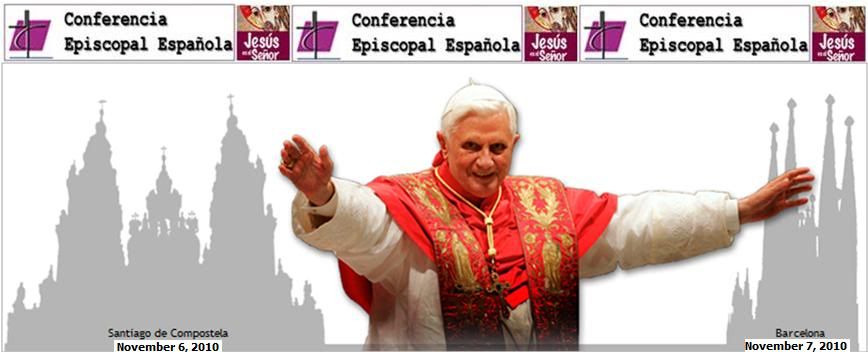 Pilgrims gather to see Pope
Pilgrims gather to see Pope
in Santiago and Barcelona
By Denholm Barnetson

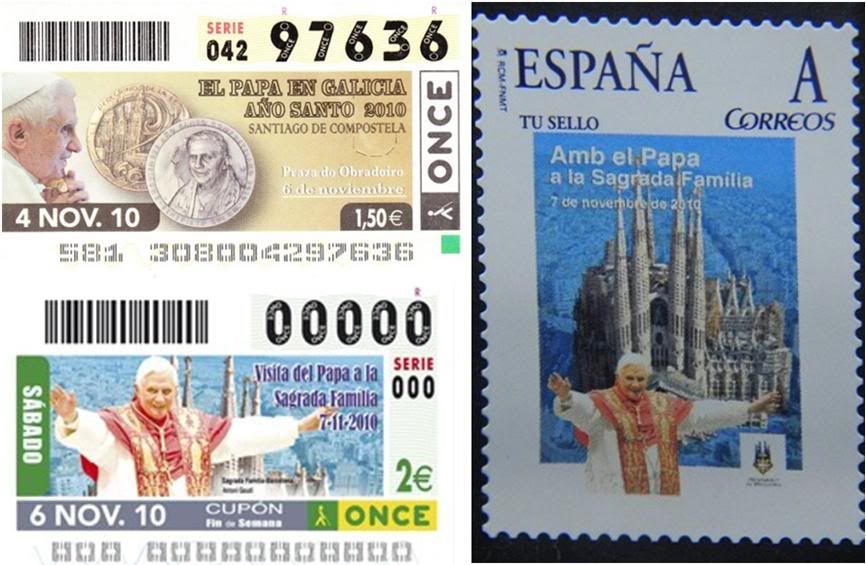 Left, Spain's national lottery ONCE designed its coupons for the Nov. 4 and Nov. 6 draws to serve as souvenirs of the Pope's visit; right, a stamp commemorates the Pope's dedication of Sagrada Familia.
Left, Spain's national lottery ONCE designed its coupons for the Nov. 4 and Nov. 6 draws to serve as souvenirs of the Pope's visit; right, a stamp commemorates the Pope's dedication of Sagrada Familia.
SANTIAGO DE COMPOSTELA, Nov. 5 (AFP) — Pilgrims descended Friday on Spain's holiest city, Santiago de Compostela, to get a glimpse of Pope Benedict XVI, on a mission to reclaim Europe for the Church.

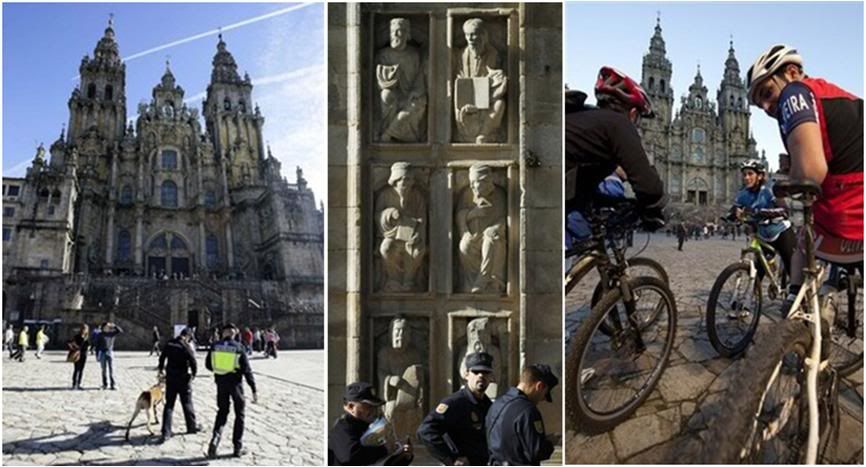
On the eve of the Pope's arrival here for a weekend visit that will also take in Barcelona, planes were packed and the state-owned rail network Renfe added 13,000 extra seats to trains headed to the city.
The Pontiff lands Saturday to pray at the tomb of Saint James the Greater, whose remains were discovered by a hermit in 813 and became a rallying cry for Christian Spain, pinned by the Moors to the northern strip of the peninsula.
The Roman Catholic Church appears again to be under attack on many fronts, and Benedict XVI is seeking a new rallying cry.
The Church was an all-powerful presence in the lives of Spaniards during the dictatorship of General Francisco Franco. But with the arrival of democracy, Spain tore down many of the regime-imposed restrictions on dress-code, behavior and sexual mores.
Under the Socialist Party of Prime Minister Jose Luis Rodriguez Zapatero, the country has gone dramatically further, allowing gay marriage – in five years, 20,000 gay couples have tied the knot – speedier divorce and easier abortions.
Of particular concern to the Church, women can have abortion on demand up to 14 weeks of pregnancy, in case of risk to the life and health of the mother until 22 weeks. Girls of 16 and 17 can get an abortion without their parents' consent if they face a risk of family violence, threats or pressure.
Benedict XVI will warn against "the idea inherited from the French Revolution that in order to be fully human you have to get rid of religious tradition," Celso Morga, undersecretary for the Congregation of the Clergy, said in the Vatican ahead of the visit.
But in eight years the proportion of Spaniards who describe themselves as Roman Catholic has dropped to 73 percent from 80 percent and those attending weekly Mass to 13 percent from 20 percent.
In Santiago, after praying in the sprawling, majestic cathedral, the Pope will embrace the statue of Saint James – a tradition kept by masses of pilgrims who have visited every year since the Middle Ages.
Benedict XVI will then celebrate Mass in the vast Plaza Obradoiro outside the cathedral's main facade in the heart of the medieval city – a UNESCO World Heritage site since 1985 – in front of some 7,000 people.
Shops leading to the cathedral – whose two towers rise to a height of about 75 meters (250 feet) – were already crammed with souvenirs of the Pope's visit. Shopkeepers said commemorative bracelets and stickers, ceramic thimbles and key chains bearing the Pope's image were the most sought-after items.
Yellow-and-white Vatican flags flew from buildings leading into the Plaza Obradoiro, where a massive soundstage was decked out in white behind rows of purple flowers.
"Welcome Holy Father," said one banner.
Portuguese couple Nuno Rocha and Luisa Costa, both 31 and veterinarians, walked 185 kilometers (115 miles) from Barcelos in Portugal. "We timed our visit to coincide with the Pope," said Luisa.
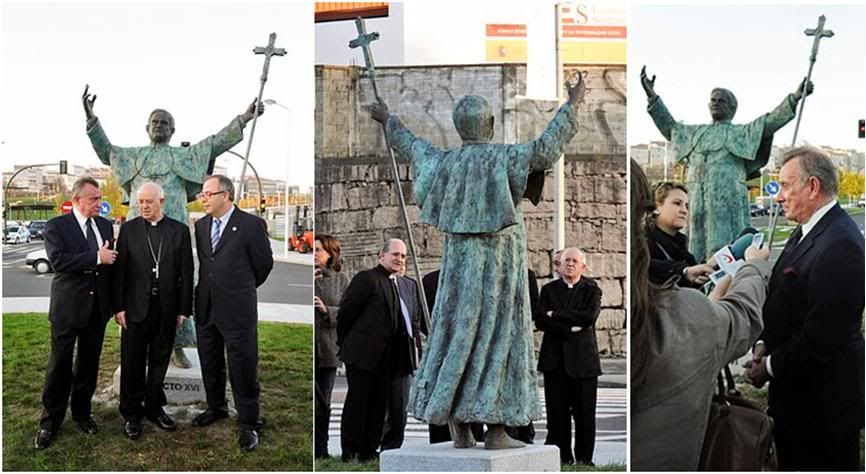
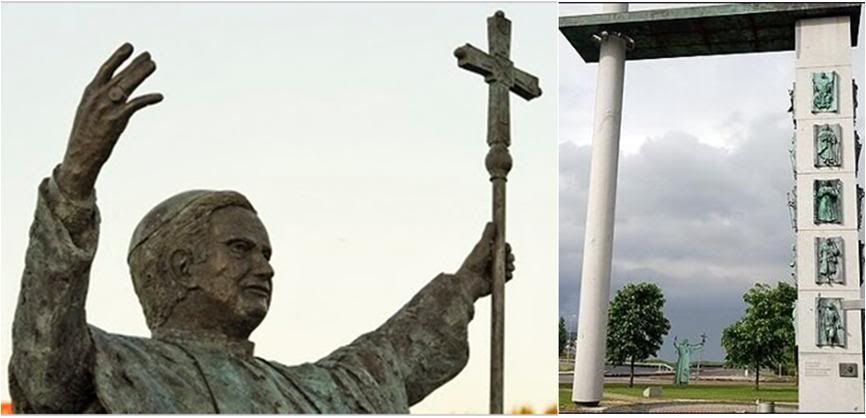 The Pope's statue is placed strategically at the gate to the city along the main route of the Camino de Santiago. Joining the mayor at the unveiling of the state are Mons. Julian Barrio, Archbishop of Santiago, and the sculptor Candido Pazos (in right photo).
The Pope's statue is placed strategically at the gate to the city along the main route of the Camino de Santiago. Joining the mayor at the unveiling of the state are Mons. Julian Barrio, Archbishop of Santiago, and the sculptor Candido Pazos (in right photo).
And Santiago mayor Xose Sanchez Bugallo on Thursday inaugurated a one ton, 98,000-euro (140,000-dollar) bronze statue of Pope Benedict XVI to commemorate his visit which depicts the pontiff with his arms outstretched and carrying a walking stick.
But many in Spain are set against the Pope's message.
When the Pope consecrates the great unfinished masterpiece of Antoni Gaudi, the Sagrada Familia church, in Barcelona on Sunday, hundreds of gays plan to stage a mass kiss-in.
"We are hoping for a crowd of people of the same sex who will kiss each other for two minutes in front of the Pope," said one of the organizers, Marylene Carole. [As if the Pope would stay put for two minutes to accommodate them!]
Protesters against the visit massed Thursday night both in Santiago de Compostela and Barcelona.
In Barcelona, banners held by 2,000 demonstrators declared "Jo no t'espero" ("I'm not waiting for you" in Catalan) carried by a crowd of more than 2,000 people in the Sant-Jaume Square.
"Children welcome, priests go away!," said another placard carried by a child, referring to the child sexual abuse scandals that have rocked the Roman Catholic Church worldwide but largely spared Spain.
 In Barcelona, some 40,000 seats have been placed around Sagrada Familia to accommodate parish delegations from all over Spain to follow the rites on giant TV screens (right).
In Barcelona, some 40,000 seats have been placed around Sagrada Familia to accommodate parish delegations from all over Spain to follow the rites on giant TV screens (right).
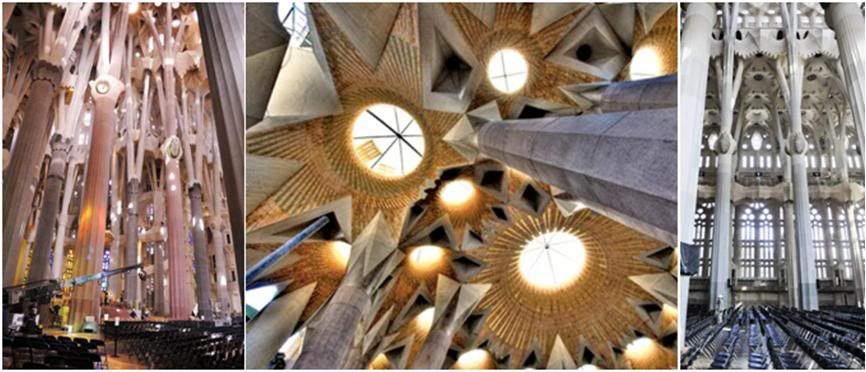 First views of the interior of Sagrada Familia gives an idea of the wealth of original architectural features conceived by Gaudi.
First views of the interior of Sagrada Familia gives an idea of the wealth of original architectural features conceived by Gaudi.
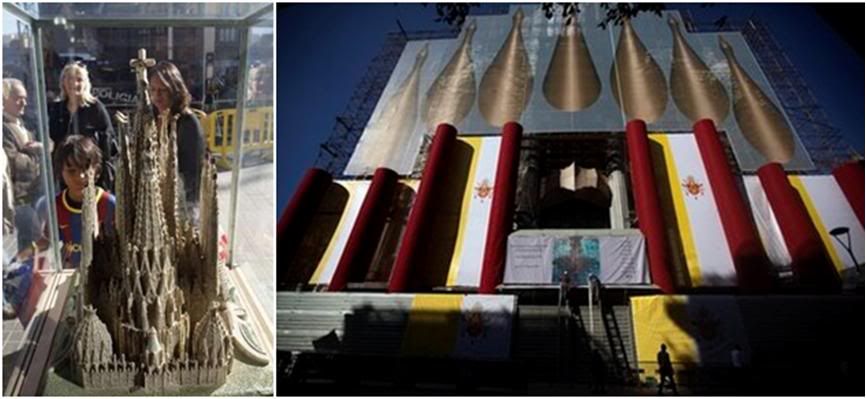 Left, tourists look at a scale model of Sagrada Familia as it will look when completed; right, an unfinished facade is draped for the rites.
Here's an eloquent reflection from Jose Luis Restan
Left, tourists look at a scale model of Sagrada Familia as it will look when completed; right, an unfinished facade is draped for the rites.
Here's an eloquent reflection from Jose Luis Restan:
The Pope's trip
as a gift for Spain
 Translated from
Translated from

04/11/2010
That the Pope comes to our land is no small matter. Not just because of our healthy expectation and sincere affection, or because it is a fervent answer to the rubbish coming from some politicians and media .
Benedict XVI comes at a crossroads in our history as a nation, at a moment of cultural and social fracture, of growing disenchantment and nihilism.
He comes to confirm in faith in a Church which, as he himself said recently of Portugal, has to learn anew how to exist in a society which has suffered profound anthropological and cultural mutation.
As the Successor of Peter, he will arrive in eternal Compostela to enter as one more pilgrim through the Holy Door and prostrate himself at the feet of the Apostle James.
The gesture itself condenses an immense and central significance: We do not invent Christianity. We receive it. Int he apostolic succession, there is an unbroken chain of witnesses who make real today, at this dawn of the 21st century, that first encounter of the disciples with Jesus.
The fisherman from Galilee who came as far as Finisterrae [old term for the Iberian peninsula] - the ends of the earth - moved by the desire to announce the Gospel, greets the Pope theologian from Bavaria. Who would have imagined such a story?
And so this time, the Pope enters Spain through Santiago, demonstrating by gestures and words the rock of apostolic faith, a substancenot rooted in power, influence or even the institutional prestige which the Church has managed to gain in every era, but in the fidelity to Christ that has been sealed by the lives of so many generations of Christians.
The Way itself that Benedict XVI will have symbolically travelled, fulfilling an old personal desire, is an icon of this beautiful Christian history that is also tragic, of the faith that shaped communities, works, arta and culture, and realized in charity. The faith which has also sealed thousands of martyrs in their blood, something which continues in many parts of the world today.
A Pope who has thought and spoken about Europe so much cannot fail to contemplate the expanse off the old Continent from this storied pilgrim goal of Compostela.
No longer is there that Iron Curtain still present in 1982 when John Paul II called from here for a Europe that was united from the Atlantic to the Urals, a Europe which the Slavic Pope dreamed would once again be revitalized by the sap of Christian faith. The Curtain has fallen but the marginalization of God seems like a chill wind blowing across the Continent from east to west and back.
The Church for its part must get on with its own purification, as Benedict XVI often underscores. She has undergone quite a pruning but she has also deepened her awareness of her mission in this new context of near Godlessness, and now nurses the sprouts of an emerging spring.
And Benedict XVI, the theologian Pope who recently paid tribute to Guardini and Peterson, is the man Providence has given us to guide the Church in this phase of her earthly pilgrimage. Anchored and raised in the best Catholic tradition, he has asusmed the challenge of a new mission, of a new dialog no less provocative than that which the Fathers of the Church had to carry on in the first centuries of the Christian era.
He has needed "to show the world new worlds" at a time that demands of Christians prophetic daring, courage and creativity, intelligence and passion.
That is why I believe that the Pope's teaching will not just be a nostalgic evocation of the Christian roots of Europe, bur rather an urgent call to embody in this century's historical mold the irreducible originality of the Christian faith. It is an invitation to take the risk of personal and communitarian witness to Christ.
That is why the visit to Barcelona is also a challenge - that some elements who are clumsily enraged have perceived well. Yet in the midst of this highly secularized city there arise the beautiful needle spires of Sagrada Familia, protecting a space for life, a space for Christian liturgy which celebrates the irruption of Mystery into the daily terrain of mortal men.
To dedicate this temple is also to affirm to one and all that the faith lives and throbs in the fabric of this city, like a lighted hearth that is open to everyone.
It is to show that the faith embodied in the daily biography of millions of men and women has not become prey to the cultural forms of an era nor reined in by the errors of history.
This faith is an impetuous current that sometimes seems to flow underground but which always seeks the light of day, like that torrent of stone that elevates itself towards the sky of Barcelona, sculptured by the fantastic genius of an exemplary Christian, Antonio Gaudi.
Perhaps this basilica dominating an urban jungle, witness to solitude and abandonment, but also of the tireless seeking inherent in the inhabitants of a secularized city, is a reflection of that Court of the Gentiles that Benedict XVI has suggested and underscored on his trip to Prague [said to be Europe's most secularized city].
Perhaps the words - beautiful and precise - of this man, father and brother, will soothe many pains, open up obstinate minds, and launch us into the adventure of mission.
And perhaps not a few, now alienated from the heart of the Church but uneasy in their human seeking, will realize they are our friends, we who have by grace encountered and kept the gift of faith, who wich to share our hope with open hearts.
This will be two gifts in one: a Church that is more free and more daring in reaching a new Finisterrae as St. James did, and a society that is more reconciled among its various affluents, more united in the search for justice and peace.
AP has a comprehensive and objective pre-visit article:
Pope heads to a less Catholic Spain;
protest demos precede the visit
By Daniel Woolls

MADRID, Nov. 5 (AP) —Pope Benedict XVI meets Spain's Facebook generation this weekend -- setting up a clash of values and lifestyles in a once-staunchly Catholic nation that has become one of Europe's most liberal.
The visit is part of a major Vatican push to make increasingly secular Europe re-embrace its Christian roots, but the Pope faces a big challenge in a nation that has undergone an extraordinary social transformation in just the past few years -- with laws allowing gay marriage, fast-track divorce and easier abortions.
These changes are the latest, perhaps most dramatic, chapter in Spain's reinvention after the deeply conservative dictatorship of Gen. Francisco Franco, who died in 1975.
After rigid social and political constraints came an explosion of hedonism and cultural vigor that caused the nation to stray further and further from its religious heritage.
It has all horrified the Vatican, which remembers a not-so-distant age when all public schoolrooms had a picture of Franco and a crucifix mounted on the wall. For many liberal Spaniards, on the other hand, it's the Church's association with the Franco regime that has been a cause for much of the alienation.
"This is without a doubt the least Catholic Spain in history, and demographic data suggest it will continue to become less and less Catholic," sociologist Kerman Calvo said of the country hosting Pope Benedict Saturday for a two-day visit.
Indeed, church attendance is falling steadily and at Mass on Sunday most worshippers have gray hair. Congregations are fast losing young people. And civil ceremonies now outnumber church marriages for the first time.
Against that challenging backdrop, the Pope's tour starts in Santiago de Compostela, a medieval and present-day pilgrimage site whose ornate cathedral is said to hold the remains of St. James the Apostle.
It ends Sunday in Barcelona, where the Pope will consecrate part [ Not just part, but the church itself] of the Sagrada Familia, or Holy Family, church -- Antoni Gaudi's unfinished architectural marvel.
Tensions rose even before the Pope arrived, as riot police swinging truncheons clashed Thursday night with anti-papal protesters in Santiago, some of whom carried red banners reading "I am not waiting for you."
In Barcelona, hundreds of people staged a peaceful nighttime rally against the visit, with banners decrying everything from the cost of hosting the Pope to the pedophile priest scandal that has rocked the Vatican.
Thousands of gays and lesbians plan a kiss-in in Barcelona in the Pope's presence as he leaves the grounds of the city's Gothic 14th-century cathedral on Sunday morning, puckering up en masse to protest against the conservative Pontiff, whose opposition to gay marriage is well known. [It is the opposition of the Church, not justa personal position of the pope!]
Barcelona radio station RAC1 reported Friday that a man walking his dog came across documents this week that included names of hotels where papal delegation members would stay, details on security cameras for the visit and the names, emails and telephone numbers of high-ranking Spanish security authorities.
Spanish authorities downplayed the possibility of a security breach, saying the documents had been reported lost a month ago and that logistical plans to deal with the papal visit had been adjusted.
The pope already visited Spain in 2006 for a rally stressing family values, and plans to come again next summer for a Vatican event called World Youth Day.
The trio of journeys by a man who is 83, albeit robust, show that Spain is very much a part of the Vatican's drive to rekindle Christianity as Europeans turn away from religion as a source of meaning in their lives.
Monsignor Celso Morga, a Spaniard and undersecretary in the Vatican's office for clergy, said the Pope "wants to give a message to Europe, young and old: Let's return to the tomb of the apostle, let's return to the origins of our faith which built Europe."
Faith, the family, and Christian life in Europe are likely to be themes the Pope will touch on during the trip, said the Vatican spokesman, the Rev. Federico Lombardi.
The Pope is visiting Santiago as a pilgrim to celebrate its jubilee year, which falls every time the July 25 feast of St. James -- Spain's patron saint -- comes on a Sunday. The Vatican says the symbol of St. James, a scallop shell, is particularly dear to the Pontiff and is part of his papal coat of arms.
As many as 200,000 people are expected to travel to Santiago de Compostela to see the Pontiff, packing the square outside the cathedral and cobblestone streets of its beautiful old quarter. The Vatican says the Pope's Mass Sunday in Barcelona could draw as many as 100,000 people.
Despite the expected crowds, the influence of the Catholic church in Spain has waned in the decades since Franco died in 1975.
However Javier Elzo, a professor emeritus at Deusto University in the Basque region and expert on the sociology of religion, said he is not ready to declare Catholicism comatose in Spain.
He noted that a poll released in September showed 73 percent of those questioned still consider themselves Catholic, calling that significant even if it is down nearly 10 points since 1994.
"The Catholic brand has not disappeared. Name me a political party, labor union, football team, singer or whatever that has the stated support of 73 percent of the population," Elzo said.
Part of the problem in Spain is that many Catholics want to remain true to their faith but are frustrated with the conservative bent of the Pope and of Spanish bishops named in the times of the late John Paul II, said Mariano Benito, a churchgoing businessman of 46.
"The Church needs to get up to date," Benito said, holding the hand of his small son on a sunny afternoon in Madrid, not far from their parish church. "The Church would have a lot to gain."
Since his election in 2004, Socialist Prime Minister Jose Luis Rodriguez Zapatero has angered the church with his liberal-minded reform program.
The latest plank was officially installed in July with a law that eased abortion legislation dating back to 1985, providing for unrestricted abortion in the first 14 weeks of a pregnancy and letting girls as young as 16 undergo the procedure with no need for parental consent. It's a far cry from the Franco era in which Spanish women traveled to England, France or Holland for abortions.
But now Zapatero is overseeing an economy struggling to overcome recession and a nearly 20 percent jobless rate and trailing the opposition conservatives badly in the polls with elections due in 18 months -- and has apparently shelved plans to enact a law that would force the removal of crucifixes from schools and other public buildings such as hospitals.
The conservative Popular Party has challenged the abortion law in Spain's highest court, and party leader Mariano Rajoy has said that if elected prime minister he would propose erasing the clause allowing 16- and 17-year-olds to abort without parental permission.
Father Olegario Gonzalez de Cardedal, a professor of theology at the University of Salamanca, says Spanish society has changed tremendously over the past 50 years and the Church is working to catch up and find new ways to spread faith now that old models like the family and small local parishes have lessened in importance. He acknowledges the role of the Church has weakened, but insists it remains strong and is trying to adjust.
These days, he wrote in the conservative newspaper ABC, "people get their education from the street, from music, from information society in its diverse and extremely complex channels, from the society of anonymity."
 Poster for Compostela's prayer vigil Friday night before the Pope's visit.
Poster for Compostela's prayer vigil Friday night before the Pope's visit.
[Modificato da TERESA BENEDETTA 06/11/2010 12:34] |
| |
|
| |
 06/11/2010 00:25 06/11/2010 00:25 |
|
| | | OFFLINE | | Post: 21.385
Post: 4.021 | Registrato il: 28/08/2005
Registrato il: 20/01/2009 | Administratore | Utente Master | |
|

 'No alternative to Benedict XVI'
'No alternative to Benedict XVI'
Interview with Sandro Magister
by Eusebio Val
Translated from

November 5, 2010
La Vanguardia, the fourth largest newspaper in Spain, is a Barcelona-based Spanish daily, along with El Periodico de Catalunya. Other Barcelona newspapers are in Catalan.
Sandro Magister is one of the most prestigious and respected of Vatican correspondents. Trained in theology, he has covered Catholic events for the past 40 years. He writes for L'Espresso magazine, and ten years ago, he established the site www.chiesa as a quadrilingual Web platform for his L'Espresso articles.
On the eve of Benedict XVI's visit to Santiago and Barcelona, he analyzes the key points of Benedict XVI's Pontificate.
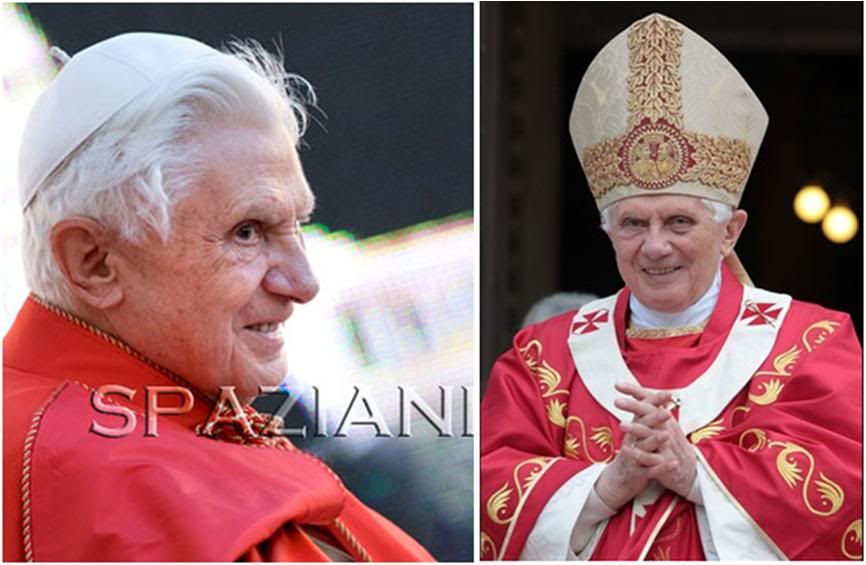 What has surprised you about Benedict XVI?
What has surprised you about Benedict XVI?
The extreme simplicity with which he expresses his vision. This is a Pope who has put everything into his words. Books are an important way for him to reach the public directly, without intermediaries, and to be understood fully. When he delivers his homilies, those who are present [or who watch him on TV] can hear him, but few others, who, even then, may only get it in fragments. But he is certainly a Pope who has known how to drive home his messages.
You would say a success...
I believe so. The surprise is that this intellectual Pope is so much more appreciated and better understood by regular folk than by so-called intellectuals. As far as public opinion is concerned, at least the dominant opinion in the media, he has been subject to intense criticism. But it is not shared by the wider public. As a theologian Pope, one would think he would be difficult to understand, and yet he is much better understood in substance by simple people.
Why do you say that?
Based on some rather obvious evidence. All his trips, for instance, have been preceded by much sharp polemics which strike at him as a person even, and by forecasts that the worst setbacks will happen. But he has always proven such forecasts wrong. From the moment he arrives, he commands attention, respect and a surprising popularity with the public. The visit to the United Kingdom was remarkably successful.
What is the status of Catholicism today?
Not particularly shining. And this Pope knows that very well. There are few persons in the world who have such a direct and analytical perception of the world than Benedict XVI.
Before he became Pope, he worked in the Roman Curia for over two decades, during which he met and spoke with every bishop who came to Rome. Of course, they saw the Pope, but it was mostly just for a formal exchange of greetings.
But before or after seeing the Pope, they called on Cardinal Ratzinger - and he listened to each one of those 5,000 bishops that the Church has around the world [who are required to visit Rome once every five years for these ad limina visits], getting from them information and analysis on their respective dioceses.
That is why he has an extraordinarily precise overview of the general state of the Church in every nation. As Pope, he has used this knowledge well - and it is obvious. [He also continues to meet the visiting bishops individually, before addressing each group altogether.]
But Europe is a fundamental concern for him...
Yes, in large measure. He has always been very aware of the decline of Christianity precisely in the continent where it had been a most extraordinary phenomenon, one that shaped Europe itself. That is why one of his major objectives is to reawaken Europe's sense of its Christian identity, which is now greatly threatened and even lost.
One other element to highlight is that Benedict XVI is convinced that the Church, instead of giving orders, must make institutional changes itself, that her members must be re-educated, that Catholics must reconstruct their own culture. And he knows that cannot be done quickly, much less by command. But that it can come about by insistent, continuing and methodical teaching, particularly directed to the clergy.
He is convinced that the Catholic clergy should undergo some kind of spiritual rebirth. That is why he keeps talking about purification. And why he sees the problem with pedophile priests as proof that the Church urgently needs this purification and spiritual renewal.
He is 83 now. Is he a transitional Pope?
I've never seen him as a transitional Pope. By the very way he was elected, he cannot be considered transitional. He was elected on the fourth ballot, having had the most votes from the start - that is a Pope who was wanted by those who who elected him, a Pope who is loved for who he is and what he represents. Not a transitional Pope at all.
But he is not young...
No, but curiously, in spite of his advanced age, there have been no elucubrations in the world media about a successor. There have been no bets placed on papabili. No one behaves as though the Church were on the verge of another conclave! And that is due in large part to the fact that he is seen to be in good health. And the incredible regularity of his routine - that's not a Pope who is about to leave the scene.
Do you think the next Pope will follow his line?
I believe so, yes. Because in the Church today, there is no alternative way - nor are there competent persons who could embody such an alternative. The same way there was really no alternative when he was elected. The opposing faction was incredibly weak. If one could consider the liberal progressive wing associated with Cardinal Carlo maria Martini as the alternative, well, as far as we know, he got less than 10 votes at the Conclave.
There was no alternative 'plan' for the Church then, and much less today! Yes, Benedict XVI has met resistances, but they have been disordered and confused, and they do not represent a coherent plan. There is no Plan B for the Church today - only that which Benedict XVI is carrying out, with all the strength he has.
It must not be forgotten that he can have many more years before him, just like Leo XIII who was also elected at an advanced age but lived to be 92, and had a long Pontificate that was rich with initiatives.
PAPA RATZINGER:
Father of the Church
by CARDINAL JULIAN HERRANZ
Translated from

November 5, 2010
Spanish Cardinal Herranz (born 1930) is the highest ranking Opus Dei prelate in the Catholic church and was one of the canon law experts in John Paul II's Pontificate. Until 2007, when he retired, he was president of the Pontifical Council for Legislative Texts. ABC is Spain's third largest newspaper of record, after El Pais and El Mundo, and is generally conservative compared to the ultra-liberal El Pais.
Benedict XVI comes as a pilgrim to Santiago de Compostela. And on this trip, he also manifests his special affinity with the Apostle: "From James the Greater, we can learn many things: the promptness with which he responded to the call of the Lord, even when he asks us to abandon the 'boat' of our human certainties, his enthusiasm in following Christ through the paths which he shows us, his readiness to bear witness with such valor" (Benedict XVI, 5/21/06)
These are apostolic traits that summarize quite well the pastoral ministry of Joseph Ratzinger, this modern Father of the Church - let me dare to call him this.
I make the analogy because the present circumstances of the Church and the world, and the characteristics of Benedict XVI as a person and of his work, make him closely akin, in both the intellectual and pastoral dimensions, to the early Fathers of the Church (Basil, Athanasius, Augustine, to name a few) who, by their rich teachings and governance of the Church interpreted the signs of their times with special clearsightedness, and contributed decisively to saving the faith and its orthodoxy, the harmony between reason and faith, and the values of civilization.
In this sense, I would like to comment on three great pastoral challenges to the Pontificate of Benedict XVI:
The first has to do with the interpretation of the Second Vatican Council and the so-called post-Conciliar crisis. There was a period of dramatic confusion in wide sectors of the Church:
- Tendencies to 'update' theology by marginalizing the divinity of Christ;
- A temporal interpretation of the Gospel message, reducing the mission of the Church to socio-political ends;
- A secular reading of the priestly identity and mission, along with its lifestyle, leading to a serious hemorrhaging by defections;
- Liturgical experimentation which was often anarchic and desacralization, etc.
On the other hand, some groups have clung to a reductive traditionalism that has included opposition to Rome.
Joseph Ratzinger has opposed those two extreme positions, first as Cardinal, particularly in 1985 with the famous Rapporta sulla fede [published in English as The Ratzinger Report], which has been rightly called 'a historically prophetic denunciation', and now as Pope, who jealously guards the unity of the faith and communion in the Church.
"No one can deny," he told us in the Roman Curia around Christmas 2005, "that in vast areas of the Church, the implementation of the Council has been somewhat difficult", and after citing words by St. Basil after the Council of Nicaea, he specified: "On the one hand, there is an interpretation that I would call the hermeneutic of discontinuity and rupture'... On the other, there is the hermeneutic of reform, of renewal in continuity..."
But the clarity with which Joseph Ratzinger faced another great challenge was not so much after St. Basil, the monk-bishop of Cappadocia, but after St. Augustine, who with his City of God disengaged the destiny of Christianity from the politico-cultural fate of the decadent Roman Empire.
It was on April 18, 2005. In his homily at the Mass that preceded the Conclave, in referring to the cultural and moral degradation of wide sectors of society, he told us cardinals:
How many winds of doctrine have we known in recent decades, how many ideological currents..., how many ways of thinking... Today, having a clear faith based on the Creed of the Church is often labeled as fundamentalism. Whereas relativism, that is, letting oneself be "tossed here and there, carried about by every wind of doctrine", seems the only attitude that can cope with modern times. We are building a dictatorship of relativism that does not recognize anything as definitive and whose ultimate goal consists solely of one's own ego and desires.
Thus, while John Paul II had specifically opposed the 'totalitarian utopia' of justice without freedom that characterized Communism and Nazism, Benedict XVI opposes the 'relativist utopia' of freedom without truth, namely, without values and objective truths to protect.
In the socio-political context, relativism is a sign of cultural and anthropological decadence, since a democracy without values, which relativism causes to lose its own identity, is a decadent democracy, which could easily degenerate into open or insidious totalitarianism" (Address, 10/1/2005).
But Papa Ratzinger, like the early Fathers of the Church, is not a man who simply points out errors or dangers: he teaches that Christianity is the encounter with the Word incarnate, with Christ, who reveals to man not just the mystery of God also that of man: the supreme dignity of his nature and eternal destiny.
Thus, without 'doing politics', he proposes a society in which the harmony of faith and reason is the measure of true humanism, and where a healthy concept of secularity - which respects the dignity of man and his inalienable rights, including freedom of religion and of conscience - can overcome secular fundamentalism, which is hostile to the familial, social and cultural relevance of Christianity, and of religion in general.
From secularist fundamentalism to Islamic fundamentalism, which is the third great challenge that Benedict XVI has faced in a dialogal and constructive way - in the famous lecture at the University of Regensburg in September 2006, his trip to Turkey afterwards, and most recently, in the Bishops' Synodal Assembly on the Middle East.
His repeated affirmation that "not to act according to reason is contrary to the nature of God" and that "every religion must respect the dignity of man" helps to understand that the act of faith has to be a free and reasoned act, never imposed by violence - not by the physical violence of terrorism nor by the violence of civil laws that do not respect freedom of worship and of conscience.
Ultimately, it is about the encounter "between faith and reason, between illustration and religion", and about entering into a dialog among Christians and Muslims that starts from mutual respect of personal dignity, which helps to promote 'common values like peace and human life; and opposing the dictatorship of positivist reason which excludes God from the life of the community".
May the Apostle St. James intercede for these intentions!
`
The folowing essay gives us, among other things, more information about Joseph Ratzinger's previous trips to Spain:
The German Pope who loves Spain and
is concerned that she has become secular
by Jose Manuel Vidal
Translated from

Nov. 4, 2010
Benedict XVI has a 'special preference' for Spain, says the Vatican spokesman, Fr. Federico Lombardi, a man not given to hyperbole. And when he says 'special preference', he means that Papa Ratzinger is fascinated by Spain - for what she was (hammer of heretics and evangelizer of the New World), for what she is (the laboratory for secularism), and for what she can be in the immediate future (a trial ground for the new evangelization of once Christian nations).
Olegario González de Cardedal is one of the few Spanish theologians who can claim to be a friend of the Pope - a friendship that was forged in academic halls and the rarefied heights of theological study.
Oelgario was the first to invite him to Spain back then, and was his guide in Avila and Salamanca, and in Ibiza where they visited with another former professor from the Salamanca, today the Bishop of Almeria, Adolfo González Montes.
Professor Gonzalez recalls: "Joseph Ratzinger came to Spain for the first time in 1989, then again in 1993, to lecture at the theology courses I was giving in the University of Madrid. He has had the misfortune of being 'captured' by by some who point to him as the representative of the orthodoxy they espouse, and those who began and obstinately perpetrated the caricature of the Panzerkardinal, the Inquisitor alone in his ivory tower, scourge of liberation theology and prime mover of the Church's war against modernity".
From El Escorial [that formidable Renaissance fortress-palace-monastery of Charles V and Phillip II, where the University of Madrid - known locally as the Complutense - holds its summer courses], he visited the Valle de los Caidos [Valley of the Fallen, the memorial complex built by Franco to honor those who died in the Spanish Civil War], with Gustavo Villapalos, who was then the rector of the Complutense.
Returning to Madrid. Villapalos says Rtazinger told him that he found the monastery at the Valle de los Caidos more interesting than the one at El Escorial and even most of those had visited elsewhere in Europe, because of "the originality of its concept and its spirituality".
On the other hand, in seven trips to Spain before this weekend, he had never been to Barcelona or Compostela. And yet, his personal coat of arms, as cardinal and as Pope, prominently features a golden scallop, symbol of the pilgrim as well as a traditional symbol of the Chistian faith.
In 1998, he was given a doctorate honoris causa by the University of Navarra , and he availed of that visit to Pamplona to present his memoir Mi vida at a news conference where he said that "one does not dialog with crime" and spoke about the need for a new awareness to combat terrorism from the point of view of Christian humanism.
Twice he came to Murcia. In 2002, to preside at Holy Mass in Caravaca de la Cruz, inaugurating the preparatory year to the Jubilee of teh Holy Cross, and to close a Christological Congress organized by the Universidad Catolica de San Antonio of Murcia.
At that time, he said at a news conference that "a united Europe should not only be an economic and political entity, but one that has spiritual foundations", and that t"he Christian faith continues to be the criterion for the fundamental values of the continent, which in its turn had given rise to those of other continents".
Two years after, he returned to Murcia give a lecture at the university - and a few months later, he was elected Pope.
But more than just the Spanish landscape and history, what this Pope knows best about our land are our great mystics and saints. Benedict XVI is a consummate expert on Saints Augustine and Bonaventure, who were the subjects of his academic dissertations, but he is also a profound admirer of the Spanish mystics. Especially St. Teresa of Avila and St. John of the Cross, whose works constitute supreme spiritual nourishment for him. [NB: John Paul II was also a special devotee of John of the Cross, who was the subject of his doctoral dissertation.] Perhaps because his life as a Catholic intellectual has always been guided by spirituality and truth. Indeed, his episcopal motto is 'Cooperators in the truth'.
And so, Spain is a land known and loved by this Pope. And a nation that is of great concern to him particularly. It is not by chance that His Holiness is travelling to Compostela and Barcelona on his second trip to Spain since he became Pope.
In 2006, he visited Valencia for the Fifth World Encounter of Families. And in August next year, he will visit Madrid to preside at World Youth Day. Which makes three visits in five years. More than he has made to his native land where he has been twice.
Our ambassador to the Holy See, Francisco Vazquesz, rightly noted: "We have the honor of being the country most visited by our present Pope, which is a privilege as well as a sign of special attention".
And basically, a sign of great concern. Because Catholic Spain of the sledgehammer faith and spiritual reservoir of the West for centuries has become secularized at great strides imposed by law in recent years.
The numbers speak for themselves and are implacable. At present, only 72% of Spaniards identify themselves as Catholic compared to 80% in 2002, but only 14% go to Mass (down from 20%). Moreover, half of those below 25 have turned their backs on the Church, which is also losing its grip on the rites of passage - the 'social sacraments' of marriage and baptism. In 2009, for the first time, there were more civil marriages in Spain than Church marriages.
But, as always, the data can be read two ways. Against the negative figgures, the bishops choose to look at the more positive picture - which is that every Sunday, some 8-10 million Catholics go to Mass, a total of militant faithful that far outnumbers the combined membership of the country's various political parties, labor unions and members of football clubs!
What most preoccupies Rome is not the low proportion of observant Catholics but the inexorable drift of a nation which just a decade ago was, with Italy, Ireland and Poland, the most fundamentally Christian of the European nations, and which has now become the militant vanguard of secularism.
In the words of tbe Pope's minister of culture, Cardinal-designate Gianfranco Ravasi: "Before this, when one spoke of a secular nation par excellence, one meant France, but for some time now, Spain has become number-1 in the ranking". Even if he did not say so, he obviously meant the Spain of Jose Luis Zapatero [who came to power in 2002].
In the eyes of the Church, the leader of Spain's Socialist government has converted Spain into the symbol of secular Europe and of the continent's moral degradation. In a worsening situation, which, in the words of Cardinal Rouco Varela, Archbishop of Madrid and president of the Spanish bishops' conference, "has seen five years now of the new law on matrimony inscribed in the Civil Code, which no longer recognizes and protects matrimony as the traditional union of man and woman, and which has seen this year the approval of a new law that represents a serious step back in the protection of the unborn" [legalized abortion on demand at any stage of pregnancy].
And the Archbishop of Barcelona, Cardinal Lluis Martínez Sistach, drives home the point, saying that "the situation of Spain is a cause of pain to the Holy Father" with the new abortion law on top of legalizing same-sex marriage.
The Vatican fears the contagion of Zapatero's political moves, especially on the nations of Latin America, where various nations have already approved same-sex marriage and many are preparing to decriminalize abortion.
Although relations have been smoothed out between Spain and the Vatican lately, thanks to the work of Deputy Prime Minister María Teresa Fernández de la Vega, the Foreign Minister until recently, Miguel Ángel Moratinos, and the Amassasdor to teh Holy See, Francisco Vázquez, the battleground remains the same.
And certainly, the Pope will address this basic conflict in his messages during the brief visit. As always, proposing rather than imposing, Benedict XVI will affirm loud and clear the Church's defense of the family and of life from conception to natural death - the themes, as Fr. Lombardi underscored, "that most keeps us apart".
That is the theme of Papa Ratzinger's crusade, along with the recovery of Europe's Chrtistian roots. One of his priorities is calm constructive dialog with those who have lost the faith or who have abandoned it. That is to say, with those who daily add to the ranks of the indifferent.
Given the opportunity to be heard, he can certainly convince them of the benefits faith can bring to the daily personal, social and cultural life of the nations of Europe, because as he likes to day, "God gives everything and takes away nothing". On the contrary, the modern world loses much in its silent apostasy, living 'as if God did not exist".
[Modificato da TERESA BENEDETTA 06/11/2010 11:43] |
| |
 06/11/2010 11:59 06/11/2010 11:59 |
|
| | | OFFLINE | | Post: 21.386
Post: 4.022 | Registrato il: 28/08/2005
Registrato il: 20/01/2009 | Administratore | Utente Master | |
|
[Modificato da TERESA BENEDETTA 06/11/2010 12:35] |
| |
 06/11/2010 12:07 06/11/2010 12:07 |
|
| | | OFFLINE | | Post: 21.387
Post: 4.023 | Registrato il: 28/08/2005
Registrato il: 20/01/2009 | Administratore | Utente Master | |
|




APOSTOLIC JOURNEY OF
HIS HOLINESS BENEDICT XVI
to SANTIAGO DE COMPOSTELA
and BARCELONA, SPAIN
November 6-7, 2010
P R O G R A M
Saturday, Nov. 6
ROME
08.30 Depart from Fiumicino airport for Santiago de Compostela
SANTIAGO DE COMPOSTELA

11.30 Arrive at the International Airport of Santiago
WELCOME CEREMONY
-Address by the Holy Father.
PRIVATE MEETING WITH THEIR ROYAL HIGHNESSES, THE CROWN PRINCE OF SPAIN and the PRINCESS OF ASTURIAS
Sala de Autoridades, International Airport
13.00 VISIT TO THE CATHEDRAL OF SANTIAGO DE COMPOSTELA
- Greeting by the Holy Father
13.45 Lunch with the Spanish Cardinals, members of the Executive Committee of
the Spanish bishops Conference, and the papal delegation
Archbishop's Residence
16.30 HOLY MASS on the occasion of teh Ano Jacobeo (Jubilee Year of St. James)
Plaza del Obradoiro
- Homily of the Holy Father
19.15 Departure from the International Airport oc Santiago for Barcelona
BARCELONA

20.15 Arrival at Barcelona International Airport.
The Holy Father will spend the night at the ARchbishop's Residence,
Sunday, November 7
BARCELONA
09.30 PRIVATE MEETING WITH THEIR MAJESTIES THE KING AND QUEEN OF SPAIN
Sala Museala, Templo Expiatorio de la Sagrada Familia
10.00 HOLY MASS and Dedication of the Church of Sagrada Familia and its altar
- Homily by theoly Father
- ANGELUS led by the Holy Father
- Remarks by teh Holy Father
13.00 Lunch with Cardinals and Bishops and the papal delegation
Archbishop's Residence
16.30 Farewell from the Archbishop's Residence
17.15 VISIT TO THE "OBRA BENEFICO-SOCIAL NEN DÉU"
- Greeting by the Holy Father
18.30 FAREWELL CEREMONY, International Airport of Barcelona
- Address by the Holy Father
19.15 Departure from the Itnernational Airport of Barcelona for Rome
ROME
20.55 Arrival at Ciampino Airport
Spain is one hour ahead of Italian time.
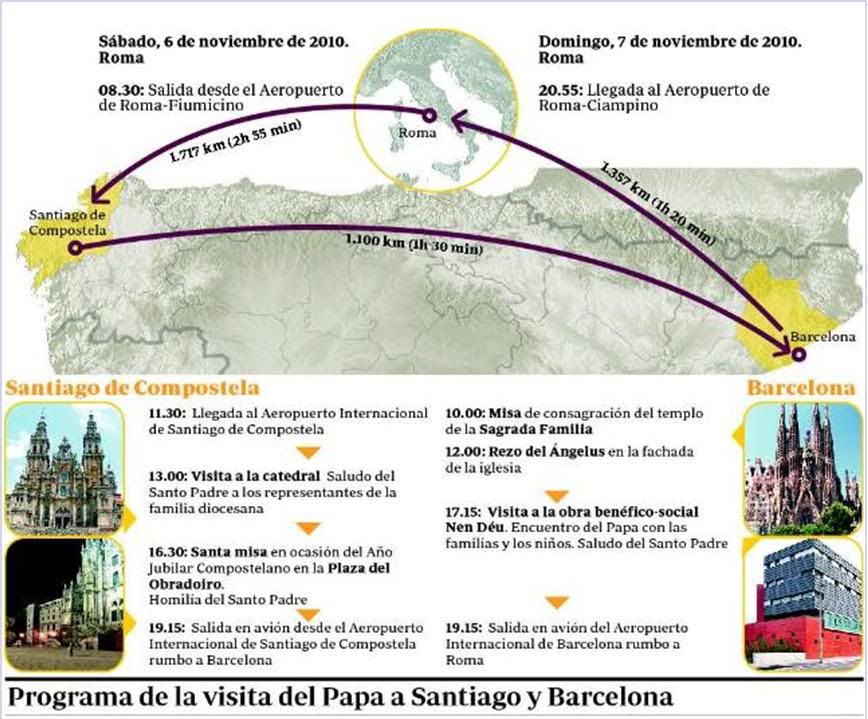 The Holy Father has arrived in Santiago...
The Holy Father has arrived in Santiago...
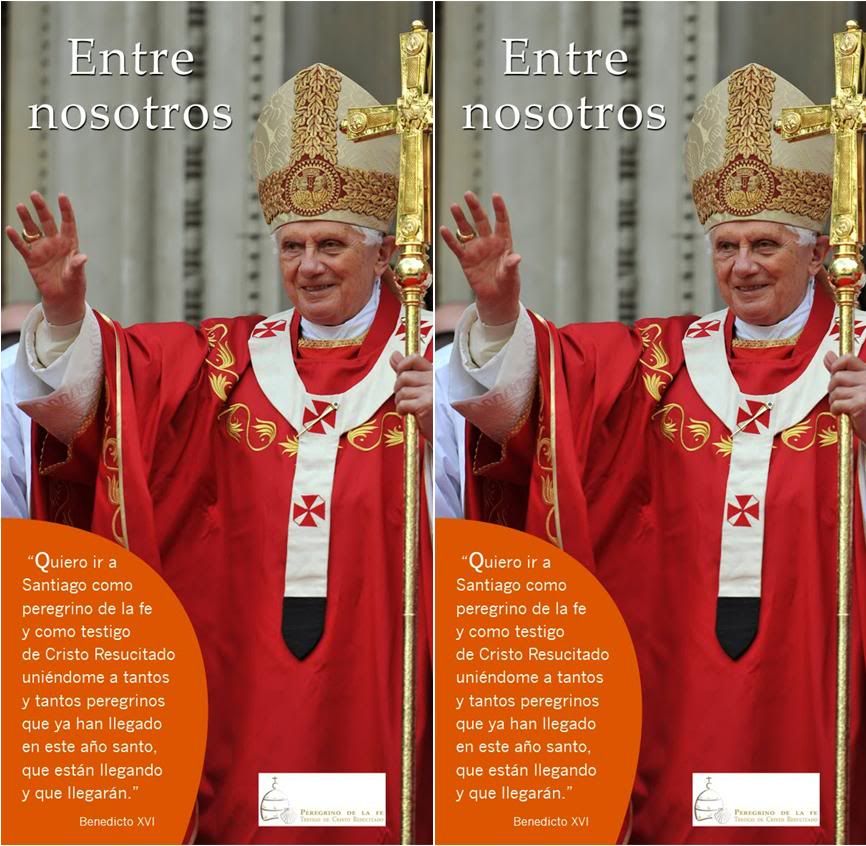 A live blog in Santiago notes the arrival with this poster entitled 'HE IS WITH US'.
A live blog in Santiago notes the arrival with this poster entitled 'HE IS WITH US'.
[Modificato da TERESA BENEDETTA 06/11/2010 13:12] |
| |
 06/11/2010 12:36 06/11/2010 12:36 |
|
| | | OFFLINE | | Post: 21.388
Post: 4.024 | Registrato il: 28/08/2005
Registrato il: 20/01/2009 | Administratore | Utente Master | |
|
 Pope blasts Spain's
Pope blasts Spain's
'aggressive' anti-Church ways
By NICOLE WINFIELD

SANTIAGO DE COMPOSTELA, Spain, Nov. 6 (AP) — Pope Benedict XVI has criticized what he calls an "aggressive" anti-Church sentiment that he says is flourishing in Spain.
The Pope arrived Saturday on a two-day visit to rekindle the faith in a key Western nation.
Benedict said the anti-clericalism being felt today in Spain harks back to the 1930s, when the church suffered a wave of violence and ill feeling as Spain lurched from an unstable democracy to civil war.
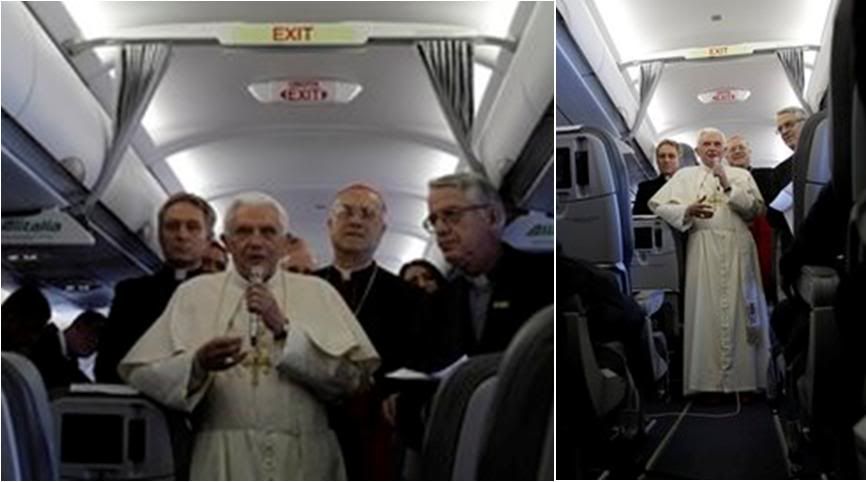
Speaking Saturday to journalists en route to Santiago di Compostela, Benedict said he had created a new Vatican office to fight such secular trends worldwide. He said Spain was a particular focus since it had played such an important role in reviving Christianity in centuries past.
Here is a translation of the Q&A from the Vatican transcript. There were 61 newsmen on the papal flight, including the Spanish correspondents accredited to the Vatican, and eight more who had come from Spain expressly for this, including teams from the regional TV of Galicia and Catalunya. Fr. Lombardi told the Pope that more than 3,000 newsmen had been accredited to cover the events in Spain.
Father Lombardi: Your Holiness, in your message for the recent international congress on shrines that took place in Santiago de Compostela itself, you said that you are living your pontificate "with the sentiments of a pilgrim". Even your coat of arms carries the pilgrim's scallop shell. Would you like to tell us something about your perspective on this pilgrimage, in your personal life as well as in your spirituality, and about your thoughts on coming to Santiago as a pilgrim?
Good morning. I can say that being on pilgrimage is already inscribed in my biography - Marktl, Titmoning, Aschau, Traunstein, Munich, Freising, Bonn, Muenster, Tuebingen, Regensburg, Munich again, Rome - but perhaps this is something external. It makes me think, however, that makes me think of the instability of this life, of being on a journey. On the other hand, one can also say against pilgrimages that God is everywhere, one does not need to go elsewhere, but it is also true that faith, by its nature, is 'to be a pilgrim'.
The Letter to the Hebrews shows what faith is in the person of Abraham, who leaves his land and remains a pilgrim all of his life toward the future. This Abrahamic movement persists in the act of faith, which is being a pilgrim above all, interiorly, but it should also express itself exteriorly.
Sometimes, to leave behind the everyday, the world of what is useful, of utilitarianism, to leave this in order to be truly on a journey towards transcendence - transcendence of oneself, transcendence of the everyday, and thus to find a new freedom, time for interior rethinking, to identify oneself, to see the other, God - is also always a pilgrimage. It's not only leaving oneself towards something greater, but it is also travelling together.
Pilgrimage reunites us - we walk together towards the other and we find ourselves reciprocally. One simply has to note that the various routes of St. James were an element in the spiritual formation of teh European continent. On pilgrimage, the European common identity was found, and even today, this movement is being reborn, this need to be in spiritual and physical movement, to find each other, and thus to find silence, freedom, renewal - and to find God.
Now, let us turn to Barcelona. What significance can there be in the dedication of a temple like the Sagrada Familia in the 21st century? Is there any specific aspect of Gaudi's vision that has struck you in particular?
Actually, this church is also a particular sign of our time/ I find in Gaudi's vision three elements first of all:
The first is this synthesis of continuity and novelty, tradition and creativity. Gaudi had the courage to enlist himself in the great tradition of cathedrals, but to dare anew, in his century, with a totally new vision of this reality: of the cathedral as the place of encounter between God and man, in great solemnity. He had the courage to stay within tradition, but with a new creativity that renews tradition, thus demonstrating the unity of history and progress in history. It is a beautiful thing.
Secondly, Gaudi was working from a trinomial: the book of Nature, the book of Scripture, and the book of liturgy. This synthesis is of great importance today. In liturgy, Scripture becomes present, it becomes reality now - it is no longer just some writing from 2000 years ago, it is celebrated, realized. And in the celebration of Scripture, Creation speaks, the creature speaks and finds his true answer, because as St. Paul says, Creation suffers, and instead of being destroyed, and despised - it awaits the children of God, those who see creation in the light of God. And so, I think that this synthesis between the sense of creation, Scripture and adoration is a message that is very important today.
Finally, the third point, this cathedral was born of a devotion typical of the 19th century to St. Joseph, the Holy Family of Nazareth, the mystery of Nazareth. But one could say that this devotion from the past is in itself of the greatest relevance, because the problem of the family, the renewal of the family as the fundamental cell of society, is a major issue these days and tells us how we can proceed in the building of society and in uniting faith adn life, religion and society. Family is the fundamental theme expressed here, telling us that God himself became a child in a family, and calls on us to build and live as family.
Gaudi and the Sagrada Familia represent effectively the binomial of faith and art. How can faith find its place in the world of art and culture today? Is this one of the themes of your Pontificate?
That is so. You know that Iinsist very much on the relation between faith and reason, that faith, the Christian faith, has an identity only in being open to reason, and that reason becomes itself when it transcends towards faith.
Equally important is the relationship between faith and art, because truth - the purpose and goal of reason - is expressed in beauty,and becomes itself in beauty, where it shows itself to be the truth. And so where truth is, beauty must be born. Where the human being realizes himself correctly, doing good, then he expresses himself in beauty.
The relationship between truth and beauty is inseparable, that is why we need beauty. In the early Church, even in the great modesty and the outright poverty of the time of the persecutions, art, painting, expressing God's salvation in images of the world, in song, and later, even in building - all this is constitutive for the Church and will always be constitutive. That is why the Church has been the mother of arts for centuries.
The great treasure of Western art - in music, in architecture, in painting - was born from faith within the Church. Today there is a certain 'dissent', but this is bad for art as well as for the faith: art which loses the root of transcendence will no longer project itself toward God - it would be a diminished art, it would lose its living root. And a faith that keeps its art only in the past would not be a faith in the present, which ought to express itself anew today as truth which is always present.
Therefore the dialog or encounter - I would say the ensemble - of art and faith is inscribed in the most profound essence of the faith. We should do all we can so that even today, faith can express itself in authentic art, like Gaudi, in continuity and in novelty, and that art does not lose its contact with faith.
The new dicastery for new evangelization has been launched in the past months. Many are asking whether Spain, with the strides it has made in secularization, and the rapid decline in religious practice, is one of the nations you were thinking about with this new dicastery, or even, whether it was the principal target.
With this new dicastery, I was thinking of the whole world because new thinking, the difficulty of thinking with the concepts of Scripture, of theology, is universal. But of course, there is a center, and this is the Western world with its secularism, its laicity, whereas the continuity of the faith requires that it should seek to renew itself to be a faith for today and to respond to the challenge of laicity.
In the West, all the major nations have their own way of dealing with this problem: we saw that, for example, in our trips to France, to the Czech Republic, and the United Kingdom, where it is evident everywhere in specific ways for each nation, with its own history, and this goes even more strongly for Spain.
Spain was always one of teh 'original' countries of the faith. We must recall that the rebirth of Catholicism in the modern era began above all thanks to Spain. Figures like St. Ignatius of Loyola, Teresa of Avila and John of the Cross truly renewed Catholicism - they formed the physiognomy of modern Catholicism.
But it is equally true that it is in Spain where anti-clericalism, a strong and aggressive secularism was born, such as that which we saw in the 1930s. This dispute - more than that, this clash - between faith and secularity therefore also has its center in Spanish culture today. In this sense, yes, I was thinking of all the major countries of the West, but Spain above all.
With your trip to Madrid next year for World Youth Day, you will have made three visits to Spain, which has not happened with any other country. Why this privilege? Is it a sign of love or of special concern?
Of course, it is a sign of love. One might say that it is by chance that I will have visited Spain three times. The first time was the great World Encounter of Families in Valencia. How could the Pope be absent when the families of the world get together? Next year is for World Youth Day, and the Pope cannot be absent from such an occasion either. Finally, this year, we have the Holy Year of St. James and the consecration, after more than a hundred years, of the church of Sagrada Familia in Barcelona - how could the Pope not come?
Therefore, in themselves, each occasion was a challenge - almost a necessity - for me to go. But the fact that so many occasions have been concentrated in Spain shows that it is truly a nation full of dynamism, full of the power of the faith, and that the faith responds to the challenges present in Spain. So we can say, it is by chance that I come to Spain, but this circumstance demonstrates a more profound reality, the power of the faith and the power of the challenges to the faith.
Now, if you would like to say anything more to conclude this meeting. Is there a special message that you hope to give to Spain and today's world with this trip?
I would say that this trip has two themes. There is the theme of pilgrimage, of being on the way, and there is the theme of beauty, of the expression of truth in beauty, of the continuity between tradition and renewal.
I think that these themes are also a message: to be on the way, and not to lose the way of faith; to seek the beauty of the faith, of the tradition of the faith which can express itself and engage with modern concepts of beauty, with the world of today. Thank you.
THE POPE'S DAY IN COMPOSTELA:
'A lightning trip'
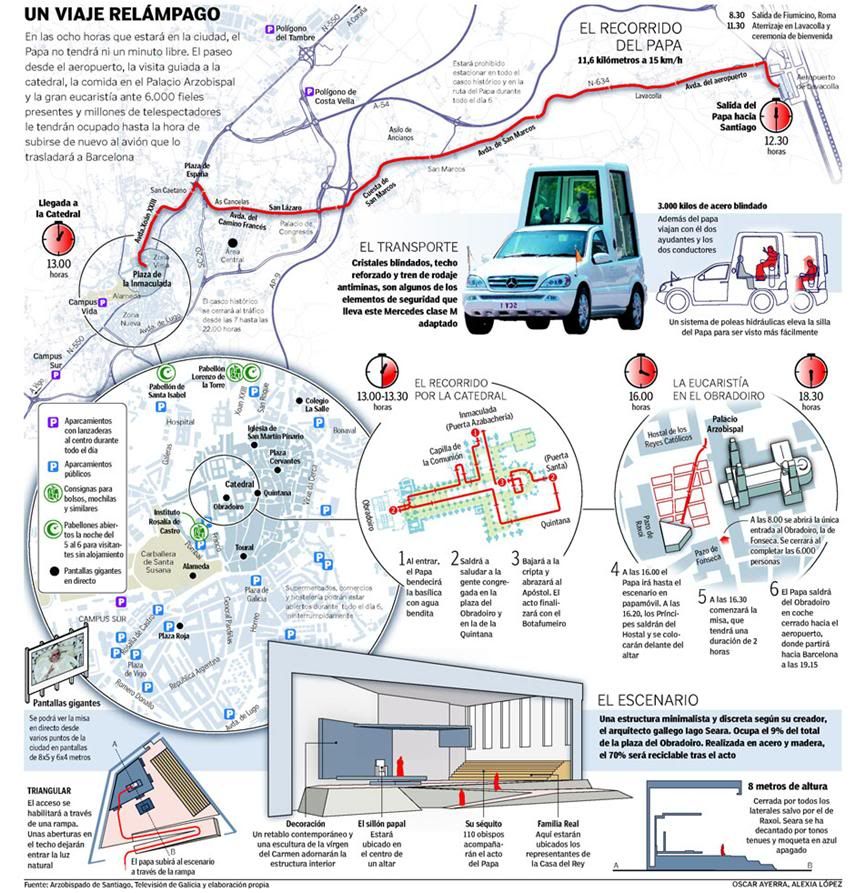
[Modificato da TERESA BENEDETTA 09/11/2010 20:30] |
| |
 06/11/2010 13:04 06/11/2010 13:04 |
|
| | | OFFLINE | | Post: 21.389
Post: 4.025 | Registrato il: 28/08/2005
Registrato il: 20/01/2009 | Administratore | Utente Master | |
|

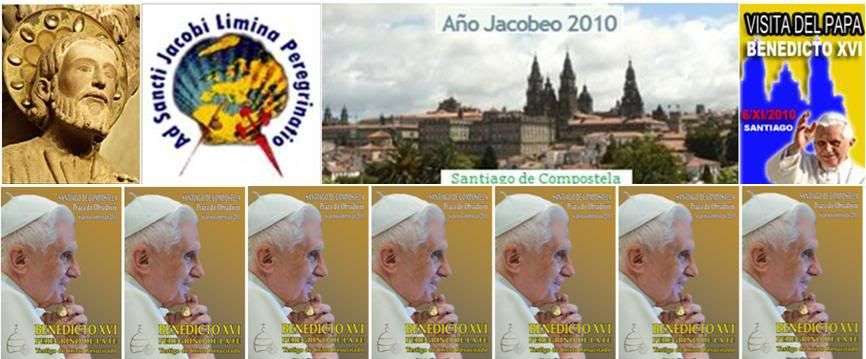 Santiago de Compostela
Santiago de Compostela
AIRPORT WELCOME
Benedict XVI arrived at Lavacolla airport in Galicia where he was welcomed by the Crown Prince of Spain, Felipe of Asturias, and his wife Princess Leticia. They also welcomed him to Valencia in 2006.
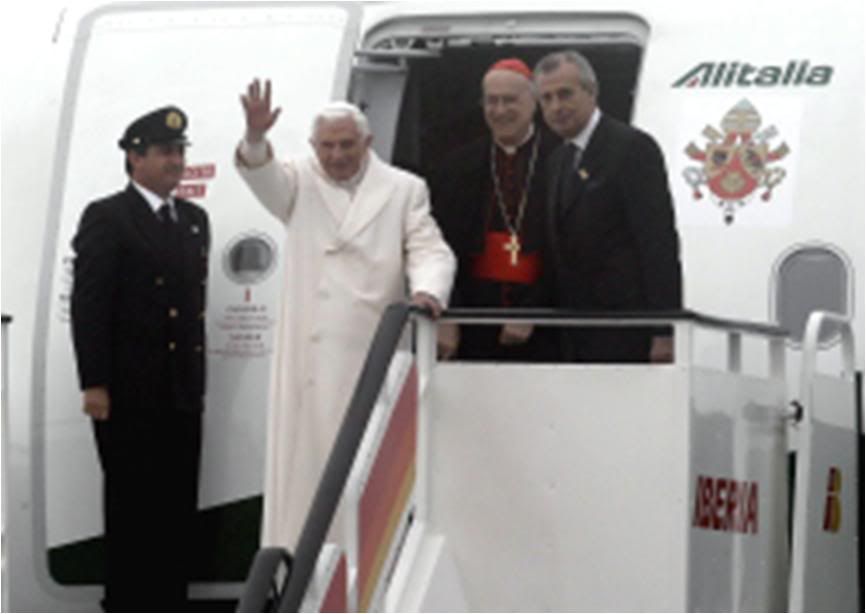
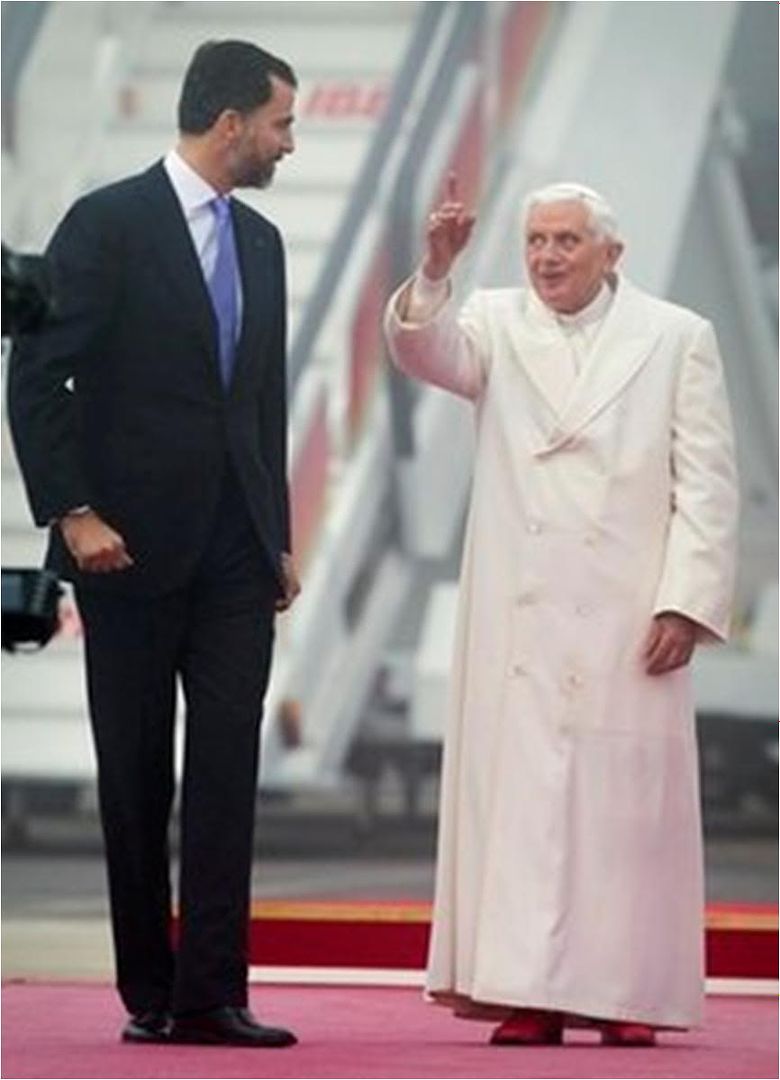
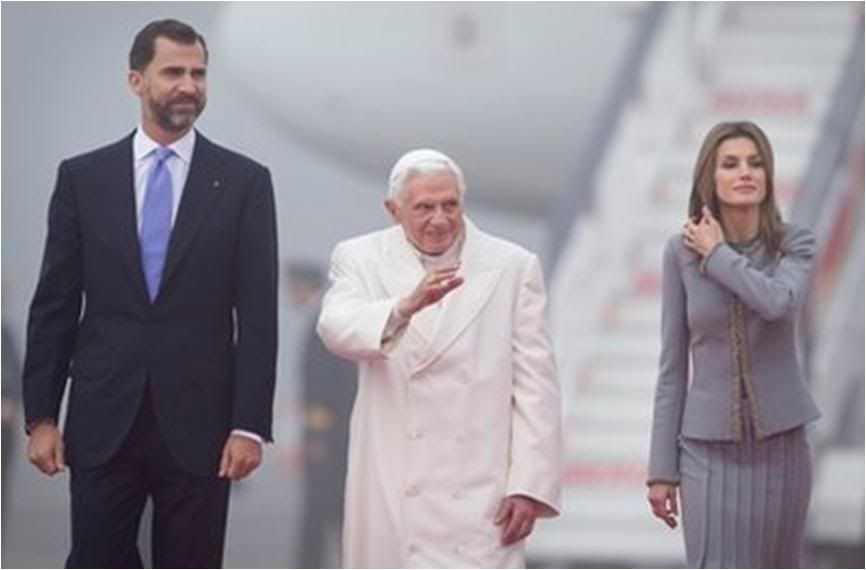
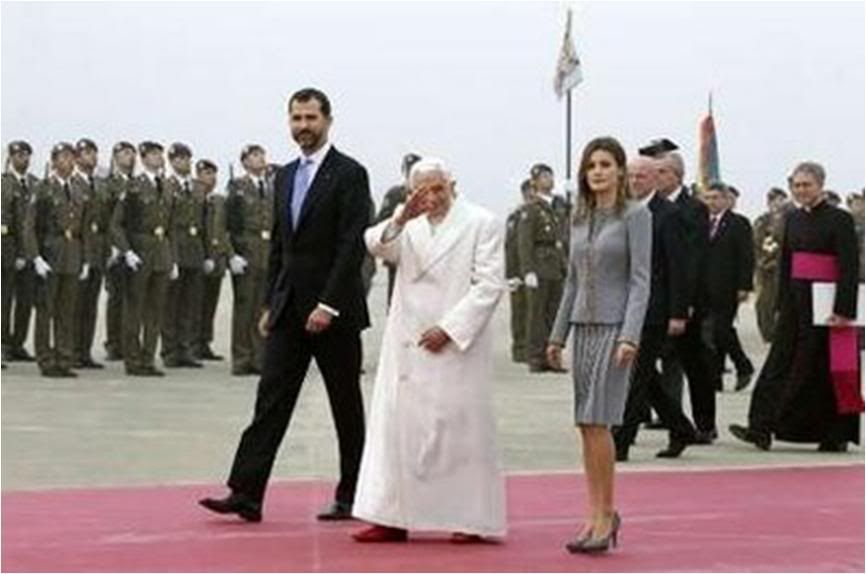
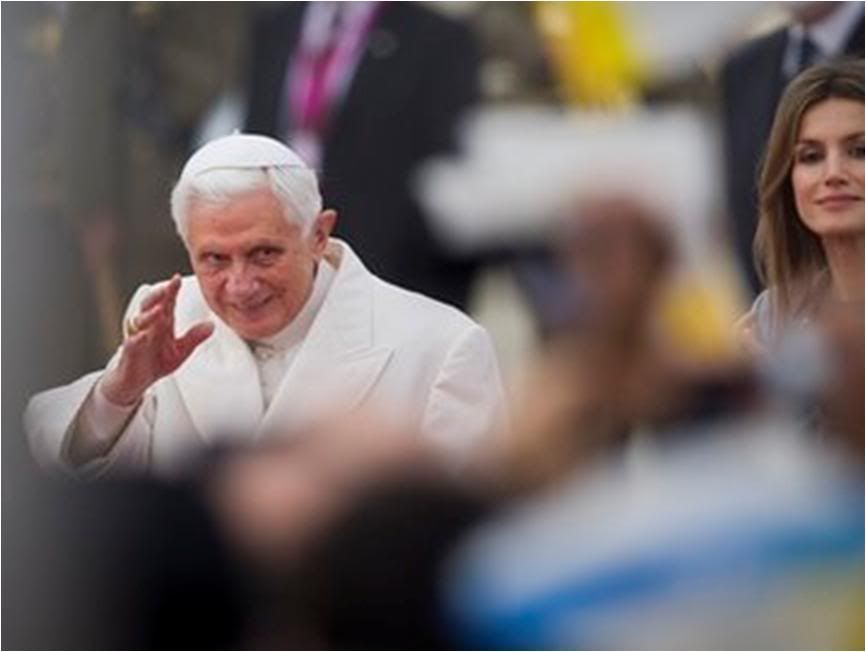
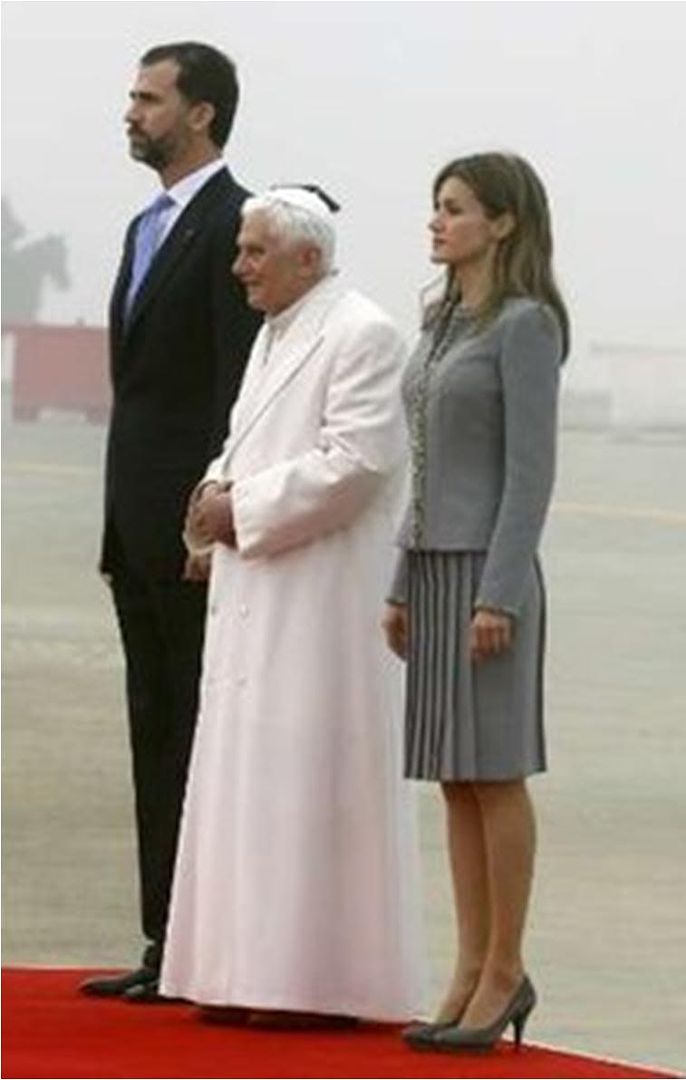
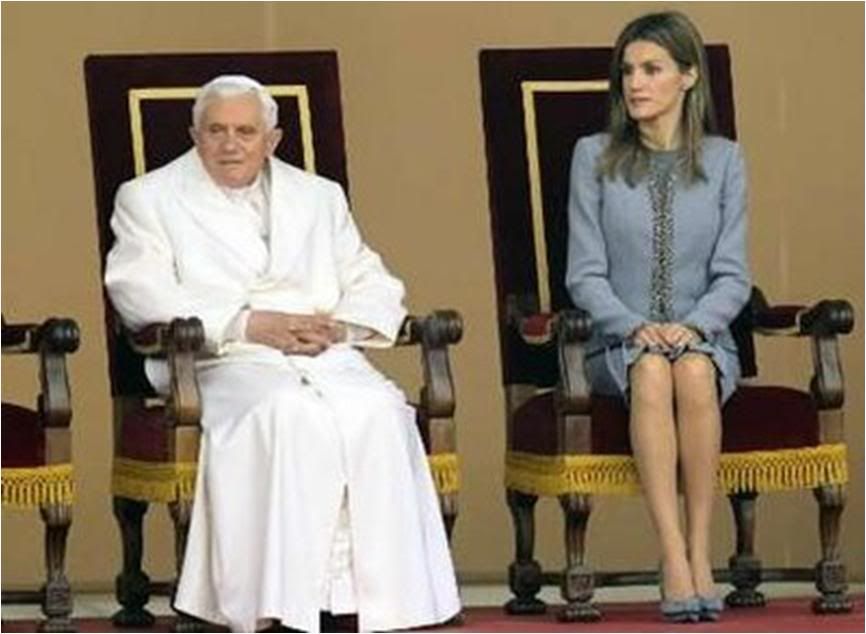 Pope arrives in Santiago
Pope arrives in Santiago

11 NOV 2010 (RV) - Pope Benedict XVI arrived in Santiago de Compostela on Saturday at the start of his two day visit to Spain.
He is visiting the third most important place of Christian pilgrimage after Jerusalem and Rome, thus completing the trifecta as the pilgrim Pope. Lydia O'Kane reports from Spain with the Pope.
Lydia O'Kane reports from Spain, where Pope Benedict arrived on Saturday "as a pilgrim" to "confirm Spain in its Christian faith":
As Pope Benedict’s plane touched down on the tarmac of the international airport at Santiago de Compostela it could hardly be seen for the thick fog that dominated the skyline.
Dressed in a white coat to guard against the winter chill, the Holy Father was greeted by the Prince of Asturias and his wife while in the background crowds could be heard shouting the Pope’s name and waving Vatican flags of welcome.
Following a greeting by Prince Felipe of Asturias, who spoke of the Pope’s visit as being one of “peace and hope”, the Holy Father addressing all those gathered, in Spanish, spoke about his joy at being on Spanish soil and being able to come as a pilgrim to this famed route at Santiago de Compostela.
With this speech the Pope alluded to key themes of this brief but “intense” visit as he called it, those being the themes of pilgrimage and Europe’s Christian identity.
The Pope spoke about the pilgrimage man is on in search of the truth and also the interior journey the Church follows to become a “transparent sign of Christ for the world.”
Recalling Europe and Spain’s Christian roots, the Pope noted this country’s contribution to the spreading of the Gospel through great Saints such as Ignatius of Loyola and Teresa of Jesus.
The Holy Father encouraged Spain and Europe to draw on its Christian foundations based on truth, freedom and justice adding that it is the moral, spiritual, and religious needs of this continent and not its material needs that are the requirements of “our common humanity.”
Finally, before a private meeting with members of Spain’s Royal family, and to the delight of those gathered the Pope paid homage to the people of Galicia in its official language Galician, expressing his closeness to the people of this region and the rest of Spain".
Santiago de Compostela is the capital of the Autonomous region of Gallica in the historic Northwest of Spain which has its own language and devolved government.
But what this regional capital is most famous for is the famed 9th century pilgrimage route, Camino de Santiago, or Way of St James which has been completed by pilgrims for hundreds of years aiming to reach the focal point of the Cathedral of St James.
Over its long history men and women both young and old have walked, cycled and even made the journey on horse back beginning, from France, Spain and Portugal, forging friendships and strengthen their faith along the way.
The Pope will not be walking the route himself but the Cathedral and its square will be the backdrop for a Mass presided over by the Holy Father on Saturday afternoon.
St James the Apostle or St James the Great is synonymous with Spain. He is the country’s Patron Saint, who preached the Gospel in both the Holy Land and in Iberia.
The story goes that he went back to Judea where he was martyred, only for his remains to be brought back by his disciples for burial at Santiago de Compostela at the site of the Cathedral that stands there today.
Fast forward to 2010, when the Successor of the Apostle Peter will come to this Holy place bringing his own message to the people, just like St James the Great.
The Pope is coming for the Holy Year which is celebrated every time St James’s feast day falls on a Sunday; 2010 was one of those years. A Holy Year usually brings an increased influx of pilgrims and this year has been no exception, but Holy Father’s visit has also peaked the pilgrims interest too.
The pilgrims office at Santiago de Compostela has seen a significant rise in registrations since the announcement of the Pope’s journey was made.
Pope Benedict last visited Spain in 2006 for the World Meeting of Families in Valencia, but in just 4 short years the country’s social and economic landscape has somewhat shifted.
Only this year a new Spanish law allowing abortion without restrictions in the first 14 weeks of pregnancy came into effect igniting a wave of protests from thousands of Spanish Catholics and like a number of other European countries Spain in the last few years has been severely hit by the global financial crisis which continues to bit hard prompting the government to introduce unpopular austerity measures.
But despite this economic gloom the second stage of Pope Benedict’s 32 hour visit will take him to one of the most vibrant cities in Europe, Barcelona.
Barcelona is the capital of another of Spain’s autonomous regions Catalonia, where Spanish, Catalan and Aragonese are all spoken. It is also a region which has witnessed years of bloodshed in the form of Catalan separatists who want independence from Spain.
In the second high point of this visit, the Holy Father will consecrate the Expiatory Temple of the Sagrada Familia in the heart of the city, a much loved iconic structure by the famed Spanish Architect Antoni Gaudi, which draws millions of tourists every year even if it is incomplete.
It is a temple where art meets faith, and a church that will be proclaimed a Basilica by Pope Benedict, symbolic perhaps of that New Evangelization he has so often spoken of in the face of an increasing secularism in traditionally Christian Europe.
ADDRESS OF HIS HOLINESS BENEDICT XVI
International Airport of Santiago de Compostela
Saturday, 6 November 2010
Your Royal Highnesses,
Distinguished national, regional and local authorities,
Your Grace the Archbishop of Santiago de Compostela,
Your Eminence the President of the Spanish Episcopal Conference,
Your Eminences and Excellencies,
Dear Brothers and Sisters,
Dear Friends,
I thank Your Highness for the respectful words which you have addressed to me in the name of all - words which are a touching echo of the sentiments of affection for the Successor of Peter which mark the sons and daughters of these noble lands.
I cordially greet those present and all who join us through the means of social communication, and I express my gratitude as well to all those who have worked generously, on the part of the Church and civil society, to make this brief yet intense Journey to Santiago de Compostela and Barcelona as fruitful as possible.
In his deepest being, man is always on a journey, ever in search of truth. The Church shares this profound human desire and herself sets out, accompanying humanity in its yearning for complete fulfilment.
At the same time, the Church pursues her own interior journey which, through faith, hope and love, leads her to become a transparent sign of Christ for the world.
This is her mission and her path: to be among men and women an ever greater presence of Christ “whom God made our wisdom, our righteousness and sanctification and redemption”(1 Cor 1:30). For this reason, I too have journeyed here, to confirm my brothers and sisters in the faith (cf. Lk 22:32).
I have come as a pilgrim in this Holy Year of Compostela and I bring in my heart the same love of Christ which led the Apostle Paul to embark upon his journeys, with a desire also to come to Spain (cf. Rom 15: 22-29).
I wish to join the great host of men and women who down the centuries have come to Compostela from every corner of this peninsula, from throughout Europe and indeed the whole world, in order to kneel at the feet of Saint James and be transformed by the witness of his faith.
They, at every step and filled with hope, created a pathway of culture, prayer, mercy and conversion, which took shape in churches and hospitals, in inns, bridges and monasteries. In this way, Spain and Europe developed a spiritual physiognomy marked indelibly by the Gospel.
Precisely as a herald and witness of the Gospel, I am also going to Barcelona, in order to nourish the faith of its welcoming and dynamic people. A faith sown already at the dawn of Christianity, one which blossomed and grew in the warmth of countless examples of holiness, giving rise to countless institutions of beneficence, culture and education.
A faith which inspired the gifted architect Antoni Gaudí to undertake in that city, with the fervour and cooperation of many people, that marvel which is the church of the Sagrada Familia. It will fall happily to me to dedicate that church, which reflects all the grandeur of the human spirit in its openness to God.
I am very pleased to be once again in Spain, which has given the world a constellation of great saints, founders and poets, like Ignatius of Loyola, Teresa of Jesus, John of the Cross, Francis Xavier, among many others.
in the twentieth century it raised up new institutions, groups and communities of Christian life and apostolic activity and, in recent decades, it has advanced in harmony and unity, in freedom and peace, looking to the future with hope and responsibility.
Moved by her rich patrimony of human and spiritual values, she seeks likewise to progress amid difficulties and to offer her solidarity to the international community.
These contributions and initiatives which have distinguished your long past, as well as the present, together with the significance of the two beautiful places I will visit on this occasion, lead me to look also to all the peoples of Spain and Europe.
Like the Servant of God John Paul II, who from Compostela exhorted the old Continent to give a new impulse to its Christian roots, I too wish to encourage Spain and Europe to build their present and to project their future on the basis of the authentic truth about man, on the basis of the freedom which respects this truth and never harms it, and on the basis of justice for all, beginning with the poorest and the most defenceless.
A Spain and a Europe concerned not only with people’s material needs but also with their moral and social, spiritual and religious needs, since all these are genuine requirements of our common humanity and only in this way can work be done effectively, integrally and fruitfully for man’s good.
[In Galician:] Dear friends, I renew my thanks for your kind welcome and for your presence at this airport. I renew my affection and closeness to the beloved sons and daughters of Galicia, Catalonia and the other peoples of Spain.
In commending my stay among you to the intercession of the Apostle Saint James, I ask God to bestow his blessings on all of you. Thank you very much/
Visiting Compostela:
A childhood wish fulfilled
by José Manuel Vidal
Translated from

Nov. 6, 2010
He was nine years old when he first dreamed of coming to Compostela. He had just entered the minor seminary, when one of his teachers sang the praises of the Camino de Santiago and the tomb of St. James to his fascinated pupils.
Compostela: for much of Europe, Finisterrae - the end of the earth - being at the western extremity of the Iberian peninsula.
Since then, the boy Joseph dreamed of one day coming to Compostela to make a pilgrimage to the cathedral of the 'field of stars' ('campo stela') and embrace James, the friend of Jesus.
All seminarians of his time dreamt of going to the three major pilgrimage sites of Christianity since the Middle Ages: Jerusalem, Rome and Compostela.
Many accomplished all three: to step foot in the Holy Land, Jesus's homeland; in Rome, to visit the tombs of Peter and Paul; and in Compostela, to the tomb of St. James. But ironically, Joseph Ratzinger had to wait until he became Pope to achieve all three.
As a young priest, he first visited and became familiar with Rome. It was the time of Vatican II and he was a young and brilliant theologian who found himselr rubbing elbows with the greates Church intellectuals of the day. He teamed up with other brilliant young theologians who helped lay the basis for that tremendous ecclesiastical spring.
He has visited the Holy Land a few times - first as a priest, later as Archbishop of Munich, then as Prefect of the CDF, and most recently as Pope, in May 2009.
He had one task undone: Santiago. He had been on the point of visiting Santiago a number of times, most recently in 2005, when he had everything planned to the last detail. He would make the pilgrimage with his brother Georg, anf they were to spend a week in Galicia, in order to soak themselves in the significance of the Jacobean experience for the region.
But he cancelled the trip that had been planned for spring, as John Paul II's condition worsened, and it was out of the question for him to leave Rome.
But today, Joseph Ratzinger will realize his childhood dream. He comes as a pilgrim but wearing the white robe only Popes wear. And when he embraces the image of St. James, he will surely give thanks that the Lord has granted him this wish.
And he will have a special thought for his brother George who could not join him on this trip. But Joseph will have much to tell him about. Much that will surely be good.
Reporting later today on the Pope's arrival and the airport ceremonies, Vidal wrote:
An emotional Pope
arrives in Galicia
Now he is in Galicia. And the Pope fulfills his dream of visiting Santiago de Compostela.
Upon setting foot in Lavacolla airport, and after greeting the Princes of Spain and authorities present, Benedict XVI used his first speech to give thanks, saying how happy he was to come as a pilgrim, even as he outlined the trajectory of his messages during this two-day visit to Spain.
With the basic message that we will surely hear again and again: an invitation to Spain and Europe to recover their Christian roots.
A visibly moved Pope who expressed his joy 'to be in Spain once again'....
[Vidal goes on to quote from the Holy Father's address.]
[Modificato da TERESA BENEDETTA 06/11/2010 15:45] |
| |
 06/11/2010 17:17 06/11/2010 17:17 |
|
| | | OFFLINE | | Post: 21.390
Post: 4.026 | Registrato il: 28/08/2005
Registrato il: 20/01/2009 | Administratore | Utente Master | |
|

 AT THE CATHEDRAL
AT THE CATHEDRAL
OF SAINT JAMES
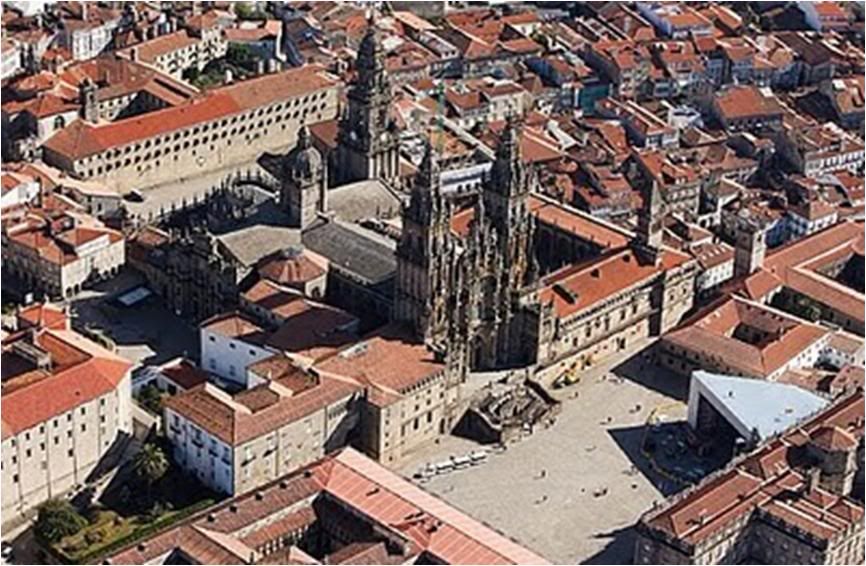

 Ovation for the Pope
Translated from
Ovation for the Pope
Translated from

Nov. 6, 2010
EFE is the official Spanish news agency.
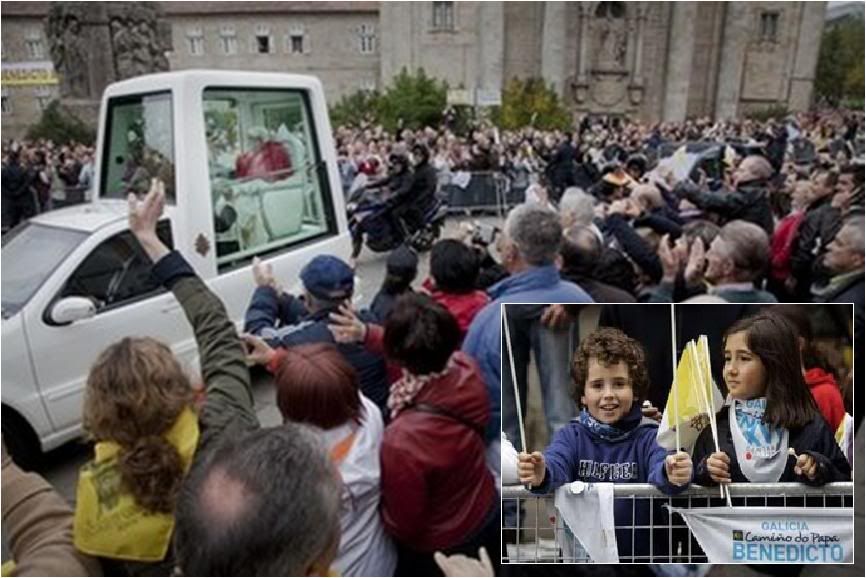
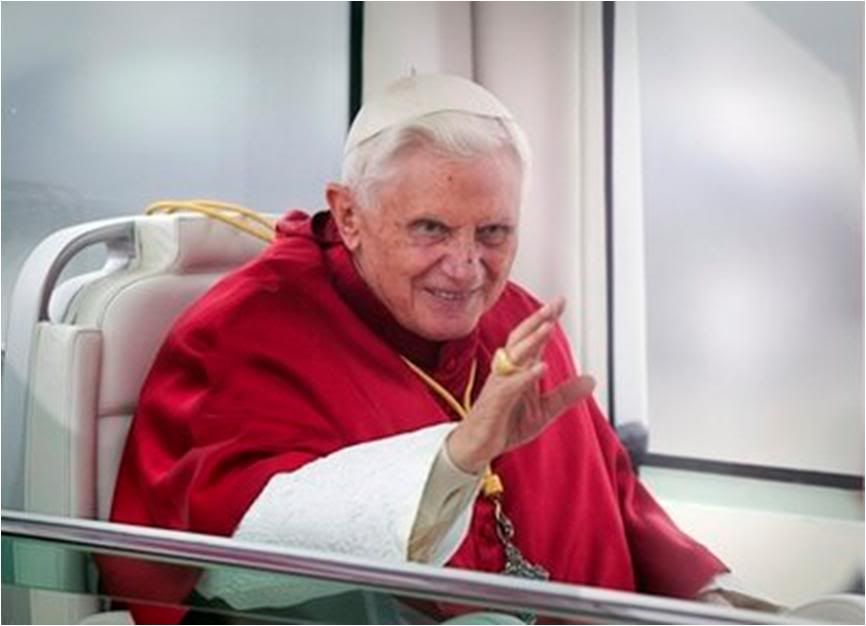
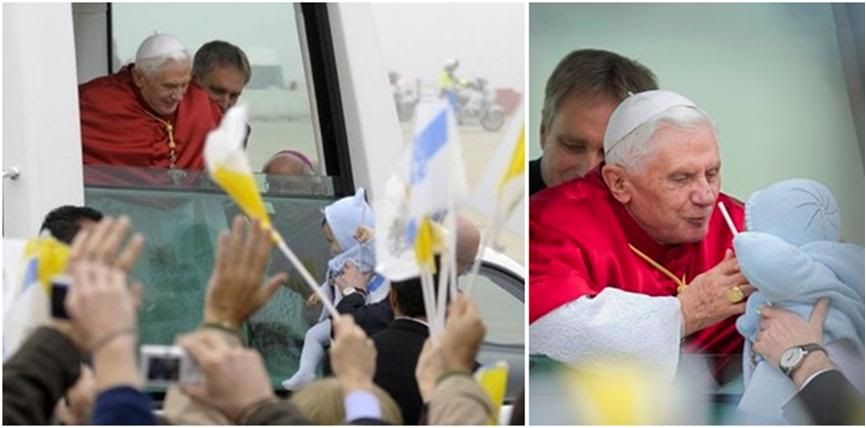
The first part of the Pope's visit to Santiago has taken place without incident. The Pope visited the Cathedral after eiding in the Popemobile from Lavacolla airport to the city. because of the heavy fog, there were less people than expected along the route. There were also complaints that the Popemobile went by too fast.
But the vast plaza in front of the Cathedral and the surrounding streets were filled with pilgrims. Inside the Cathedral, the Pope broke protocol and went up towards the persons admitted for the visit, mostly sick and aged people with their families.
Then, he went out through the main entrance to greet the people gathered in Plaza Obradoiro, who acclaimed with a thundering ovation.

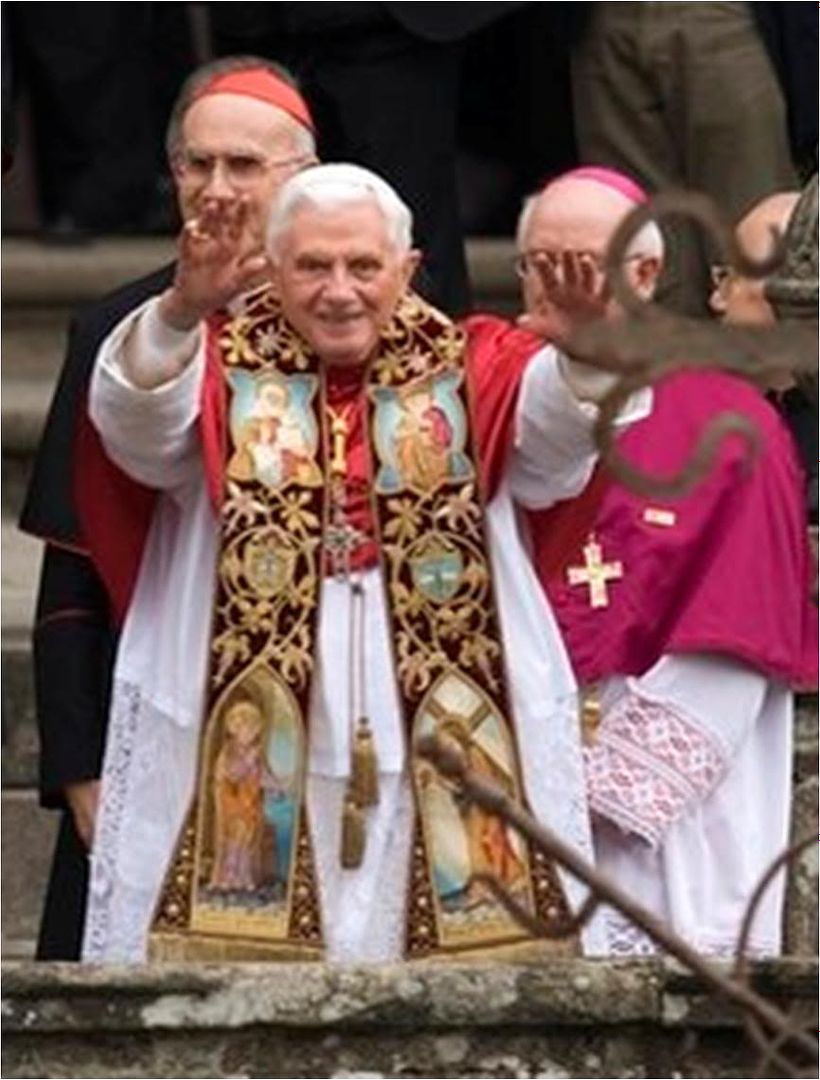
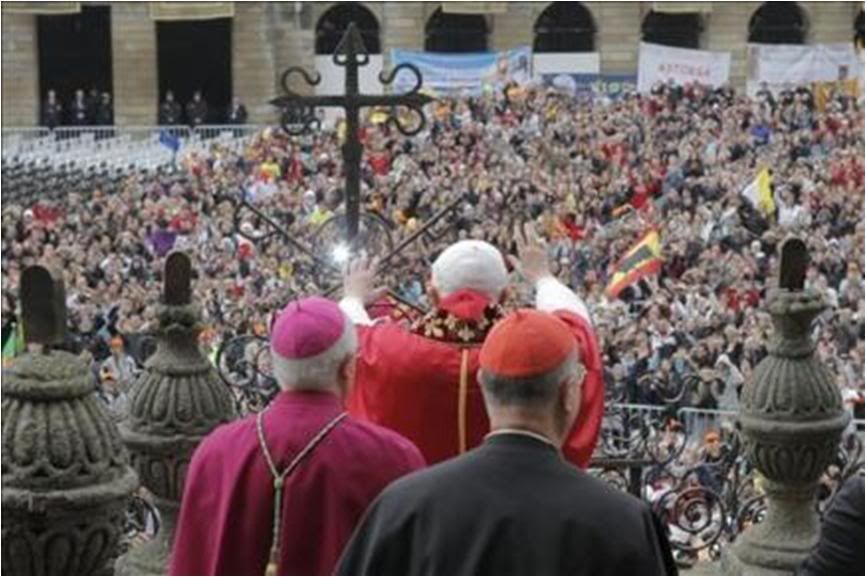
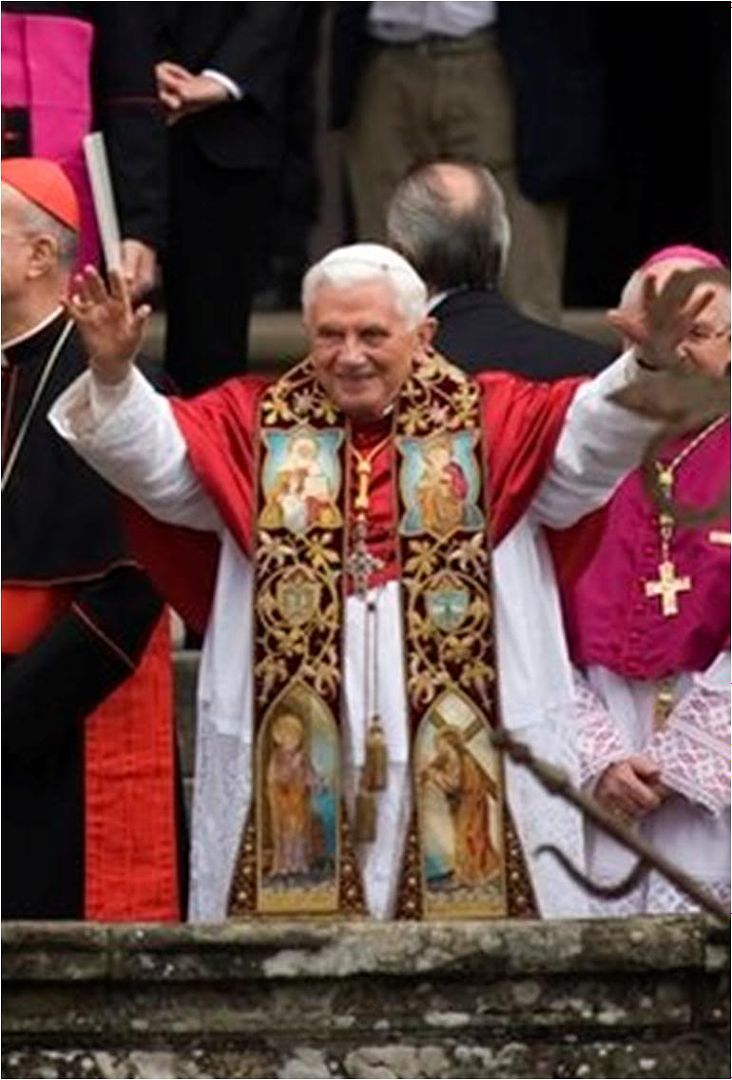
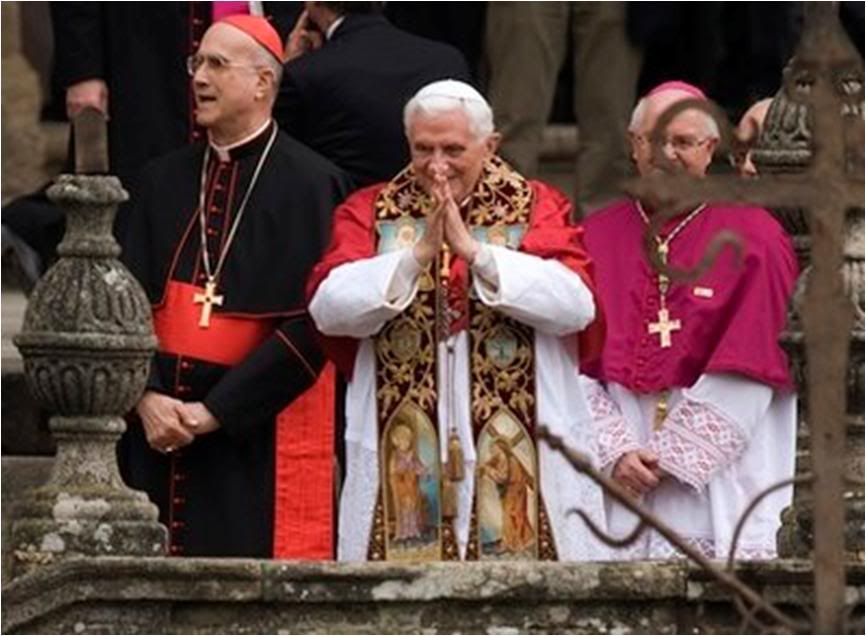

After admiring the so-called Portal of Glory, he proceeded to the Plaza de la Quintana where he was given an adaptation of the traditional pilbrim's cape to wear before re-entering the Cathedral through the Holy Door.
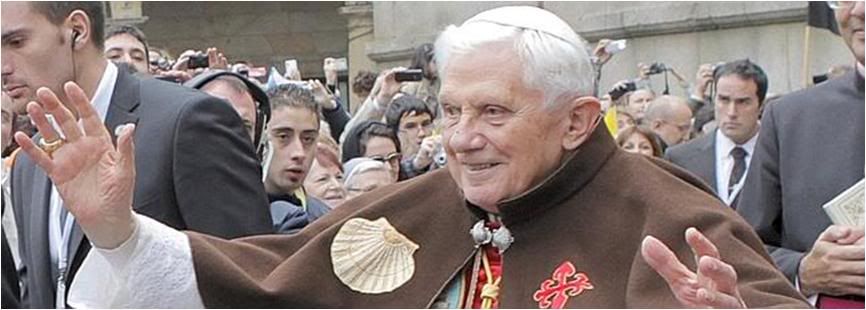
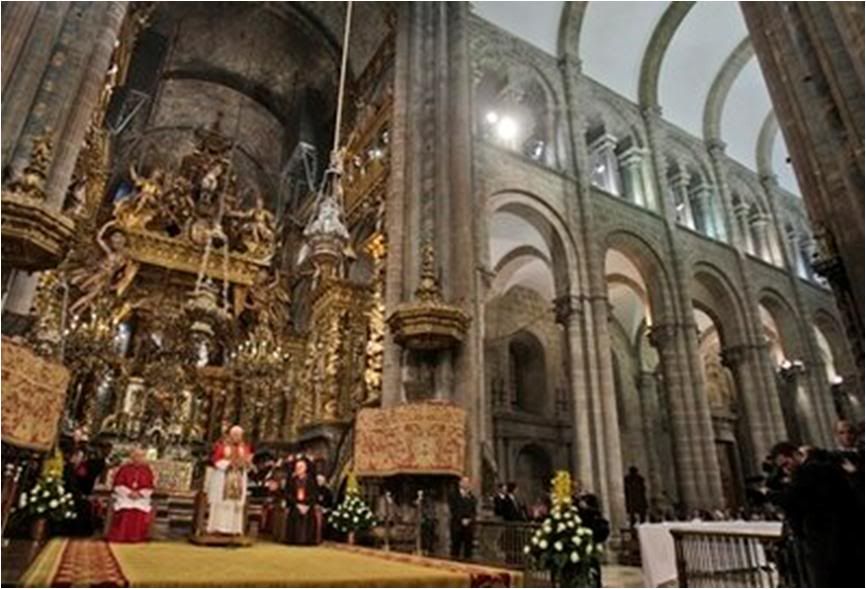
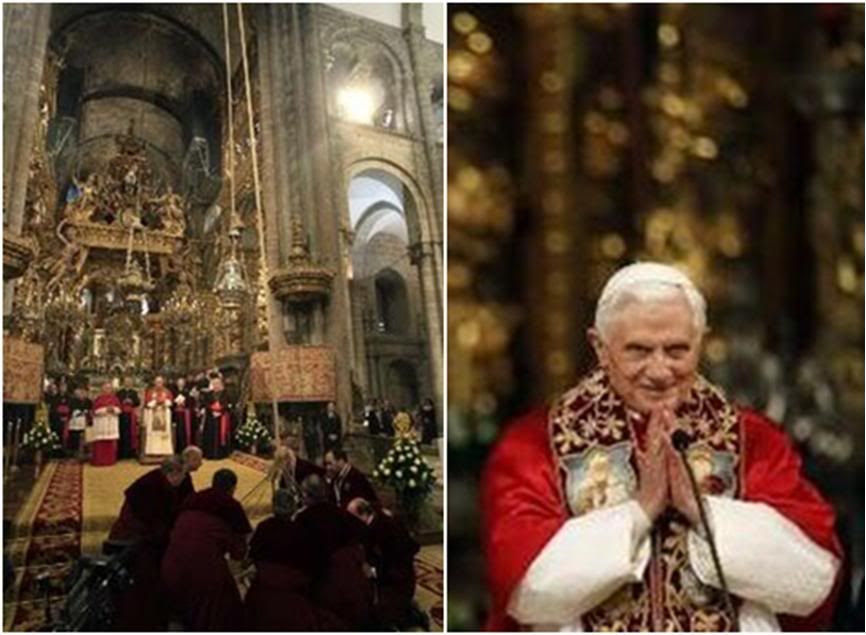
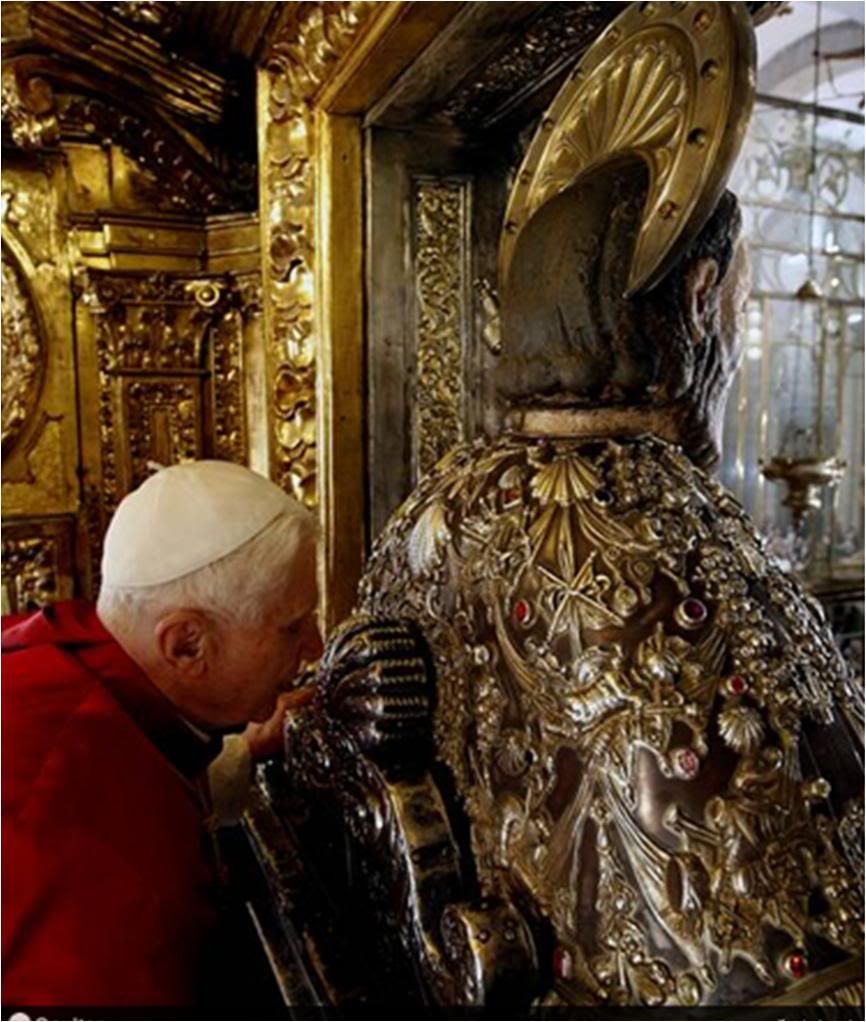
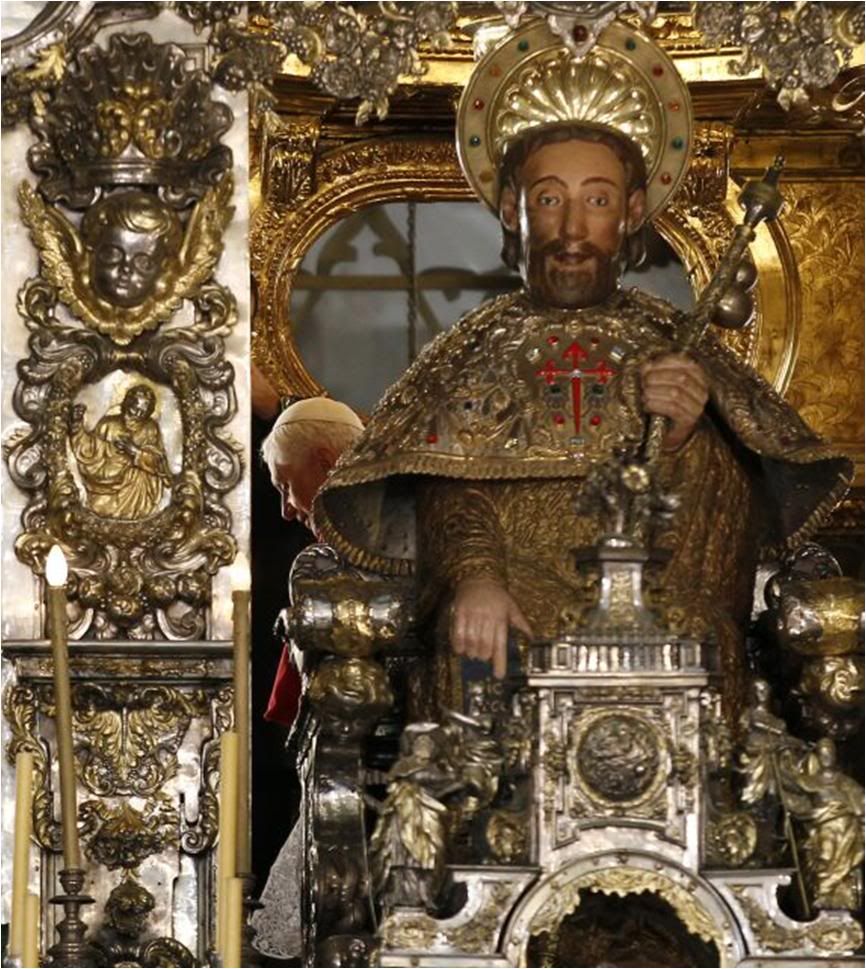
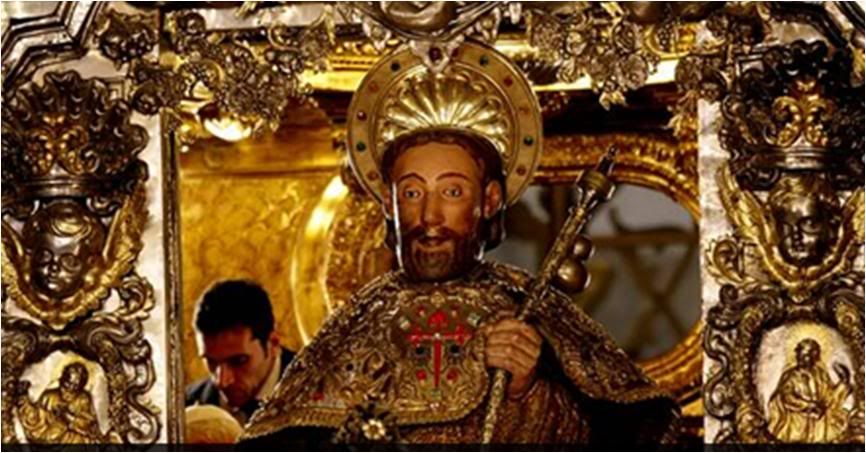
After the rite of embracing the image of St. James, following the age-old practice, he presided at a brief liturgy where he addressed the faithful, earning great applause when he began and ended the discourse in the Galician language.
The rite concluded with the cathedral's famous 'botafumeiro' - world's largest thurible - swinging from the ceiling to waft incense on the congregation.
[Still 'processing' available photos]
From the cathedral, he proceeded to the Archbishop's Palace for lunch with the bishops of the Spanish conference and a mid-afternoon rest before a 5 p.m. Mass at Plaza Obradoiro.
THE HOLY FATHER'S DISCOURSE
Your Eminences,
Dear Brother Bishops,
Distinguished Authorities,
Dear Priests, Seminarians and Religious,
Dear Brothers and Sisters,
Dear Friends,
[In Galician:] I thank Archbishop Xulián Barrio Barrio of Santiago de Compostela for his kind words. I am happy to greet all of you with affection in the Lord and with gratitude for your presence in this highly significant place.
To go on pilgrimage is not simply to visit a place to admire its treasures of nature, art or history. To go on pilgrimage really means to step out of ourselves in order to encounter God where he has revealed himself, where his grace has shone with particular splendour and produced rich fruits of conversion and holiness among those who believe.
Above all, Christians go on pilgrimage to the Holy Land, to the places associated with the Lord’s passion, death and resurrection. They go to Rome, the city of the martyrdom of Peter and Paul, and also to Compostela, which, associated with the memory of Saint James, has welcomed pilgrims from throughout the world who desire to strengthen their spirit with the Apostle’s witness of faith and love.
In this Holy Year of Compostela, I too, as the Successor of Peter, wished to come in pilgrimage to the “House of Saint James”, as it prepares to celebrate the eight-hundredth anniversary of its consecration.
I have come to confirm your faith, to stir up your hope and to entrust to the Apostle’s intercession your aspirations, struggles and labours in the service of the Gospel.
As I embraced the venerable statue of the Saint, I also prayed for all the children of the Church, which has her origin in the mystery of the communion that is God. Through faith we are introduced to the mystery of love that is the Most Holy Trinity. We are in some sense embraced by God, transformed by his love.
The Church is this embrace of God, in which men and women learn also to embrace their brothers and sisters and to discover in them the divine image and likeness which constitutes the deepest truth of their existence, and which is the origin of genuine freedom.
Truth and freedom are closely and necessarily related. Honestly seeking and aspiring to truth is the condition of authentic freedom. One cannot live without the other.
The Church, which desires to serve unreservedly the human person and his dignity, stands at the service of both truth and freedom. She cannot renounce either, because what is at stake is man himself, because she is moved by love for man, “the only creature on earth which God has wanted for its own sake”(Gaudium et Spes, 24), and because without this aspiration for truth, justice and freedom, man would lose his very self.
From Compostela, the spiritual heart of Galicia and at the same time a school of unbounded universality, allow me to exhort all the faithful of this beloved Archdiocese, and those of the Church in Spain, to live their lives enlightened by the truth of Christ, confessing the faith with joy, consistency and simplicity, at home, at work and in their commitment as citizens.
May the joy of knowing that you are God’s beloved children bring you to an ever deeper love for the Church and to cooperate with her in her work of leading all men and women to Christ.
Pray to the Lord of the harvest that many young people will devote themselves to this mission in the priestly ministry and in the consecrated life: today, it is as worthwhile as ever to dedicate one’s whole life to the proclamation of the newness of the Gospel.
I cannot conclude without first expressing my appreciation and gratitude to the Catholics of Spain for the generosity with which they support so many institutions of charity and of human development.
Continue to maintain these works which benefit society as a whole, and whose effectiveness has been shown in a special way in the present economic crisis, as well as when grave natural disasters have affected certain countries.
[In Galician:] With these sentiments, I ask Almighty God to grant all of you the boldness which Saint James showed in bearing witness to the Risen Christ. In this way, may you remain faithful in the ways of holiness and spend yourselves for the glory of God and the good of our brothers and sisters in greatest need. Thank you.
12 noon, New York time: The Mass is now underway in Plaza Obradoiro.
1:50 pm., NY - The Mass has ended. That was probably the most musically beautiful and impeccable Mass I have heard in the 5-1/2 years of the Pontificate. I wish I knew who was the Mass composer - Spain has an embarrassment of riches in terms of great liturgical composers. The Archdiocese of Santiago spared no musical resources for this Mass - a seamlessly integrated repertoire, a choir and orchestra inside the Church, a man's chorus on the great steps of the Cathedral, the most hauntingly beautiful chanting of the Responsorial Psalm by an elderly male cantor, a flute solo as the background for the post-Communion reflection, and the greatest personal surprise for me, the communion hymn sung by everyone: a Spanish popular hymn I had not heard since I was 14 years old and left my hometown for college - so evocative of everything beautiful in my Catholic upbringing that, forgive me for indulging, I burst into tears. It ends with an invocation that is truly stirring and majestic, even when sung by anyone - "Gloria al Cristo Senor! Cielo y tierra, bendecid al Senor! Honor y gloria a ti, Rey de la gloria. Honor por siempre a ti, Dios del Amor", matched to inherently reverent music... What a lovely day this has been, a feast for the heart and spirit, as well as for the senses... Thank you, Santiago Apostol! Watch over the Successor of Peter...
[Modificato da TERESA BENEDETTA 06/11/2010 20:31] |
| |
 06/11/2010 19:18 06/11/2010 19:18 |
|
| | | OFFLINE | Post: 344
Post: 77 | Registrato il: 28/05/2007
Registrato il: 19/02/2009 | Utente Comunità | Utente Junior | |
|
I agree, Teresa. It was really wonderful.
My own bursting into tears moment was right after yours: Ave Verum by Mozart does it for me every single time. Simply awe inspiring.
 Beautiful thoughts, Heike! Isn't it wonderful how many beautiful lthings can be expressed through tears? Who can doubt the sacramental nature of the Holy Mass when even its 'simulacrum' on TV is capable of awakening the spirit almost as well as the actual Mass? It only demonstrates in turn that there is a God who inspires everything that is good about man and in man, and that liturgy is a very powerful way to make his presence felt... It is great to be a Catholic in the Pontificate of Benedict XVI!... He was a bit hoarse today, but he sure chanted the Canon prayers quite vigorously! AD MULTOS ANNOS, BENEDICTE!
Beautiful thoughts, Heike! Isn't it wonderful how many beautiful lthings can be expressed through tears? Who can doubt the sacramental nature of the Holy Mass when even its 'simulacrum' on TV is capable of awakening the spirit almost as well as the actual Mass? It only demonstrates in turn that there is a God who inspires everything that is good about man and in man, and that liturgy is a very powerful way to make his presence felt... It is great to be a Catholic in the Pontificate of Benedict XVI!... He was a bit hoarse today, but he sure chanted the Canon prayers quite vigorously! AD MULTOS ANNOS, BENEDICTE!
Teresa[Modificato da TERESA BENEDETTA 06/11/2010 20:50] |
| |
 06/11/2010 20:56 06/11/2010 20:56 |
|
| | | OFFLINE | | Post: 21.391
Post: 4.027 | Registrato il: 28/08/2005
Registrato il: 20/01/2009 | Administratore | Utente Master | |
|
[Modificato da TERESA BENEDETTA 06/11/2010 20:59] |
| |
 06/11/2010 20:57 06/11/2010 20:57 |
|
| | | OFFLINE | | Post: 21.392
Post: 4.028 | Registrato il: 28/08/2005
Registrato il: 20/01/2009 | Administratore | Utente Master | |
|

 MASS TO COMMEMORATE
MASS TO COMMEMORATE
THE HOLY YEAR OF ST. JAMES
Although the Archbishop's Palace is within walking distance of Plaza Obradoiro, the Holy Father took the Popemobile to go to the square so he could be driven around among the faithful before vesting for the Mass.
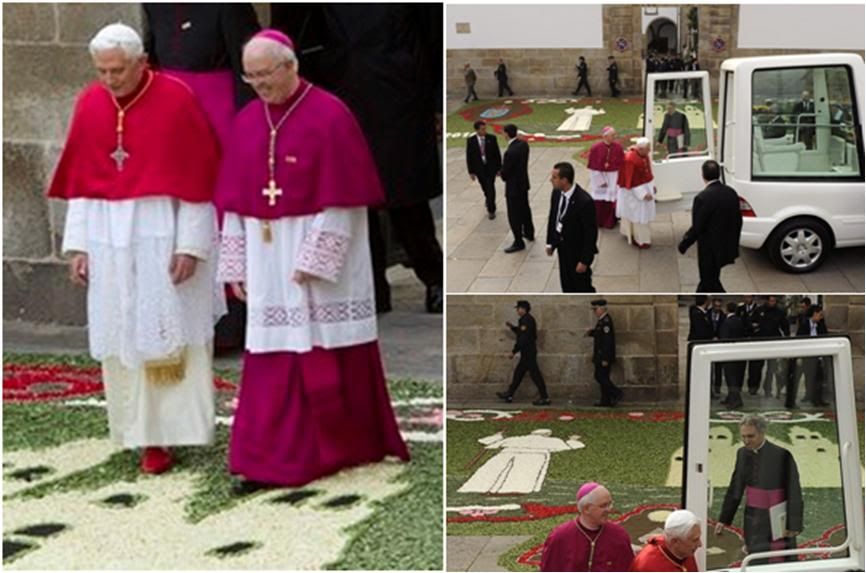
The Pope and Mons. Barrio, Archbishop of Santiago, walk over a flower carpet with the figures of the Pope and the cathedral, to board the Popemobile towards the Plaza.
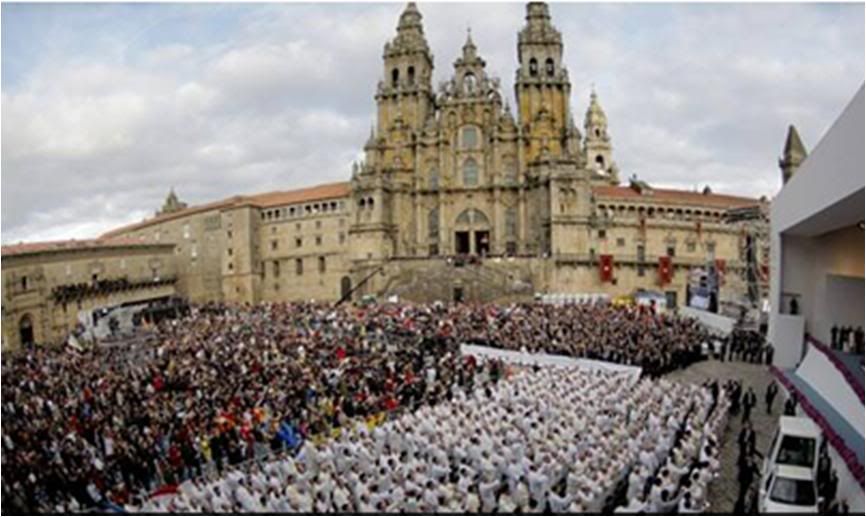
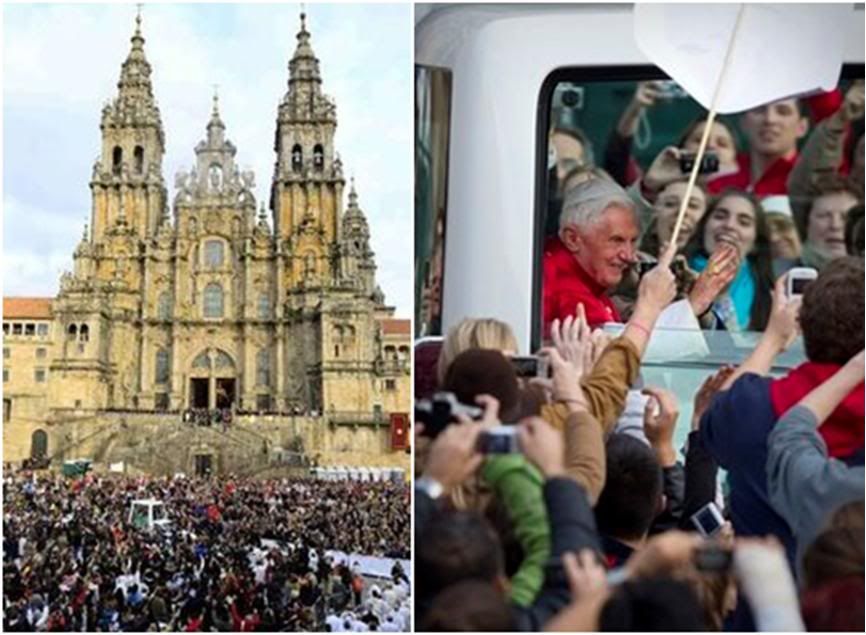
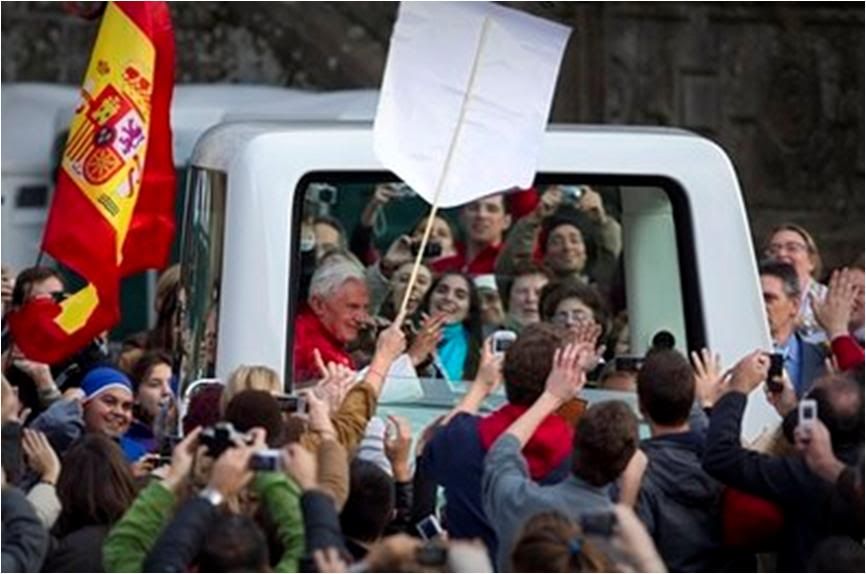
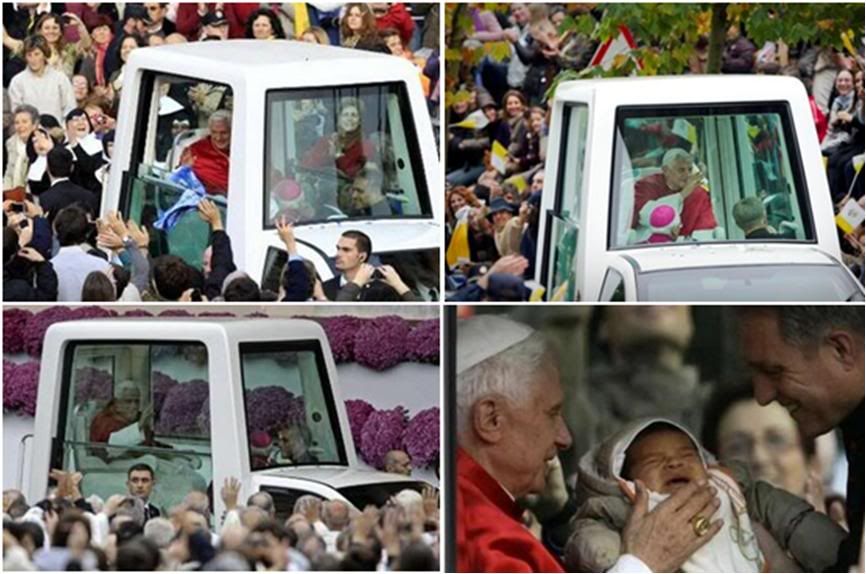
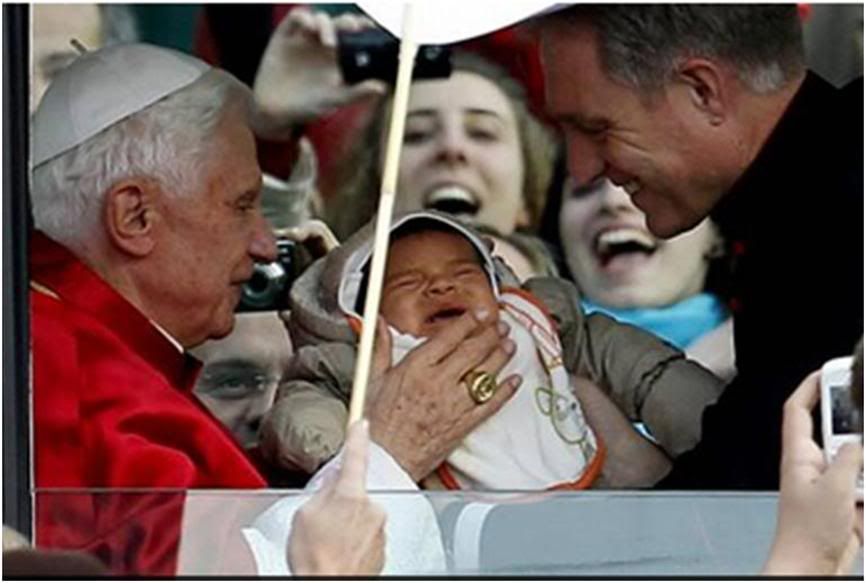 Pope, in Spain, urges Europe
Pope, in Spain, urges Europe
to keep spiritual roots
By Cristina Fuentes-Cantillana

November 6, 2010
SANTIAGO DE COMPOSTELA, Spain, Nov 6 (Reuters) - Pope Benedict, on a lightning trip to Spain, urged Europe on Saturday to re-discover God and its Christian heritage and also denounced the country’s liberal abortion laws.
"Europe must open itself to God, must come to meet him without fear," he said in the sermon of a Mass for more than 20,000 people in the square of Santiago de Compostela, which has been a major pilgrimage destination since medieval times.
Spain’s Roman Catholic Church, whose image was stained by its close relationship with Francisco Franco during his 36-year dictatorship, has clashed with the Socialist government of Prime Minister Jose Luis Zapatero over gay rights and abortion.
One of the main themes of Benedict’s papacy — and an aim of the Spanish trip — has been what the Church calls the "re-evangelisation" of Europe, an attempt to urge people to return to their religious roots despite living in highly secularised societies.
Upon arrival on Saturday morning, the Pope spoke of the need to defend "the most defenseless," and in the afternoon he decried "public silence with regard to the first and essential reality of human life" — references to abortion.
"Blessed cross, shine always upon the lands of Europe!" he said at the afternoon Mass from a modern platform before the city’s Romanesque 12th-century cathedral, believed to be the burial place of the St James the Apostle.
Santiago de Compostela, in northwestern Spain, has been a major pilgrimage destination for all Europeans since medieval times and is seen as a symbol of Europe’s Christian heritage.
Abortion, illegal under Franco who died in 1975, was legalised in limited circumstances in 1985 but this year Zapatero’s government allowed it on demand during the first 14 weeks of pregnancy. Minors can abort with one parent’s consent.
Of Spain’s 46 million people, 76 percent consider themselves Catholic but only 15 percent of those say they regularly attend church, according to a poll by the Sociological Research Center.
One of the biggest battles between the Spanish government and the Church has been over gay rights.
Spain in 2005 became the third country in the world to legalise gay marriage. The law, promoted by Zapatero despite fierce opposition from the Church, allows married gay couples to adopt children, something which is anathema to the Vatican.
Gays and lesbians are planning a large "kiss-in" demonstration against the visit in Barcelona, where the Pope will fly on Saturday night for the second leg of his visit.
But with Spain struggling to emerge from a prolonged recession and 20 percent unemployment, protests against the Pope have concentrated not only on religious and social issues, but also on the millions of euros spent on security and logistics.
"I think it’s bad, I mean really bad, to spend so much money on a guy who comes, gives a speech, stays an hour and leaves," Pedro Barral Gonzalez, 18, said in Santiago de Compostela. [As usual, protestors and the media never speak of the economic boomlet that any papal trip brings to the host city, often many times more than the local expense on logistics and security.]

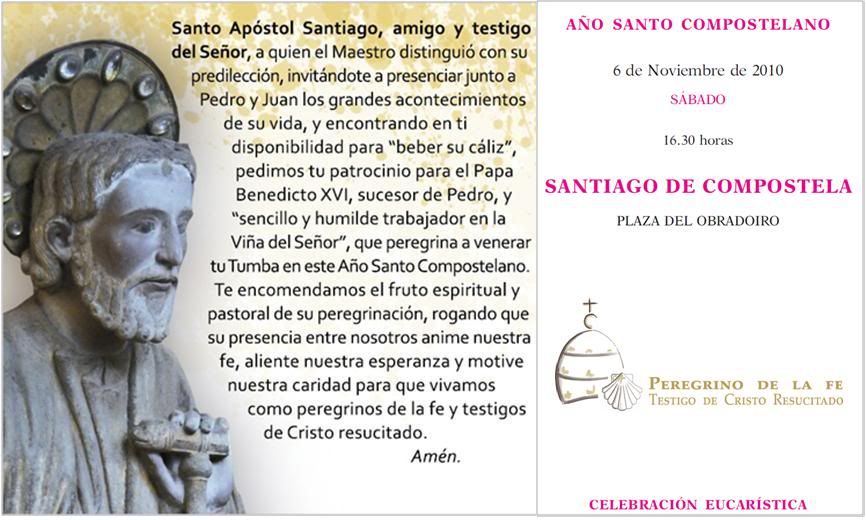

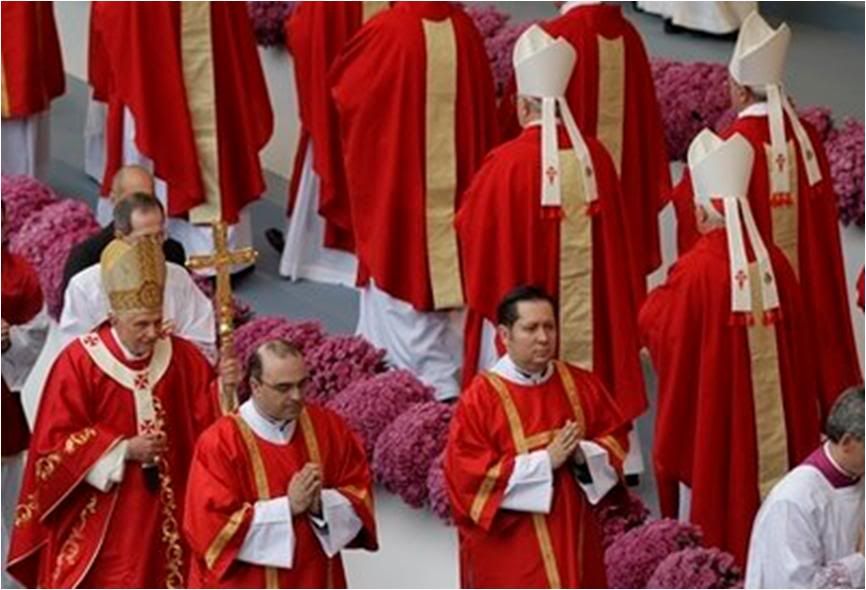
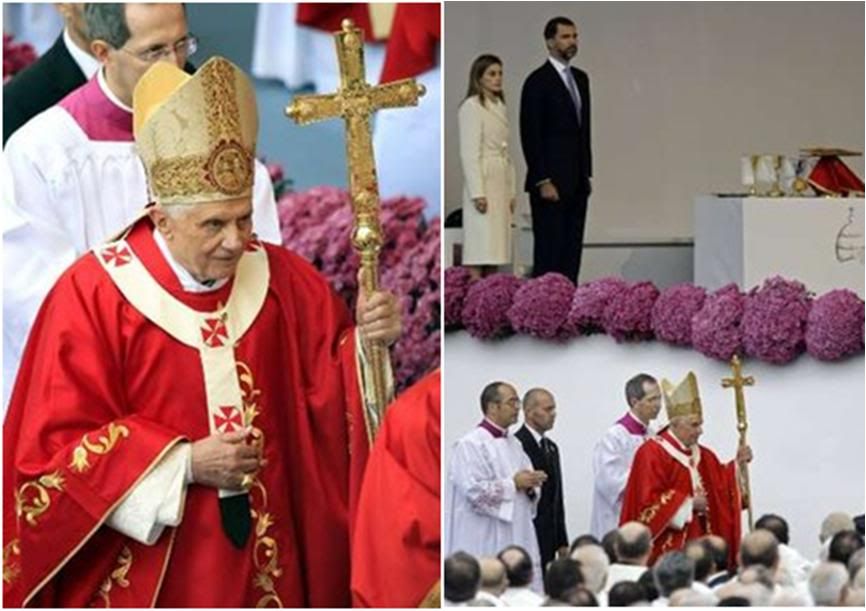
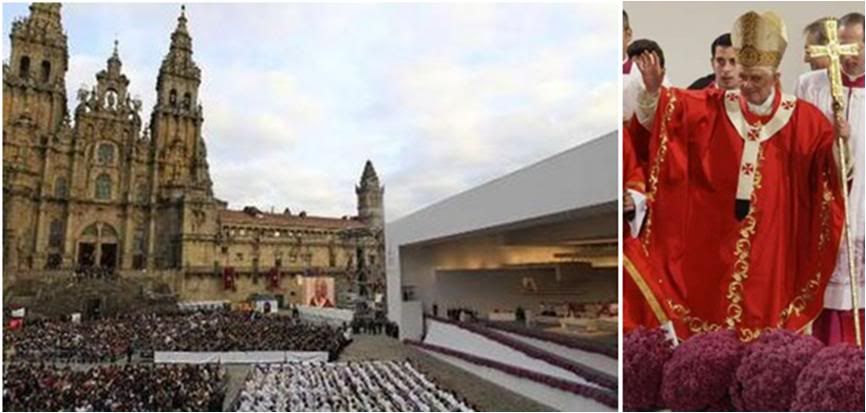 Pope urges Spain to remain
Pope urges Spain to remain
constant in its faith
by Lydia O'Kane

It could have been a scene from an epic film with a cast of thousands, but in fact, the occasion was a Mass presided over by Pope Benedict the XVI to mark the Holy Year at Santiago de Compostela in the square in front of the great cathedral of St James.
Many people had been in the Plaza del Obradoiro from earlier in the day when the Pope had visited the Cathedral to pay homage to the Apostle James, but the crowd swelled even more for the afternoon Mass.
When the Holy Father did arrive in choir dress and a red mozzetta, it was to rapturous applause and the Pope himself seemed swept up in the infectious atmosphere. With a sky that seemed to clear just for the occasion the celebration got underway with a greeting by the Archbishop of Santiago de Compostela.
The Mass itself was celebrated on a specially constructed modern stage on the far left side of Plaza Obradoiro.
During his homily, while the faithful fell silent, the Pope again spoke about a key theme of this visit: the rediscovery of Europe’s Christian identity. His words were a call to this continent to look back at its Christian roots in order to know where it’s is going in the future.
[The full translation of the Pope's homily is given below.]
As the Mass ended, darkness began to fall on Santiago de Compostela, ending a truly eventful day here, when the Pope came as a pilgrim to re-evangelise the faithful, just like the Apostle James who came to these shores bringing with him the Good News of Jesus Christ.
HOMILY OF HIS HOLINESS BENEDICT XVI
Plaza del Obradoiro, Santiago de Compostela
Saturday, 6 November 2010
My Dear Brothers and Sisters in Jesus Christ,
[In Galician:] I give thanks to God for the gift of being here in this splendid square filled with artistic, cultural and spiritual significance.
During this Holy Year, I come among you as a pilgrim among pilgrims, in the company of all those who come here thirsting for faith in the Risen Christ, a faith proclaimed and transmitted with fidelity by the apostles, among whom was James the Great, who has been venerated at Compostela from time immemorial.
I extend my gratitude to the Most Reverend Julián Barrio Barrio, Archbishop of this local church, for his words of welcome, to their Royal Highnesses the Prince and Princess of Asturias, for theIR kind presence, and likewise to the Cardinals and to my many Brother Bishops and priests here today.
My greeting also goes to members of the Camino de Santiago group of the European Parliament, as well as to the national, regional and local authorities who are attending this celebration.
This is eloquent of respect for the Successor of Peter and also of the profound emotion that Saint James of Compostela awakens in Galicia and in the other peoples of Spain, which recognizes the Apostle as its patron and protector.
I also extend warm greetings to the consecrated persons, seminarians and lay faithful who are taking part in this Eucharistic celebration, and in a very special way. I greet the pilgrims who carry on the genuine spirit of Saint James, without which little or nothing can be understood of what takes place here.
With admirable simplicity, the first reading states: “The apostles gave witness to the resurrection of the Lord with great power” (Acts 4:33).
Indeed, at the beginning of all that Christianity has been and still is, we are confronted not with a human deed or project, but with God, who declares Jesus to be just and holy in the face of the sentence of a human tribunal that condemned him as a blasphemer and a subversive; God who rescued Jesus from death; God who will do justice to all who have been unjustly treated in history.
The apostles proclaim: “We are witnesses to these things and so is the Holy Spirit whom God gives to those who are obedient to him” (Acts 5:32).
Thus they gave witness to the life, death and resurrection of Christ Jesus, whom they knew as he preached and worked miracles. Brothers and sisters, today we are called to follow the example of the apostles, coming to know the Lord better day by day and bearing clear and valiant witness to his Gospel. We have no greater treasure to offer to our contemporaries.
In this way, we will imitate Saint Paul who, in the midst of so many tribulations, setbacks and solitude, joyfully exclaimed: “We have this treasure in earthenware vessels, to show that such transcendent power does not come from us”(2 Cor 4:7).
Beside these words of the Apostle of the Gentiles stand those of the Gospel that we have just heard; they invite us to draw life from the humility of Christ who, following in every way the will of his Father, came to serve, “to give his life in ransom for many” (Mt 20:28).
For those disciples who seek to follow and imitate Christ, service of neighbour is no mere option but an essential part of their being. It is a service that is not measured by worldly standards of what is immediate, material or apparent, but one that makes present the love of God to all in every way and bears witness to him even in the simplest of actions.
Proposing this new way of dealing with one another within the community, based on the logic of love and service, Jesus also addresses “the rulers of the nations” since, where self-giving to others is lacking, there arise forms of arrogance and exploitation that leave no room for an authentic integral human promotion.
I would like this message to reach all young people: this core content of the Gospel shows you in particular the path by which, in renouncing a selfish and short-sighted way of thinking so common today, and taking on instead Jesus’s own way of thinking, you may attain fulfilment and become a seed of hope.
The celebration of this Holy Year of Compostela also brings this to mind. This is what, in the secret of their heart, knowing it explicitly or sensing it without being able to express it, so many pilgrims experience as they walk the way to Santiago de Compostela to embrace the Apostle.
The fatigue of the journey, the variety of landscapes, their encounter with peoples of other nationalities - all of this opens their heart to what is the deepest and most common bond that unites us as human beings: we are in quest, we need truth and beauty, we need an experience of grace, charity, peace, forgiveness and redemption. And in the depth of each of us there resounds the presence of God and the working of the Holy Spirit.
Yes, to everyone who seeks inner silence, who keeps passions, desires and immediate occupations at a distance, to the one who prays, God grants the light to find him and to acknowledge Christ. Deep down, all those who come on pilgrimage to Santiago do so in order to encounter God who, reflected in the majesty of Christ, welcomes and blesses them as they reach the Pórtico de la Gloria.
From this place, as a messenger of the Gospel sealed by the blood of Peter and James, I raise my eyes to the Europe that came in pilgrimage to Compostela.
What are its great needs, fears and hopes? What is the specific and fundamental contribution of the Church to that Europe which for half a century has been moving towards new forms and projects?
Her contribution is centred on a simple and decisive reality: God exists and he has given us life. He alone is absolute, faithful and unfailing love, that infinite goal that is glimpsed behind the good, the true and the beautiful things of this world, admirable indeed, but insufficient for the human heart. Saint Teresa of Jesus understood this when she wrote: “God alone suffices”.
Tragically, above all in nineteenth century Europe, the conviction grew that God is somehow man’s antagonist and an enemy of his freedom. As a result, there was an attempt to obscure the true biblical faith in the God who sent into the world his Son Jesus Christ, so that no one should perish but that all might have eternal life (cf. Jn 3:16).
The author of the Book of Wisdom, faced with a paganism in which God envied or despised humans, puts it clearly: how could God have created all things if he did not love them, he who in his infinite fullness, has need of nothing?(cf. Wis 11:24-26)
Why would he have revealed himself to human beings if he did not wish to take care of them? God is the origin of our being and the foundation and apex of our freedom, not its opponent.
How can mortal man build a firm foundation and how can the sinner be reconciled with himself? How can it be that there is public silence with regard to the first and essential reality of human life? How can what is most decisive in life be confined to the purely private sphere or banished to the shadows?
We cannot live in darkness, without seeing the light of the sun. How is it then that God, who is the light of every mind, the power of every will and the magnet of every heart, be denied the right to propose the light that dissipates all darkness?
This is why we need to hear God once again under the skies of Europe; may this holy word not be spoken in vain, and may it not be put at the service of purposes other than its own. It needs to be spoken in a holy way. And we must hear it in this way in ordinary life, in the silence of work, in brotherly love and in the difficulties that years bring on.
Europe must open itself to God, must come to meet him without fear, and work with his grace for that human dignity which was discerned by her best traditions: not only the biblical, at the basis of this order, but also the classical, the medieval and the modern, the matrix from which the great philosophical, literary, cultural and social masterpieces of Europe were born.
This God and this man were concretely and historically manifested in Christ. It is this Christ whom we can find all along the way to Compostela for, at every juncture, there is a cross which welcomes and points the way.
The cross, which is the supreme sign of love brought to its extreme and hence both gift and pardon, must be our guiding star in the night of time. The cross and love, the cross and light, have been synonymous in our history because Christ allowed himself to hang there in order to give us the supreme witness of his love, to invite us to forgiveness and reconciliation, to teach us how to overcome evil with good.
So do not fail to learn the lessons of that Christ whom we encounter at the crossroads of our journey and our whole life, in whom God comes forth to meet us as our friend, father and guide. Blessed Cross, shine always upon the lands of Europe!
Allow me here to point out the glory of man, and to indicate the threats to his dignity resulting from the privation of his essential values and richness, and the marginalization and death visited upon the weakest and the poorest.
One cannot worship God without taking care of his sons and daughters; and man cannot be served without asking who his Father is and answering the question about him.
The Europe of science and technology, the Europe of civilization and culture, must be at the same time a Europe open to transcendence and fraternity with other continents, and open to the living and true God, starting with the living and true man.
This is what the Church wishes to contribute to Europe: to be watchful for God and for man, based on the understanding of both which is offered to us in Jesus Christ.
Dear friends, let us raise our eyes in hope to all that God has promised and offers us. May he give us his strength; may he reinvigorate the Archdiocese of Santiago de Compostela; may he renew the faith of his sons and daughters and assist them in fidelity to their vocation to sow and strengthen the Gospel, at home and abroad.
May Saint James, the companion of the Lord, obtain abundant blessings for Galicia and the other peoples of Spain, elsewhere in Europe and overseas, wherever the Apostle is a sign of Christian identity and a promoter of the proclamation of Christ. Amen!
[STILL SORTING THE OTHER PHOTOS FROM THE MASS]
The Holy Father arrived in Barcelona tonight on schedule and is now resting at teh Archbishop's Palace.
[Modificato da TERESA BENEDETTA 07/11/2010 01:17] |
| |
 07/11/2010 00:19 07/11/2010 00:19 |
|
| | | OFFLINE | | Post: 21.393
Post: 4.029 | Registrato il: 28/08/2005
Registrato il: 20/01/2009 | Administratore | Utente Master | |
|
 Benedict XVI arrives in Barcelona
Benedict XVI arrives in Barcelona
Pope Benedict XVI arrived in Barcelona aboard an Iberia flight from Santiago de Compostela Saturday night and was welcomed at the city's El Prat international airport by Jose Montilla, President of the Generalitat of Catalunya, the autonomous region's government, and Church officials led by the Archbishop of Barcelona, Cardinal Lluis Martinez Sistach.
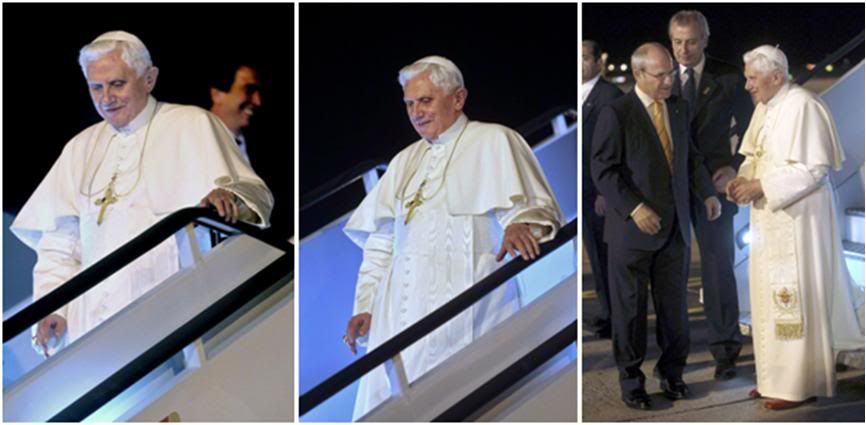
Arriving at the Archbishop's Palace where he is spending the night, the Pope addressed a sizable crowd that had gathered to await his arrival.
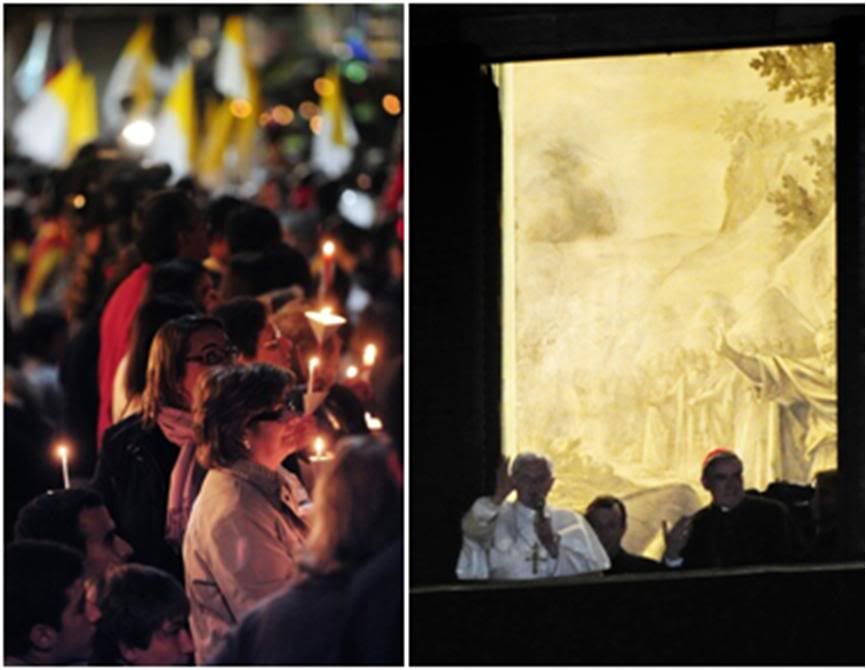
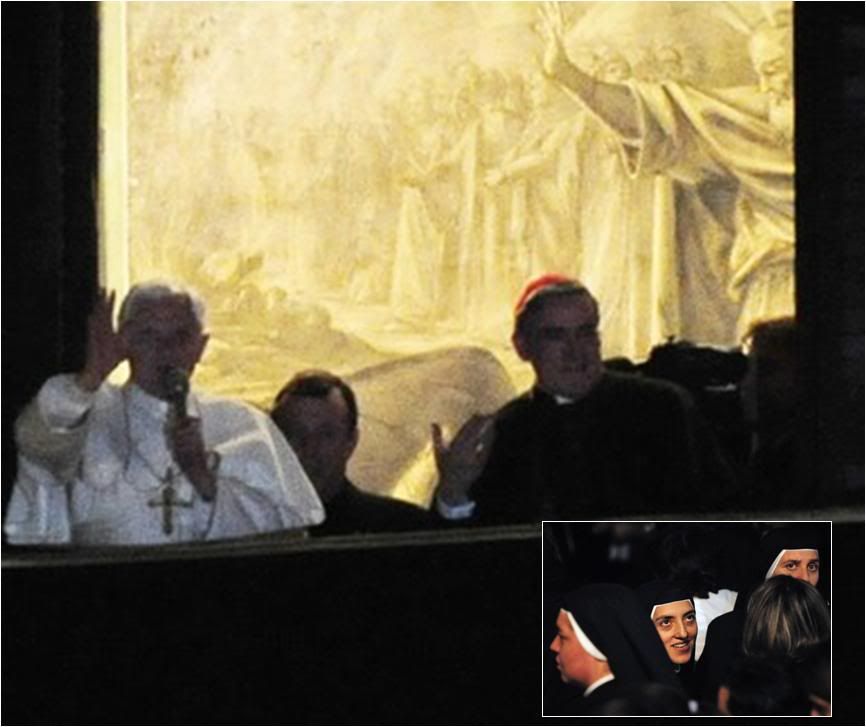
Earlier, there had been another demonstration by dozens of highly secular protesters who oppose everything from the Church's teachings to the cost of the Pope's visit.
The Pope's day starts early tomorrow. He will leave the Archbishop's Palace, located near the Barcelona cathedral, at 9 a.m. to ride teh Popemobile from the Gothic quarter to the Sagrada Familia in the middle of Barcelona's 19th-century extension.
He will meet with the King and Queen of Spain at the church before the 10:00 Mass at which he will consecrate Antonio Gaudi's architectural masterpiece.
|
| |
 07/11/2010 14:01 07/11/2010 14:01 |
|
| | | OFFLINE | | Post: 21.394
Post: 4.030 | Registrato il: 28/08/2005
Registrato il: 20/01/2009 | Administratore | Utente Master | |
|


 On pilgrimage
On pilgrimage
Editorial
by Giovanni Maria Vian
Translated from the 11/7/10 issue of


The trip to Spain by Benedict XVI expresses symbolically the most profound reality of the itineraries that the Bishop of Rome carries out in the world.
The Pope himself said this in his now usual encounter with journalists, on the flight which brought him to Santiago de Compostela, when he recalled that pilgrimage - inscribed in his own personal biography, having passed through several German universities - represents the experience of every believer.
In the inevitable instability of life and in man's passage through this world, faith is, in fact, first of all, a pilgrimage, expressed for the believer by the exemplary figure of Abraham.
In the Middle Ages, the various roads to Compostela - that 'milky way' indicated in the skies by the white light of the stars - spiritually shaped Europe. [Compostela is derived from Latin words which mean 'field of stars', referring to the vision by which a medieval peasant discovered the site where the remains of the Apostle James were buried, after his martyrdom in Judea. Disciples are believed to have taken him back to Iberia, where he was believed to have brought the Gospel earlier.]
Even today, the roads to Compostela are travelled by those who undertake the pilgrimage - or simply, wich to take the route - in order to render virtual embrace to Santiago, the Apostle James the Greater, and in this way, allow oneself to be embraced by God himself.
And that is what the Pope himself did, in that great Romanesque and baroque Cathedral perfumed by the incense from its famous giant 'botafumeiro' (thurible) - a pilgrim like so many others in history and in the present day, in a continent and a world which have often seemed to have forgottoen God, for whom, in truth, they feel nostalgia.
In the Pope's view, in fact, pilgrimage means exactly this: to step out of our daily life and from ultilitarian logic, and transcend them to find a new freedom.
Between Santiago and Barcelona - dominated by the spires of Sagrada Familia - the Pope's itinerary this weekend moves between tradition and creative renewal, between truth and beauty, according to the dynamic expressed in such an admirable and visionary manner by Antoni Gaudi in the expiatory temple that he worked on all his life.
The edifice, whose consecration occasions the Pope's visit to Barcelona, was born from the 19th-century devotion to St. Joseph (the Pope's baptismal patron saint) and to the Holy Family. Even today, it expresses in art the centrality and the importance of the family as an institution, an important reality not just for Catholics but for all of society which is founded on the family.
If the quest for the encounter bweetn faith and art, parallel to that between faith and reason, has marked Christian history since its early centuries - a task that remains urgent in the tormented panorama of our time, the Pope told the newsmen - the quest today for the Church in the Western secularized world ought to be that between faith and secularism, which, in many European nations, as in Spain today, in order to overcome the logic of confrontation that has prevailed in various times during the 19th and 20th centuries and that has often rekindled intolerance.
The circumstance of this return to Spain by Benedict XVI is striking, after his visit to Valencia in 2006 and amid preparations for World Youth Day in Paris next year.
The Pope said it was a sign of his love for Spain, underscoring that the circumstances of all three trips demonstrate a profound reality in common: the actual power and dynamism of faith in a land that is historically Christian.
Spain, which in the 16th century provided the Church with 'a constellation of great saints', has been able to give rise to a modern Catholicism which now aims to propose the Christian way in the perspective of a 'universality without bounds' represented by Compostela, which in the Middle Ages, was the virtual finis terrae, the extreme limit of earth.
For all this, the Bishop of Rome, welcomed with a warmth that dissipated the autumnal fog in Santiago, continues his pilgrimage in the communion of the Church.
Other photos from the 11/7/10 issue of OR:
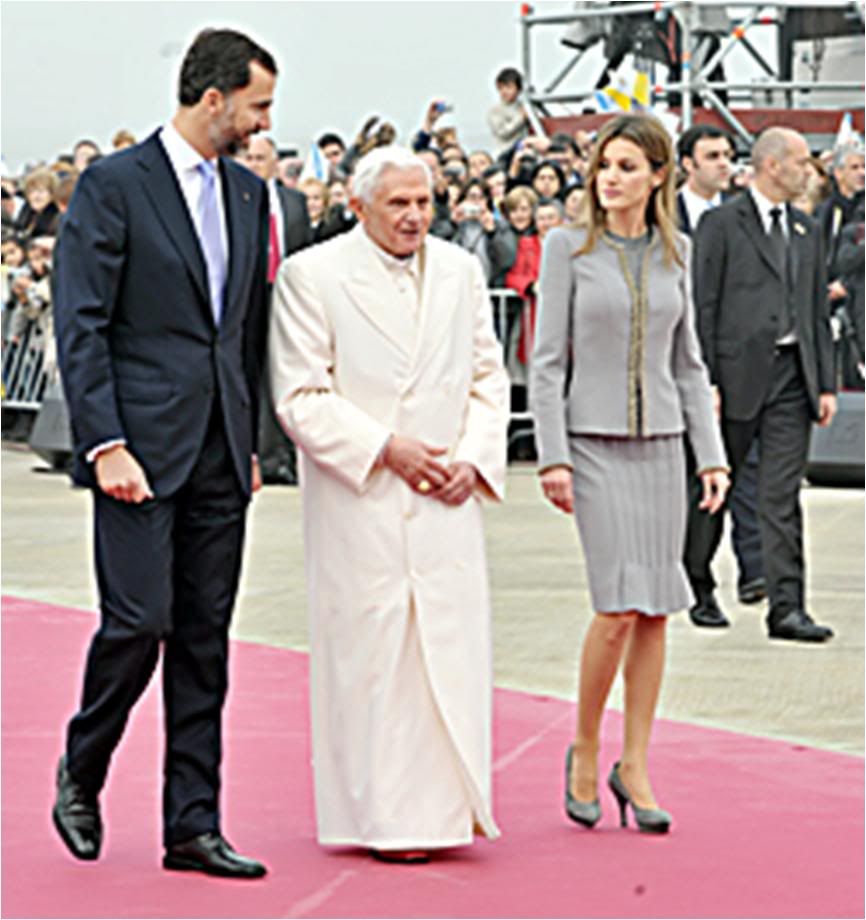
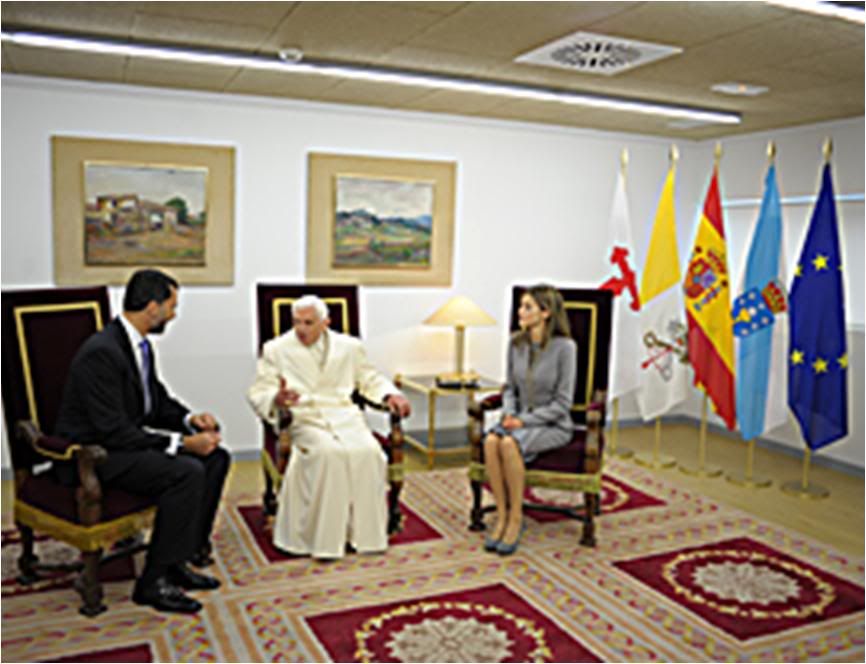

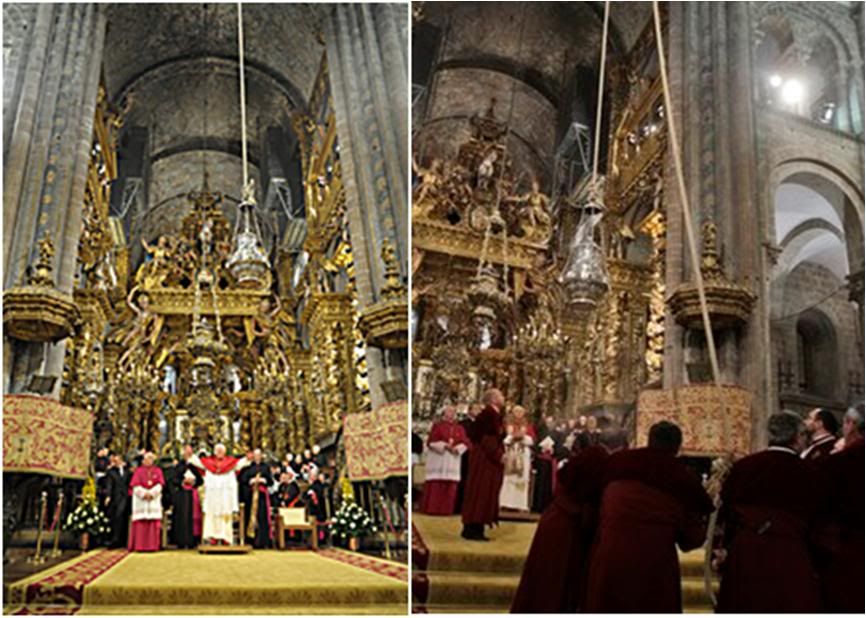 Vatican Radio's online mini-slideshow of major papal events - discarded in the English and Italian services but still used in the Spanish, French and German services - has a couple of pictures that I have not seen elsewhere.
Vatican Radio's online mini-slideshow of major papal events - discarded in the English and Italian services but still used in the Spanish, French and German services - has a couple of pictures that I have not seen elsewhere.
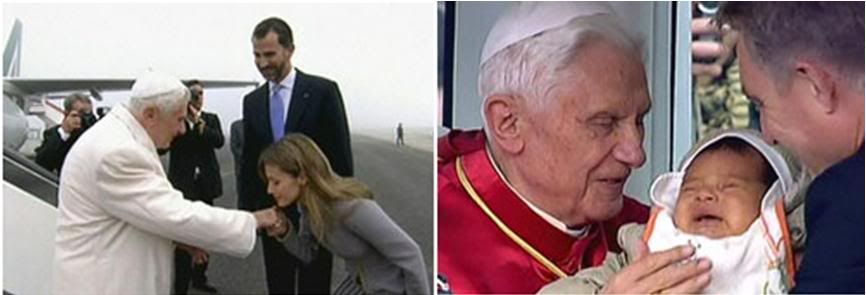 The following two were taken upon his arrival at the Catehdral, where he prayed first at the Chapel of the Holy Sacrament and then at the tomb of St. James:
The following two were taken upon his arrival at the Catehdral, where he prayed first at the Chapel of the Holy Sacrament and then at the tomb of St. James:

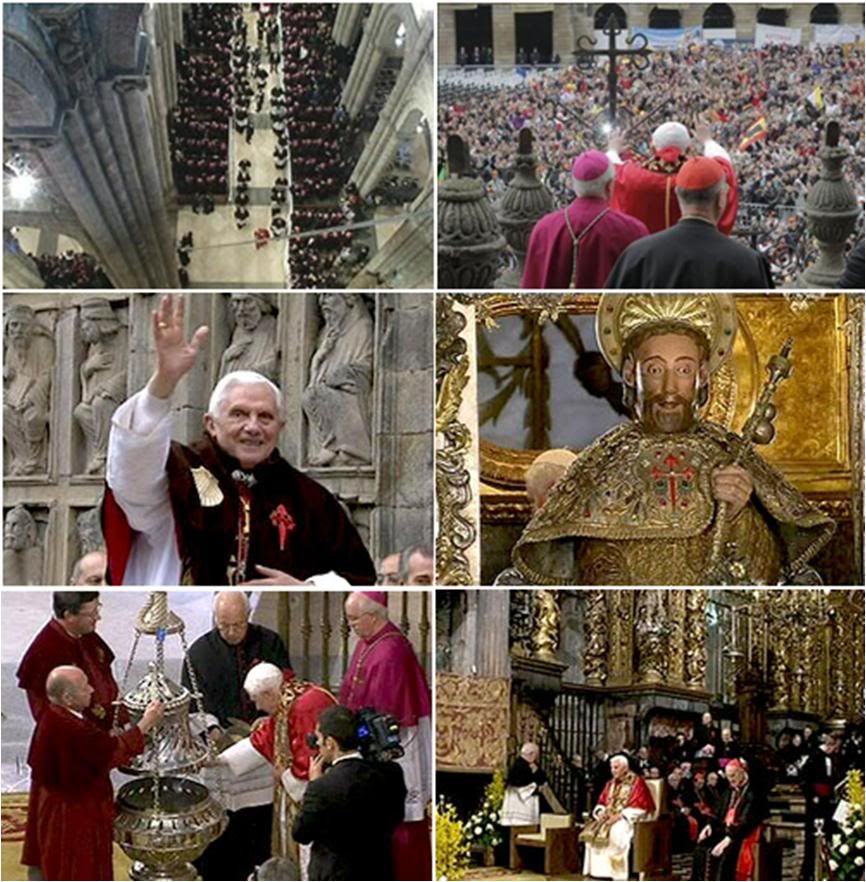 Above panel, top row: The Holy Father walks through the nave of the Cathedral to the Portal of Glory, where he greets the faithful. Second row: He greets them again after donning the pilgrim capelet, then returns inside to pay the traditional homage to the statue of Santiago Apostol. Third row: The Pope puts incense into theg the giant censer (botafumeiro) before it is swung from the ceiling of the catehdral, at the end of a brief liturgy led by the Pope, who also addressed an audience of sick and aged people and their caregivers.
There is a wealth of pictures from Santiago from Spanish websites that I will try to post at least by the time the Holy Father reports on his trip at the Wednesday General Audience.
Above panel, top row: The Holy Father walks through the nave of the Cathedral to the Portal of Glory, where he greets the faithful. Second row: He greets them again after donning the pilgrim capelet, then returns inside to pay the traditional homage to the statue of Santiago Apostol. Third row: The Pope puts incense into theg the giant censer (botafumeiro) before it is swung from the ceiling of the catehdral, at the end of a brief liturgy led by the Pope, who also addressed an audience of sick and aged people and their caregivers.
There is a wealth of pictures from Santiago from Spanish websites that I will try to post at least by the time the Holy Father reports on his trip at the Wednesday General Audience.
[Modificato da TERESA BENEDETTA 08/11/2010 14:21] |
| |
 07/11/2010 14:26 07/11/2010 14:26 |
|
| | | OFFLINE | | Post: 21.396
Post: 4.032 | Registrato il: 28/08/2005
Registrato il: 20/01/2009 | Administratore | Utente Master | |
|
 Papal visit highlights the Catholic vision
Papal visit highlights the Catholic vision
of Spain's most celebrated architect
Barcelona, Spain, Nov 6, 2010 (CNA/EWTN News).- Most of the renowned artists who lived during the last century weren't known for being particularly religious. But while many cultural pioneers were fleeing from faith, Spain's greatest architect was building for God alone.
Pope Benedict XVI will consecrate Antonio Gaudi's masterpiece, Barcelona's Temple of the Holy Family, as a basilica this weekend, honoring the architect who may yet earn the Church's ultimate honor, as he is a candidate for beatification. [There were reports last week that his postulator is checking out a miraacle cure attributed to him by a woman from his hometown of Reus.]
The Sagrada Familia, Gaudi's final and greatest work, has been under construction for more than a century. Dwarfing many surrounding buildings in the urban center, it will become the tallest church in the world when completed.
Already long acknowledged as a masterpiece, it displays the architect's unusual combination of influences: the beauty of nature, the significance of tradition, his Catalan heritage, and his own complete originality. Most of all, however, it testifies to the faith that shaped Gaudi's life.
Antonio Gaudi was born on June 25, 1852, and baptized the next day at the Church of St. Peter in the town of Reus. Afflicted with poor health in his youth, he developed a keen eye for observing the natural world and the forms of living things. He excelled at geometry, and attended a school known for its strong Christian faith and Marian devotion.
His gifts as an illustrator and draftsman gradually came to light – along with some of his artistic and personal idiosyncrasies. The young Gaudi opened his mind to many new stylistic influences that were emerging ,as the rigid forms of 19th century classicism began to fade. At the same time, he also embraced his Catalan identity and its aesthetic influence.
Initially working in a neo-Gothic style influenced by English revivalists, he came to incorporate increasingly unusual contours, mimicking nature and the human body.
Gaudi's stylistic innovations both amazed and baffled Barcelona, sometimes simultaneously. His last “secular” project, the Casa Mila, resembles a wavy set of cliffs. Its balconies look like abstract iron corollaries to the trees on the streets below. The sculptural forms atop the roof resemble anthills, human faces, and castle ornamentation. Virtually every signifier of Gaudi's indefinable style was there; he had hit his artistic stride.
That building was Gaudi's last completed secular project. He had already begun work, in 1883, on a project he did not expect to see completed in his lifetime. From 1914 to his death in 1926, he worked exclusively on the Temple of the Holy Family. Gaudi's consuming project summoned all of his artistic talent, in a single act of faith.
Combining his love of ornamentation and grandeur with the fruits of prayer and theological meditations, Gaudi's church is clearly more traditional than most of his other later works. But its unusual arch shapes, brightly-colored spires, and authoritative yet joyous-looking towers clearly reflect the artist's own vision. He hoped that other architects, designing future churches, would look upon it as the beginning of an entirely new style – albeit one harmonious with the past.
Gaudi did not worry about the time it would take to complete the cathedral. “My client,” he famously remarked, “is not in a hurry.” But the public noticed how he seemed to disappear into the work, withdrawing from public life and living on the premises of the unfinished church.
Once known as a dashing and stylish young man, the unmarried architect now became known as a sort of hermit. But he did not cease to visit the Church of St. Philip Neri, where he prayed for some time every night.
When a group of students from his old primary school visited the unfinished cathedral, Gaudi explained to them that the work was an expression of what he had learned as a child: “the divine history of the salvation of man through Christ incarnate, given to the world by the Virgin Mary.”
Gaudi died in 1926, after a tragic accident in which he was run over by a trolley car. Mistaking him for a beggar, the driver did not stop to help him. Once taken to the hospital and recognized, Gaudi refused any preferential treatment, saying his place was “here among the poor.”
When he died of complications from the accident, three of the cathedral's eastern towers, and one of its three planned facades, were complete. The current builders expect its full completion in 2026, the centenary of Gaudi's death. Millions of visitors to Barcelona have already toured the cathedral. Revenue from visitors is expected to cover the remaining work on the main facade and sacristies, as well as the completion of its central tower.
As Pope Benedict prepares to consecrate Gaudi's masterpiece as a basilica, dedicating its altar and celebrating the first Mass, the architect himself is a candidate for beatification.
A small group of laymen with a miniscule budget decided to investigate the possibility in 1992, and the cause for the canonization of Antonio Gaudi was sent on to Rome in 2003, after completion of the diocesan phase of investigation.
In another famous poetic comment on the ambitious scale of the Cathedral of the Holy Family, Gaudi once remarked that St. Joseph –Christ's foster father, “the carpenter” – would accomplish the completion of this house for Jesus and Mary.
In this, perhaps Gaudi was prescient. Pope Benedict XVI - who is both a devotee of St. Joseph, and named for him (as Joseph Ratzinger)– will dedicate it as a basilica, when he comes to Barcelona tomorrow.
[Gaudi's devotion to St. Joseph was such that he planned the seven chapels surrounding the main altar in the rear apse to be dedicated to the Seven Sorrows of Joseph. The Nativity facade shows Joseph in .... scenes: The betrothal to Mary, the Nativity itself, the presentation in the temple, the flight to Egypt, finding Jesus in Jerusalem, and watching the youth Jesus seated at a carpenter's bench. A listing of all the sculptural groupings on the Nativity facade includes something labelled "Saint Joseph protecting the Church (presented as a boat").]
[Modificato da TERESA BENEDETTA 12/11/2010 12:04] |
| |
 07/11/2010 14:26 07/11/2010 14:26 |
|
| | | OFFLINE | | Post: 21.397
Post: 4.033 | Registrato il: 28/08/2005
Registrato il: 20/01/2009 | Administratore | Utente Master | |
|
 November 7, 32nd Sunday in Ordinary Time
November 7, 32nd Sunday in Ordinary Time ST. DIEGO DE ALCALA (Spain, 1400-1463), Franciscan friar and miracle worker
ST. DIEGO DE ALCALA (Spain, 1400-1463), Franciscan friar and miracle worker
Fittingly, today's saint is one of the most beloved of Spanish saints, for whom the Franciscans named their California mission, now the city of San Diego. Born to poor parents, he mas raised by a hermit and joined the Franciscan lay order at 17. He was first assigned to Fuenteventura in the Canary Islands, as guardian of teh Franciscan community and then, because of his great zeal and personal sanctity, as superior of the Convent of San Buenaventura, even if he was just a lay brother. In 1449, he was sent to Rome for teh canonization of St. Bernardino of Siena, where he served as infirmarian at the convent of Ara Coeli. His biographers recorded many miraculous cures attributed to him. When he was recalled to Spain, he spent his remaining years in penance, solitude and contemplation at a convent in Alcala de Henares. He died of an abscess, which emitted fragrance. Indeed, his body remained incorrupt and remained in the odor of sanctity. Two Spanish princes were reported to have been miraculously cured by contact with his body. He is teh subject of a cycle of paintings by Annibale Caracci in the Roman church dedicated to Santiago, and by a series of paintings by Esteban Murillo in the 17th century. His most famous portrait is by Francisco Zurbaran. Diego was canonized in 1588.
Readings for today's Mass:
www.usccb.org/nab/110710.shtml
OR today.

Benedict XVI's second visit to Spain begins in Santiago de Compostela, where he says:
'Faith and secularity can meet each other in Europe'
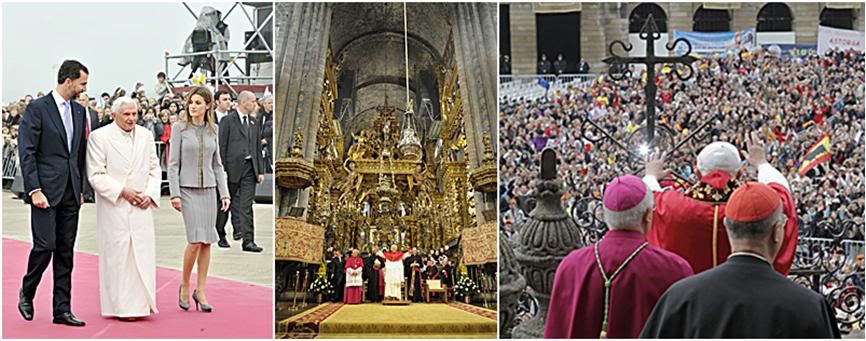 Sunday, November 7
Sunday, November 7
The issue covers the first half of the Holy Father's day in Santiago, with an event-filled visit to the Cathedral as a pilgrim (in the photo above, he wears a capelet version of the traditional Compostelan pilgrim cloak). Other Page 1 news: The International Monetary Fund approves new laws giving more weight in its decisions to China and the emergent economies of Brazil, India and Russia; President Obama starts a 10-day Asian trip to India, Indonesia, South Korea and Japan, in Mumbai, where he and his delegation stay at the hotel famously bombed by terrorists in 2008.
THE POPE'S DAY

Sunday, November 7
09.30 PRIVATE MEETING WITH THEIR MAJESTIES THE KING AND QUEEN OF SPAIN
Sala Museala, Templo Expiatorio de la Sagrada Familia
10.00 HOLY MASS and Dedication of the Church of Sagrada Familia and its altar
- Homily by the Holy Father
- ANGELUS led by the Holy Father
- Remarks by the Holy Father
13.00 Lunch with Cardinals and Bishops and the papal delegation
Archbishop's Residence
16.30 Farewell from the Archbishop's Residence
17.15 VISIT TO THE "OBRA BENEFICO-SOCIAL NEN DÉU"
- Greeting by the Holy Father
18.30 FAREWELL CEREMONY, International Airport of Barcelona
- Address by the Holy Father
19.15 Departure from the International Airport of Barcelona for Rome
ROME
20.55 Arrival at Ciampino Airport
Spain is one hour ahead of Italian time.
[Modificato da TERESA BENEDETTA 08/11/2010 13:05] |
| |
 07/11/2010 15:14 07/11/2010 15:14 |
|
| | | OFFLINE | | Post: 21.398
Post: 4.034 | Registrato il: 28/08/2005
Registrato il: 20/01/2009 | Administratore | Utente Master | |
|
 AFP has the only MSM news agency account of today's main event that did not lead off by giving equal importance to a major Church event as a demonstration by a hundred couples at most whose militancy in advocating/advertising their private lifestyle has deprived them of every shred of civility and common sense....
Cheers as Pope consecrates
AFP has the only MSM news agency account of today's main event that did not lead off by giving equal importance to a major Church event as a demonstration by a hundred couples at most whose militancy in advocating/advertising their private lifestyle has deprived them of every shred of civility and common sense....
Cheers as Pope consecrates
Barcelona landmark

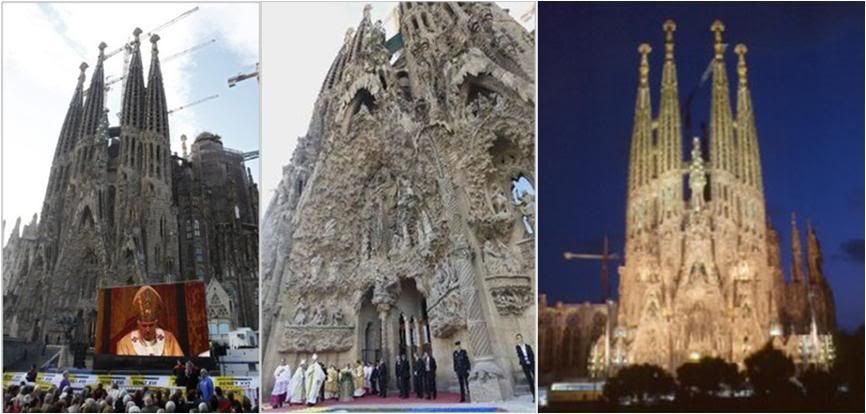
BARCELONA, Nov. 7 (AFP) - Thousands of faithful cheered as Pope Benedict XVI on Sunday concecrated the Sagrada Familia church in Barcelona -- Antonio Gaudi's architectural masterpiece which has come to symbolise the Spanish city.
Crowds of up to five rows deep lined both sides of the street leading to the Basilica, whose eight towers topped with ceramics dominate Barcelona's skyline.
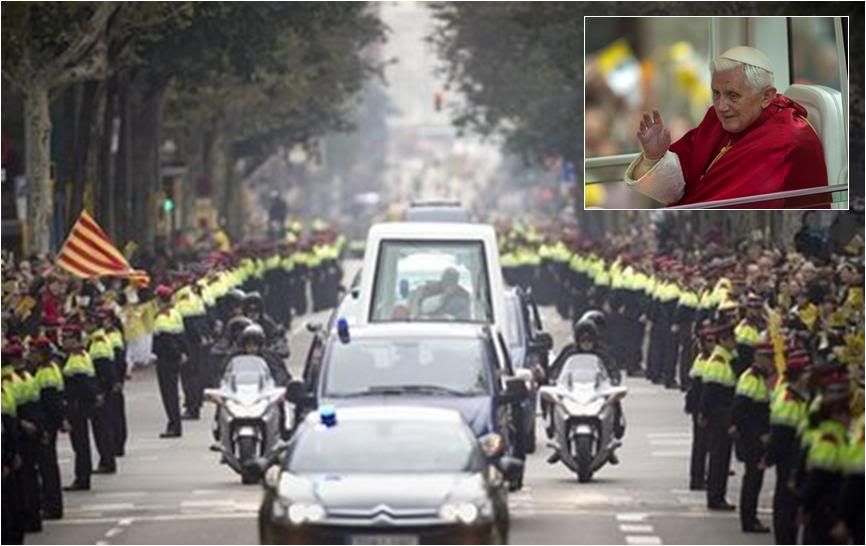
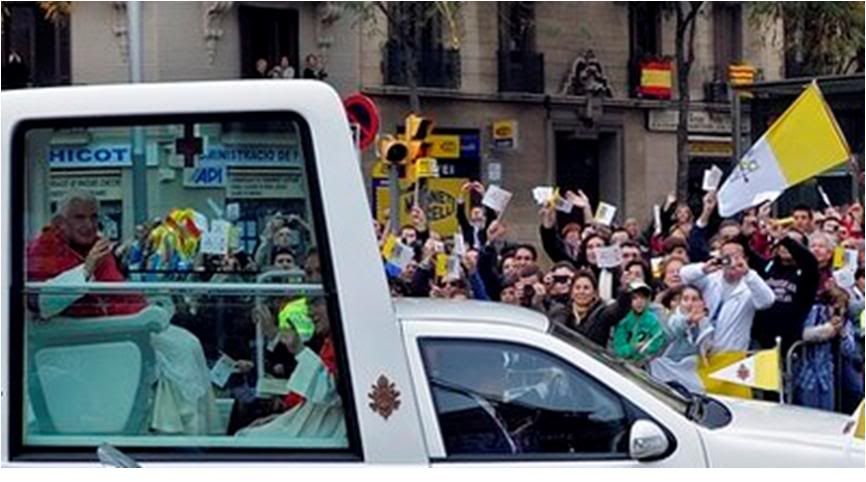
"Yes, yes, yes, the Pope is already here," a group of youths chanted as the pontiff's white popemobile approached. [That chant would be SI, SI, SI - EL PAPA YA ESTA AQUI!]
Adults and children climbed onto window sills to get a better look at the 83-year-old Pope while others snapped pictures on their mobile phones.
"This is really moving. I saw the Pope wave. It is not every day that you see the Pope in person," said 36-year-old Soraya Santamaria after the popemobile passed by.
She had waited for over an hour with her daughter and a female friend who came with her two daughters.
Several streets leading to the church were closed and rows of wooden chairs laid out in front of giant screens that broadcast the mass.
The faithful watching the ceremony outside the church applauded when Benedict sprinkled holy water to consecrate the Sagrada Familia, transforming it into a Basilica.
"This is a historic day for the city, it was important for me to be here," said 55-year-old Joan Asensior who wore a grey hat in the chill.
Signs in the yellow and white of the Vatican flag were hung from several apartments in the streets around the church welcoming the German-born Pontiff with the words: "All with the Pope."
But from many other apartments, often in the same buildings, other banners from an anti-papal movement declared "Jo no t'espero", the Catalan for "I am not waiting for you", along with a red triangle imposed over the pope's profile.
"Homophobia. Hypocrisy. Corruption. Confessional state. Paedophilia. Vatican bank. NO THANK YOU," read one large white and black banner hung from the balcony of an apartment near the Sagrada Familia.
Around 200 gay men and women couples kissed each other in protest against the Church opposition to homosexuality as Benedict's popemobile passed by, breaking off to shout "Get out," and "paedophile".
The Pope celebrated the solemn mass on a 7.5-tonne stone altar, accompanied by hymns from an 800-voice chorus. Hundreds of priests and bishops were among the 6,500 guests inside the church.
Flags from South Korea, Brazil, Colombia and Mexico could be seen among the crowd that surrounded the Sagrada Familia.
"I had to come. I could not stay at home. I have a lot of faith," said Solange Abreu, a 41-year-old Brazilian who lives in Barcelona and who came to the mass with a friend.
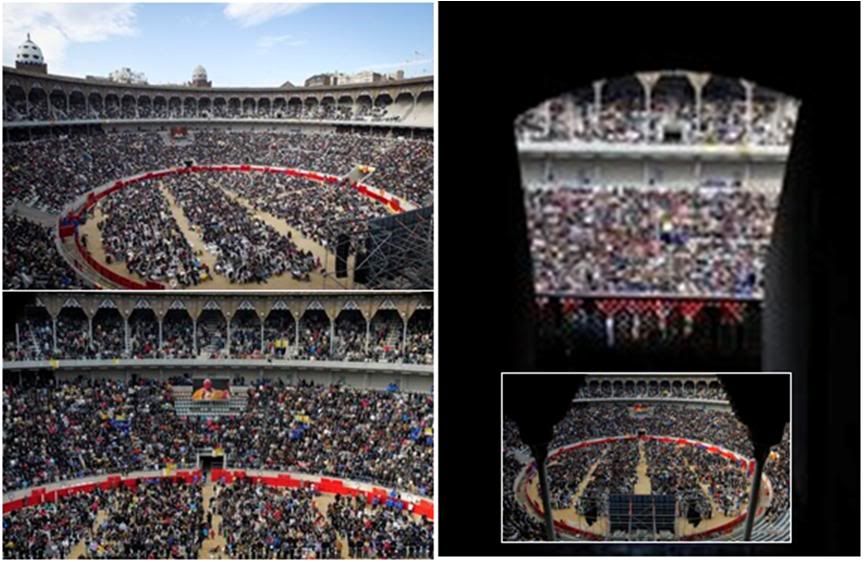 It was the first papal Mass in a bullring! The city of Barcelona had the inspired idea of making its famous Plaza Monumental bullring one of the convenient lcoation for following the events on jumbo TV. The bullring has a capacity of 20,000.
It was the first papal Mass in a bullring! The city of Barcelona had the inspired idea of making its famous Plaza Monumental bullring one of the convenient lcoation for following the events on jumbo TV. The bullring has a capacity of 20,000.
Now that the nave is consecrated, it will be open for daily Mass for the first time since the first stone was laid March 19, 1882. Up until now services were held in the crypt, which houses Gaudi's remains.
The building work could still take another 15 years at least, with 10 more spires to go, including the central tower crowned by a cross reaching up 170 metres (560 feet).
Pope consecrates Gaudi's basilica:
'A hymn of praise in stone'
by Lydia O'Kane in Barcelona

Nov. 7, 2010
On Sunday morning to the chiming of bells, Pope Benedict XVI left the archbishop’s residence in Barcelona making the journey to the Expiatory Temple of the Sagrada Familia, a structure that has been under construction since 1882.
Again as in Santiago de Compostela, people lined the route to the church with banners and waved Vatican, Catalan and Spanish flags; there were even balloons which were launched into the sky in the colours of yellow and white.
Countless years and thousands of hours of work have gone into bringing Gaudi’s masterpiece to this stage and even the last minute preparations for this consecration by the Pope had been painstaking.
The Sagrada Familia is not due to be finished until 2026, but on this Sunday in Barcelona it looked breathtaking both inside and out.
At exactly 10am Pope Benedict entered the soon-to-be Basilica, a place where art intertwines with faith.
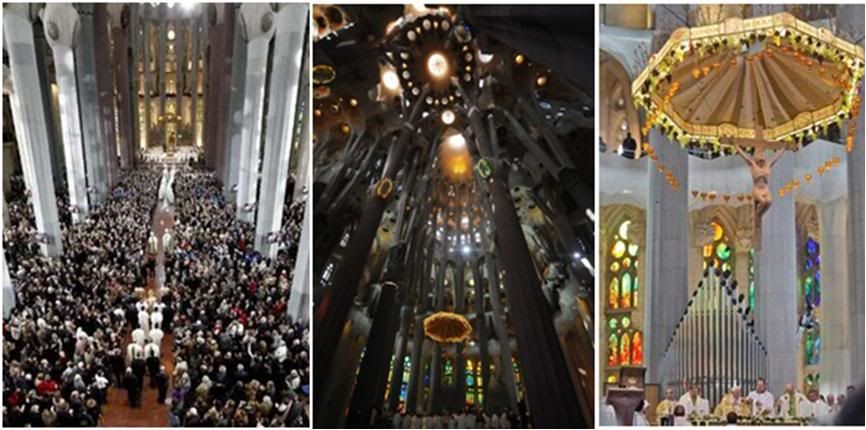
Light shone down from the temple’s sculpted ceiling and penetrated its stained glass windows, and the Pope dressed in gold walked down the nave’s glistening new marble floor in front of 6,500 guests including the King and Queen of Spain.
It seemed at this moment that amidst cheers and applause that the Sagrada Family had really come to life.
Following a greeting by the Cardinal Archbishop of Barcelona Lluis Martinez Sistach, chief architect Jordi Bonet, a man who has devoted much of his life to this temple dedicated to the Holy Family, addressed the Pope in Catalan.
Where the Pope, during his time spent in Santiago de Compostela had focused on the themes of pilgrimage and Christian identity, his words for this consecration of the Sagrada Familia centered on the family, beauty, and the importance of Jesus as a rock.
He began his homily expressing his joy at being able to preside over this ceremony and his happiness that this shrine has a special relationship with St Joseph.
The Pope described the temple’s visionary architect Antoni Gaudi as a man who “as a practicing Christian had kept the torch of his faith alight to the end of his life.” And a man, he added, who made “stones, trees and human life part of the church so that all creation might come together in praise of God.”
Drawing on the theme of building and creating which has been such a part of the Sagrada Familia, the Holy Father called to mind Jesus being the “stone which supports the weight of the world”, and without Christ the Church itself is nothing.
The Pope also noted the importance of the timing of this dedication, saying that it comes at a time when man claims to live his life without God, but he added “with this masterpiece Gaudi shows us that God is the true measure of man.”
In the latter part of his homily the Pope turned his attention to the defence of the family and the dignity of the human person.
He stressed that besides technical, social and cultural advances there also needed to be moral advances as well, such as assistance to families.
The Holy Father brought home to the congregation the need to protect human life from beginning to end, the importance of marriage between a man and a woman and the need for them to be supported in this role.
Pope Benedict ended his homily in Catalan, asking Mary Most Holy to protect this house of God before divesting himself of his gold vestments for the solemn rite of dedication where he poured chrism oil on the four corners of the alter turning this place of beauty into a true place of God, wearing white robes.
At the end of a truly memorable occasion Cardinal Sistach showed off to the assembly the certificate - a papal bull - proclaiming this temple a Basilica. Then Pope Benedict left the basilica briefly by one of its side portals to lead Angelus prayers before pilgrims gathered outside the church.
The Pope told them that it had given him great satisfaction to declare this church a Minor Basilica, a place where men and women of every continent can contemplate this catechism in stone - a work by which Gaudi sought to bring the Gospel to everyone.

NB: A later RV report said at least 300,000 turned out in Barcelona Sunday for the Pope, including teh 50,000 who had tickets for the seats set up by the Archdiocese around the Cathedral.
[Modificato da TERESA BENEDETTA 09/11/2010 10:16] |
| |
 07/11/2010 15:33 07/11/2010 15:33 |
|
| | | OFFLINE | | Post: 21.399
Post: 4.035 | Registrato il: 28/08/2005
Registrato il: 20/01/2009 | Administratore | Utente Master | |
|
 HOLY MASS TO CONSECRATE
HOLY MASS TO CONSECRATE
THE BASILICA OF LA SAGRADA FAMILIA
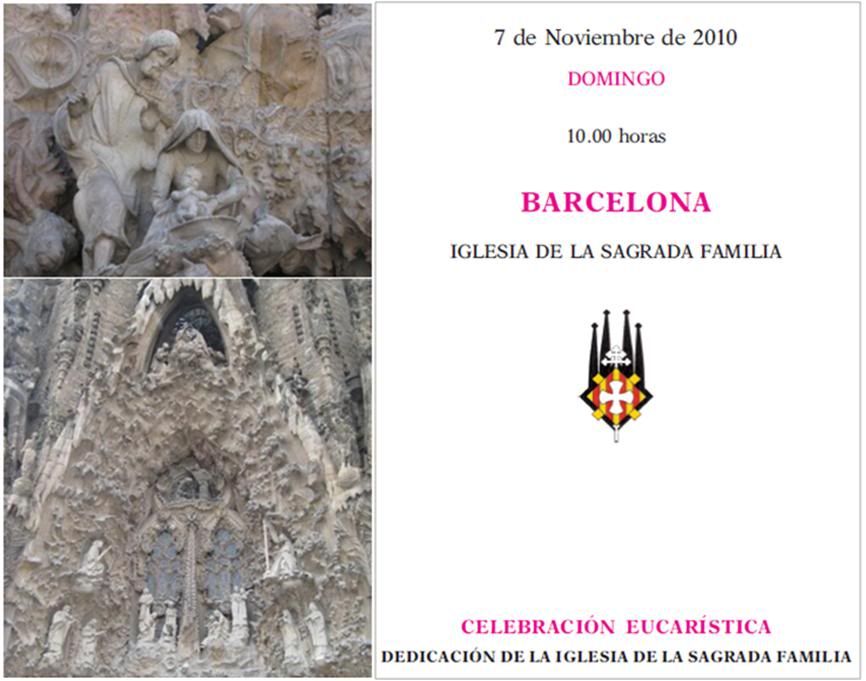
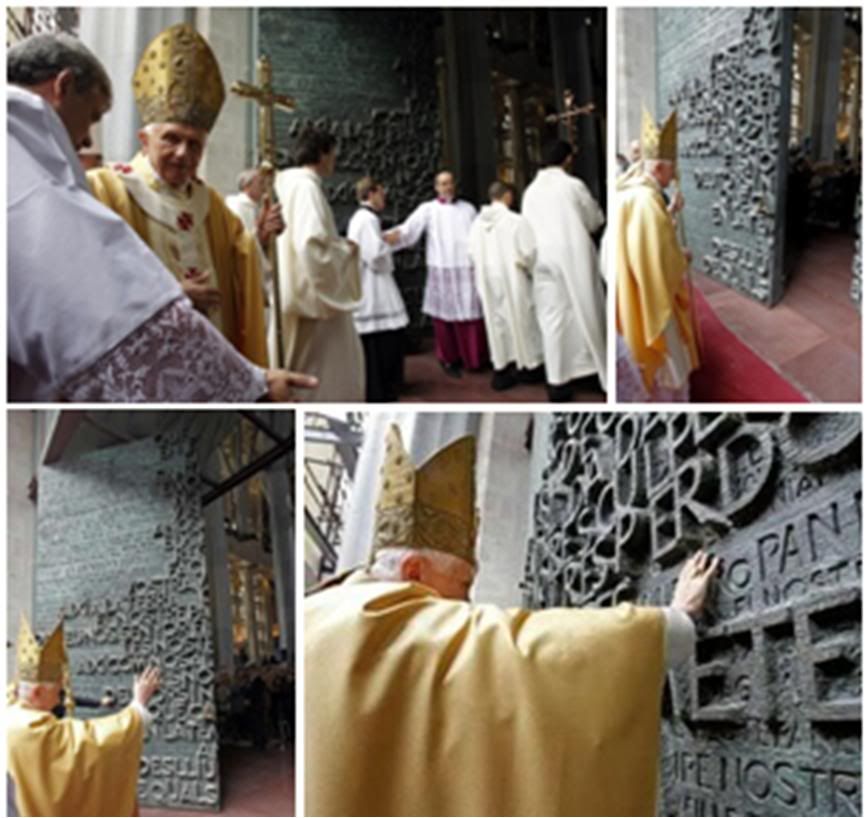
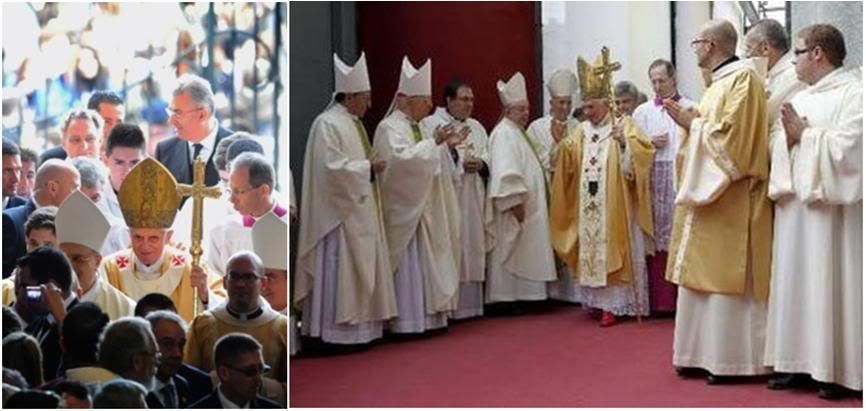
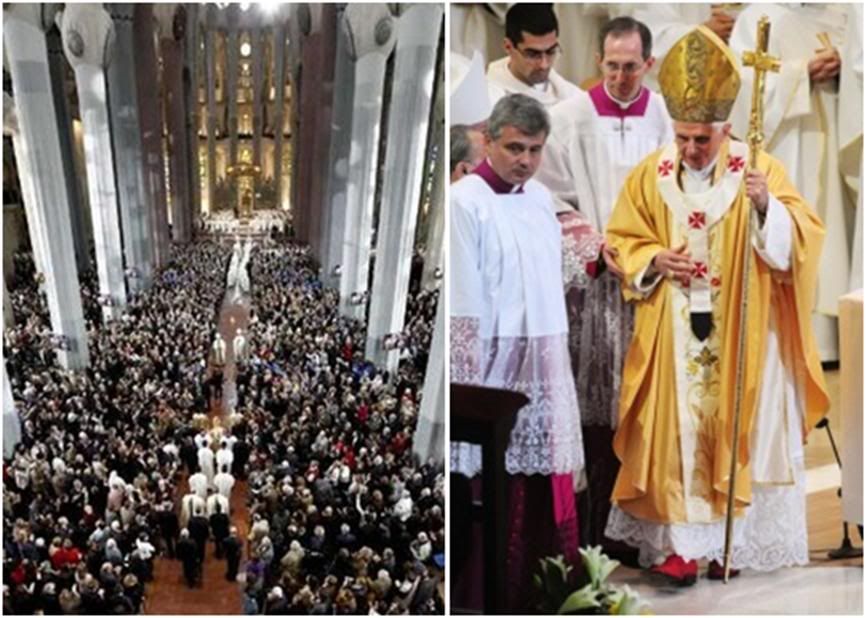
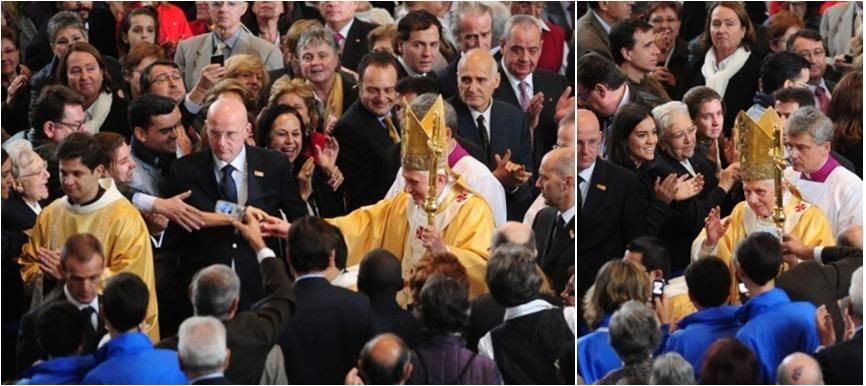

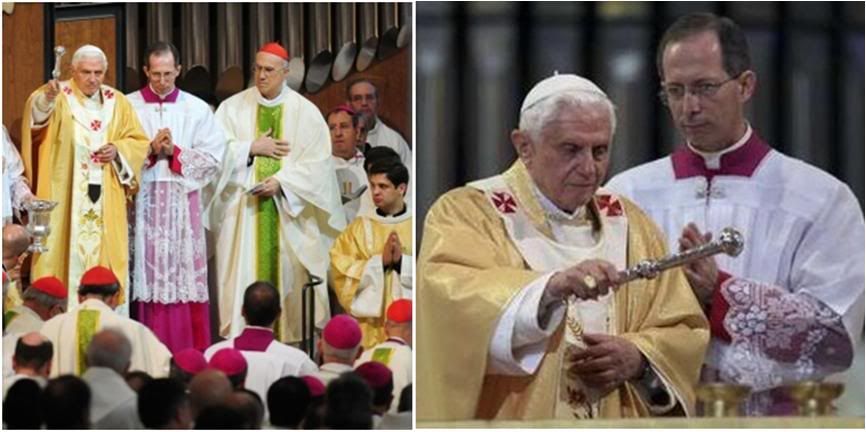
 THE HOLY FATHER'S HOMILY
THE HOLY FATHER'S HOMILY
Barcelona
Sunday, 7 November 2010
[In Catalan:] Dear Brothers and Sisters in the Lord,
“This day is holy to the Lord your God; do not mourn or weep. … The joy of the Lord is your strength” (Neh 8:9-11).
With these words from the first reading that we have proclaimed, I wish to greet all of you taking part in this celebration.
I extend an affectionate greeting to their Majesties the King and Queen of Spain who have graciously wished to be with us.
I extend a thankful greeting to Cardinal Lluís Martínez Sistach, Archbishop of Barcelona, for his words of welcome and for his invitation to me to dedicate this Church of the Sagrada Familia, a magnificent achievement of engineering, art and faith.
I also greet Cardinal Ricardo María Carles Gordó, Archbishop Emeritus of Barcelona, the other Cardinals present and my brother bishops, especially the auxiliary bishop of this local church, and the many priests, deacons, seminarians, religious men and women, and lay faithful taking part in this solemn ceremony.
I extend a respectful greeting to the national, regional and local authorities present, as well as to the members of other Christian communities, who share in our joy and our grateful praise of God.
Today marks an important step in a long history of hope, work and generosity that has gone on for more than a century. At this time I would like to cite each and every one of those who have made possible the joy that fills us today, from the promoters to the executors of this work, the architects and the workers, all who in one way or another have given their priceless contribution to the building of this edifice.
We remember, of course the man who was the soul and the artisan of this project, Antoni Gaudí, a creative architect and a practising Christian who kept the torch of his faith alight to the end of his life, a life lived in dignity and absolute austerity.
This event is also in a certain sense the high point of the history of this land of Catalonia which, especially since the end of the nineteenth century, has given an abundance of saints and founders, martyrs and Christian poets. It is a history of holiness, artistic and poetic creation, born from the faith, which we gather and present to God today as an offering in this Eucharist.
The joy which I feel at presiding at this ceremony became all the greater when I learned that this shrine, since its beginnings, has had a special relationship with Saint Joseph.
I have been moved above all by Gaudí’s confidence when, in the face of many difficulties, filled with trust in divine Providence, he would exclaim, “Saint Joseph will finish this church”. So it is significant that it is also being dedicated by a Pope whose baptismal name is Joseph.
What do we do when we dedicate this church? In the heart of the world, placed before God and mankind, with a humble and joyful act of faith, we raise up this massive material structure, fruit of nature and an immense achievement of human intelligence which gave birth to this work of art.
It stands as a visible sign of the invisible God, to whose glory these spires rise like arrows pointing towards absolute light and to the One who is Light, Height and Beauty itself.
In this place, Gaudí desired to unify that inspiration which came to him from the three books which nourished him as a man, as a believer and as an architect: the book of nature, the book of sacred Scripture and the book of the liturgy.
In this way he brought together the reality of the world and the history of salvation, as recounted in the Bible and made present in the liturgy. He made stones, trees and human life part of the church so that all creation might come together in praise of God, but at the same time he brought the sacred images outside so as to place before people the mystery of God revealed in the birth, passion, death and resurrection of Jesus Christ.
In this way, he brilliantly helped to build our human consciousness, anchored in the world yet open to God, enlightened and sanctified by Christ.
In this he accomplished one of the most important tasks of our times: overcoming the division between human consciousness and Christian consciousness, between living in this temporal world and being open to eternal life, between the beauty of things and God as beauty.
Antoni Gaudí did this not with words but with stones, lines, planes, and points. Indeed, beauty is one of mankind’s greatest needs; it is the root from which the branches of our peace and the fruits of our hope come forth. Beauty also reveals God because, like him, a work of beauty is pure gratuity; it calls us to freedom and draws us away from selfishness.
We have dedicated this sacred space to God, who revealed and gave himself to us in Christ so as to be definitively God among men. The revealed Word, the humanity of Christ and his Church are the three supreme expressions of his self-manifestation and self-giving to mankind.
As Saint Paulsays in the second reading: “Let each man take care how he builds. For no other foundation can anyone lay than that which is laid, which is Jesus Christ” (1 Cor 3:10-11).
The Lord Jesus is the stone which supports the weight of the world, which maintains the cohesion of the Church and brings together in ultimate unity all the achievements of mankind. In him, we have God’s word and presence and from him the Church receives her life, her teaching and her mission.
The Church of herself is nothing; she is called to be the sign and instrument of Christ, in pure obedience to his authority and in total service to his mandate.
The one Christ is the foundation of the one Church. He is the rock on which our faith is built. Building on this faith, let us strive together to show the world the face of God who is love and the only one who can respond to our yearning for fulfilment.
This is the great task before us: to show everyone that God is a God of peace not of violence, of freedom not of coercion, of harmony not of discord.
In this sense, I consider that the dedication of this church of the Sagrada Familia is an event of great importance, at a time in which man claims to be able to build his life without God, as if God had nothing to say to him.
In this masterpiece, Gaudí shows us that God is the true measure of man; that the secret of authentic originality consists, as he himself said, in returning to one’s origin which is God.
Gaudí, by opening his spirit to God, was capable of creating in this city a space of beauty, faith and hope which leads man to an encounter with him who is truth and beauty itself. The architect expressed his sentiments in the following words: “A church [is] the only thing worthy of representing the soul of a people, for religion is the most elevated reality in man”.
This affirmation of God brings with it the supreme affirmation and protection of the dignity of each and every man and woman: “Do you not know that you are God’s temple? … God’s temple is holy, and you are that temple” (1 Cor 3:16-17).
Here we find joined together the truth and dignity of God and the truth and dignity of man. As we consecrate the altar of this church, which has Christ as its foundation, we are presenting to the world a God who is the friend of man and we invite men and women to become friends of God. This is what we are taught in the case of Zacchaeus, of whom today’s gospel speaks (Lk 19:1-10), if we allow God into our hearts and into our world, if we allow Christ to live in our hearts, we will not regret it: we will experience the joy of sharing his very life, as the object of his infinite love.
This church began as an initiative of the Association of the Friends of Saint Joseph, who wanted to dedicate it to the Holy Family of Nazareth.
The home formed by Jesus, Mary and Joseph has always been regarded as a school of love, prayer and work. The promoters of this church wanted to set before the world love, work and service lived in the presence of God, as the Holy Family lived them.
Life has changed greatly and with it enormous progress has been made in the technical, social and cultural spheres. We cannot simply remain content with these advances. Alongside them, there also need to be moral advances, such as in care, protection and assistance to families, inasmuch as the generous and indissoluble love of a man and a woman is the effective context and foundation of human life in its gestation, birth, growth and natural end.
Only where love and faithfulness are present can true freedom come to birth and endure. For this reason the Church advocates adequate economic and social means so that women may find in the home and at work their full development, that men and women who contract marriage and form a family receive decisive support from the state, that life of children may be defended as sacred and inviolable from the moment of their conception, that the reality of birth be given due respect and receive juridical, social and legislative support.
For this reason the Church resists every form of denial of human life and gives its support to everything that would promote the natural order in the sphere of the institution of the family.
As I contemplate with admiration this sacred space of marvellous beauty, of so much faith-filled history, I ask God that in the land of Catalonia, new witnesses of holiness may rise up and flourish, and present to the world the great service that the Church can and must offer to humanity: to be an icon of divine beauty, a burning flame of charity, a path so that the world may believe in the One whom God has sent (cf. Jn 6:29).
Dear brothers and sisters, as I dedicate this splendid church, I implore the Lord of our lives that, from this altar, which will now be anointed with holy oil and upon which the sacrifice of the love of Christ will be consumed, there may be a flood of grace and charity upon the city of Barcelona and its people, and upon the whole world. May these fruitful waters fill with faith and apostolic vitality this archdiocesan Church, its pastors and its faithful.
[In Catalan:] Finally, I wish to commend to the loving protection of the Mother of God, Mary Most Holy, April Rose, Mother of Mercy, all who enter here and all who in word or deed, in silence and prayer, have made this possible this marvel of architecture. May Our Lady present to her divine Son the joys and tribulations of all who come in the future to this sacred place so that here, as the Church prays when dedicating religious buildings, the poor may find mercy, the oppressed true freedom and all men may take on the dignity of the children of God. Amen.
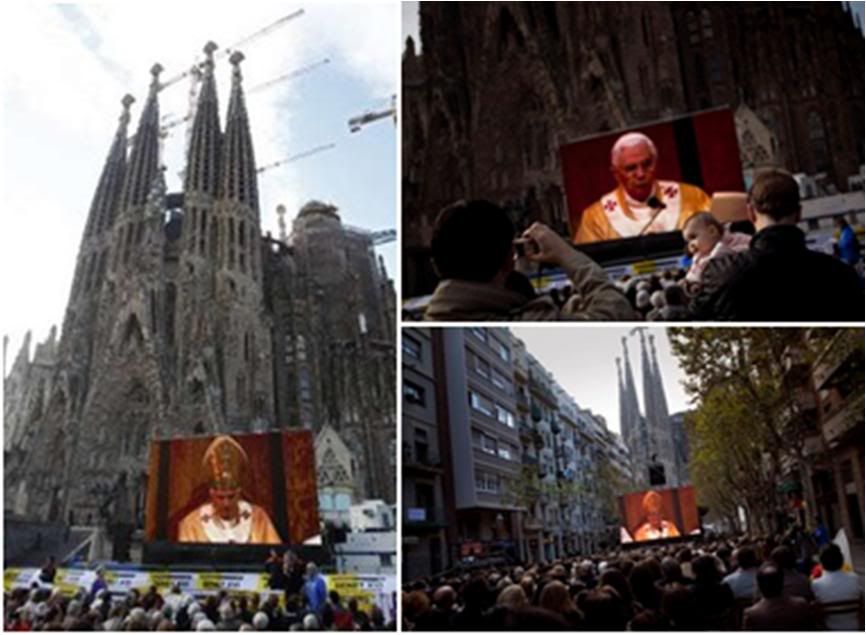
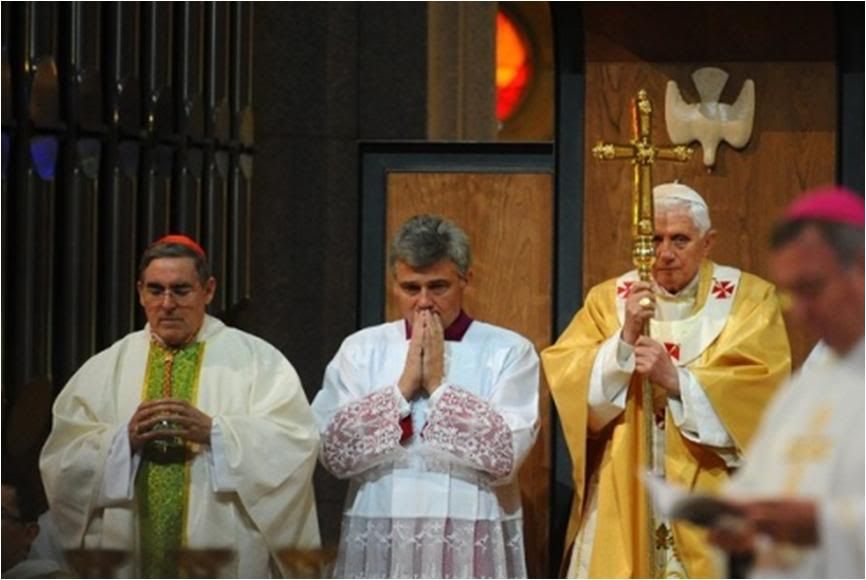 The church consecration rtte took place after the Credp. It started with theLitany of Saints intoned in Catalan, then the Holy FAther's prayer dedicating the Church. He then took off his chasuble to don a liturgical apron before anointing the altar top thoroughly from one end to the other with Holy Chrism. Ten bishops then proceeded to anoint the walls of the Church, in 10 representative spots marked by a wreath and a wooden cross. [No nedws agency photos, unfortunately].
The church consecration rtte took place after the Credp. It started with theLitany of Saints intoned in Catalan, then the Holy FAther's prayer dedicating the Church. He then took off his chasuble to don a liturgical apron before anointing the altar top thoroughly from one end to the other with Holy Chrism. Ten bishops then proceeded to anoint the walls of the Church, in 10 representative spots marked by a wreath and a wooden cross. [No nedws agency photos, unfortunately].
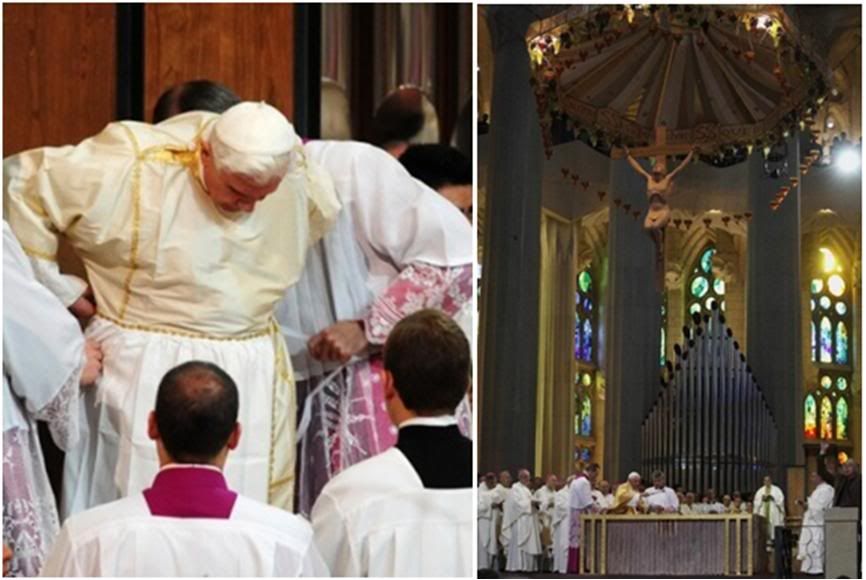
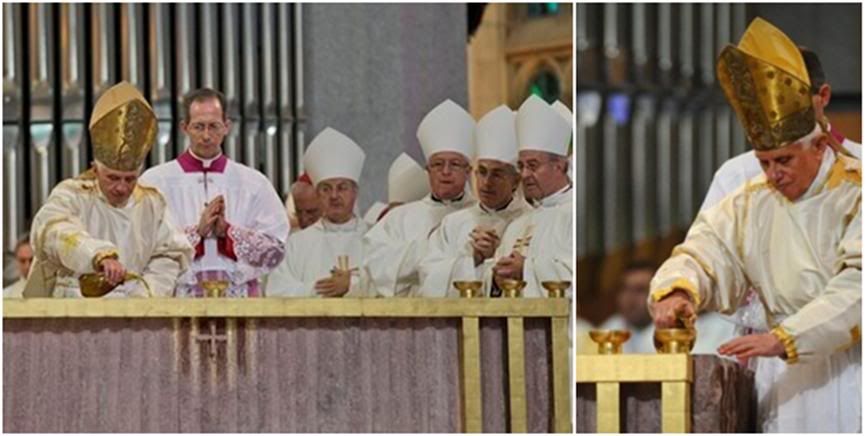
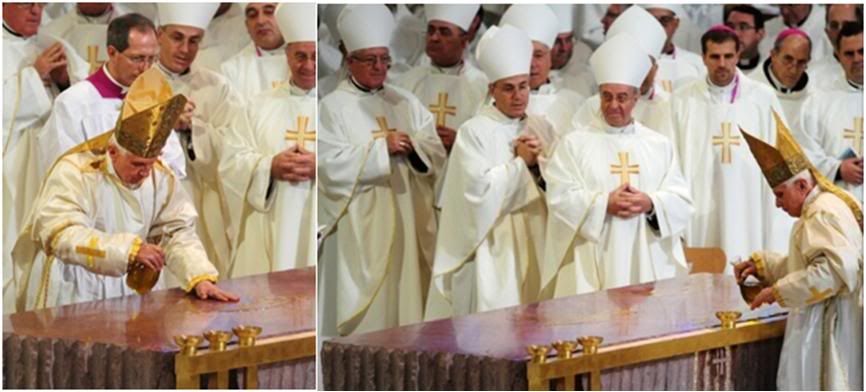 Next, the altar was incensed from a braziere with burning incense.
Next, the altar was incensed from a braziere with burning incense.
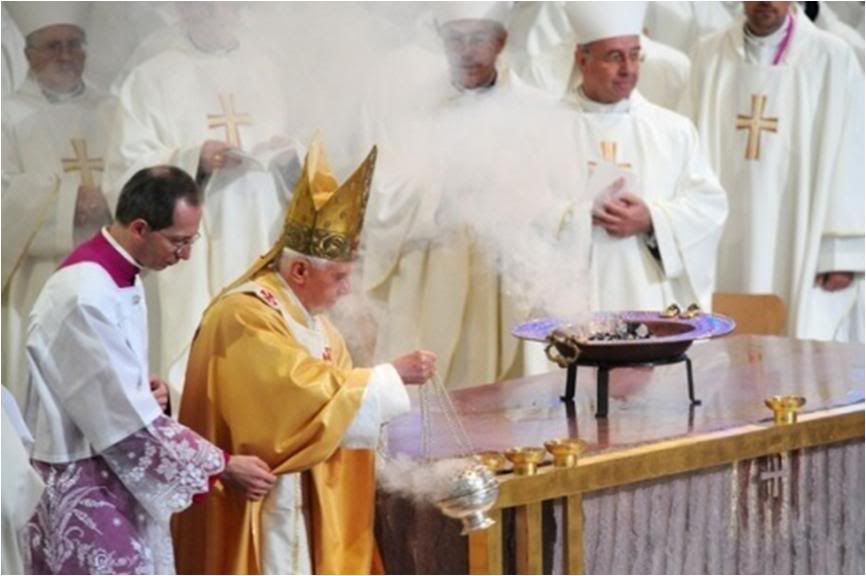
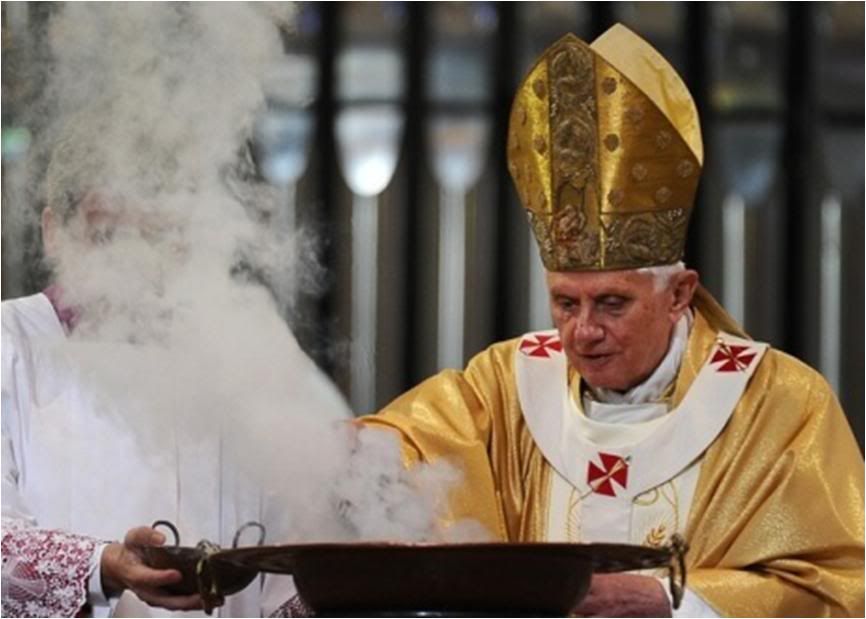 After this, the altar was wiped clean of the oil and dressed for the Mass, with linen, flowers and the ritual seven candles and crucifix. The Holy Father then lit a candle which was brought by the deacon to the altar to light the candles on it. With this, the formal dedication rite ended. The Offertory and the rest of
After this, the altar was wiped clean of the oil and dressed for the Mass, with linen, flowers and the ritual seven candles and crucifix. The Holy Father then lit a candle which was brought by the deacon to the altar to light the candles on it. With this, the formal dedication rite ended. The Offertory and the rest of
the Mass continued.
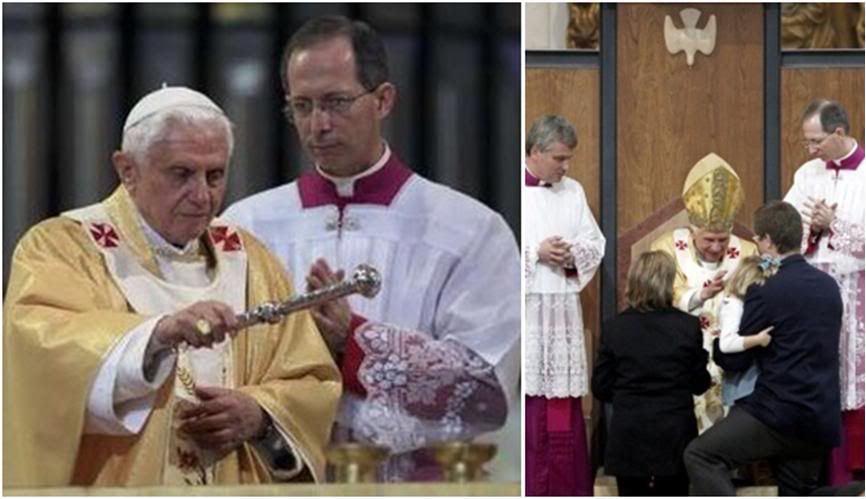
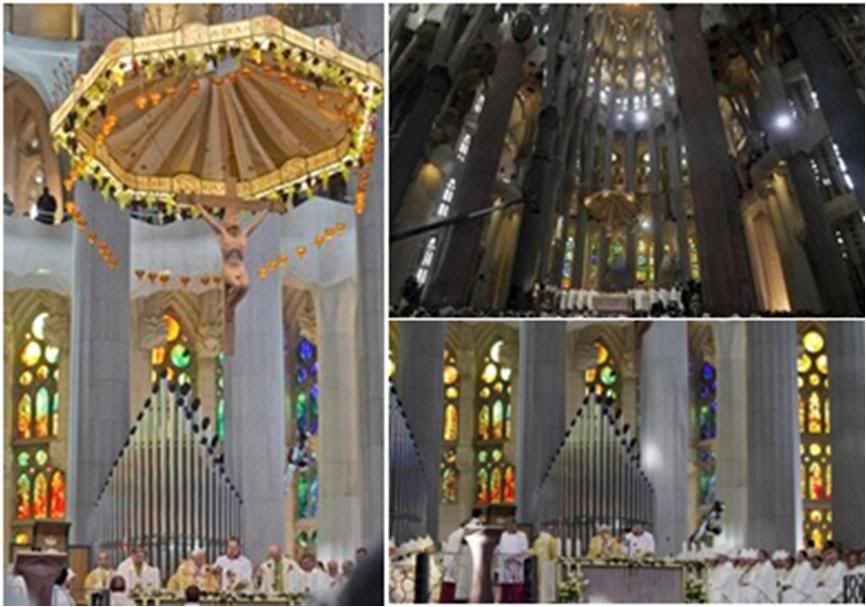
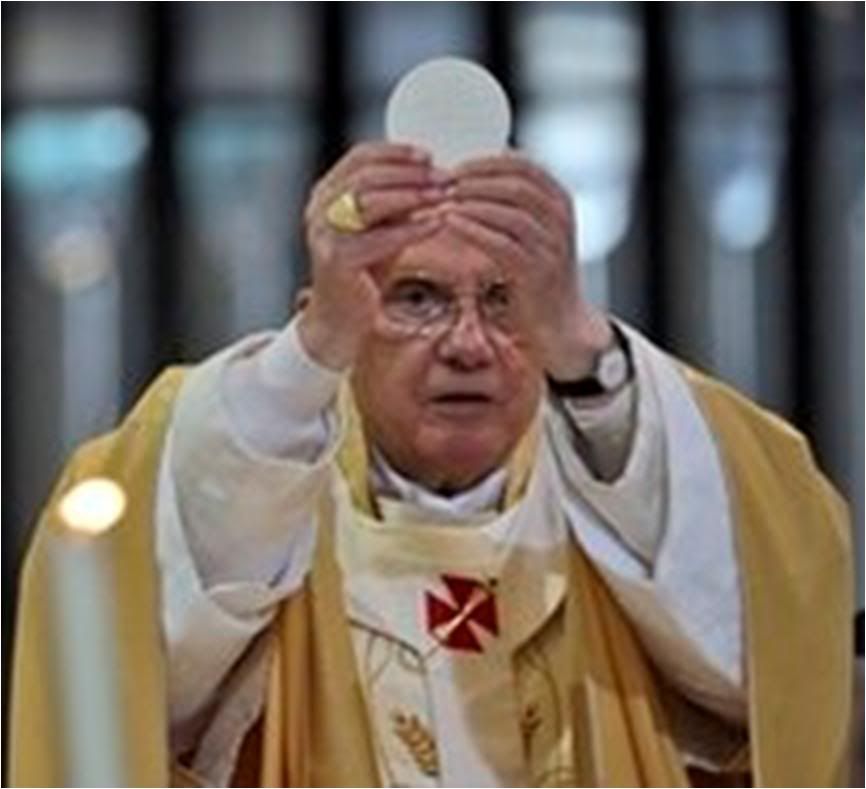

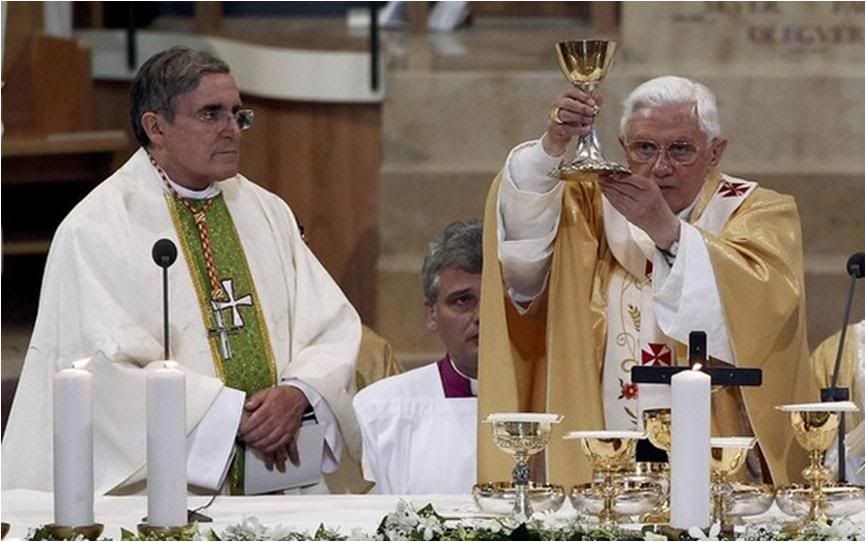 Principal concelebrants were Cardinal Sistach of Barcelona and Cardinal Bertone.
Principal concelebrants were Cardinal Sistach of Barcelona and Cardinal Bertone.
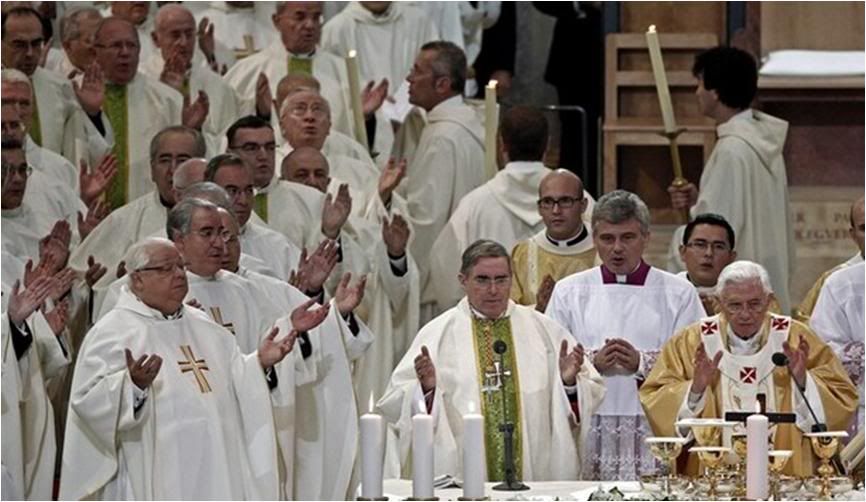
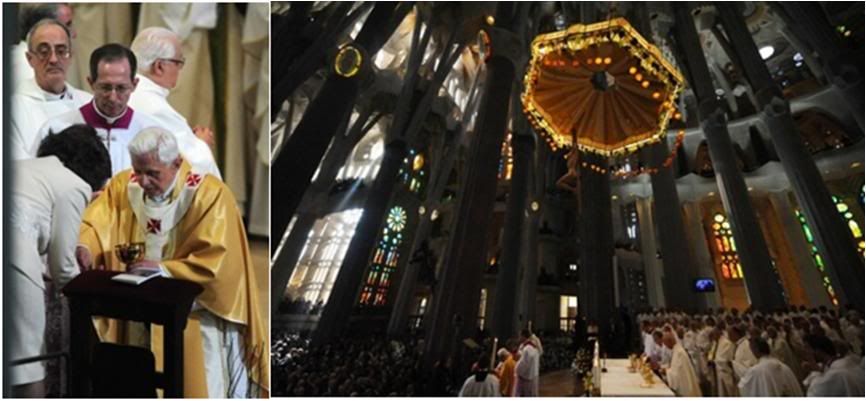 Left photo: Queen Sofia receiving Communion from the Pope. She chooses not to kneel. Before the Mass ended, Cardinal Sistach jubilantly received, then read to the applauding congregation, the papal bull formally designating the Sagrada Familia as a basilica (below).
Left photo: Queen Sofia receiving Communion from the Pope. She chooses not to kneel. Before the Mass ended, Cardinal Sistach jubilantly received, then read to the applauding congregation, the papal bull formally designating the Sagrada Familia as a basilica (below).
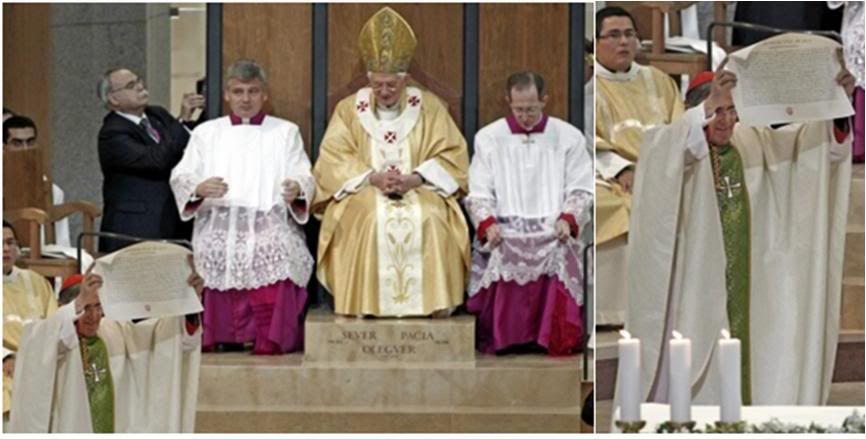
At the end of the Mass, the Holy Father left the Church through the Portal of Charity of the Nativity Facade, overlooking Plaza Antoni Gaudi to lead the Angelus prayers with the faithful waiting outside.
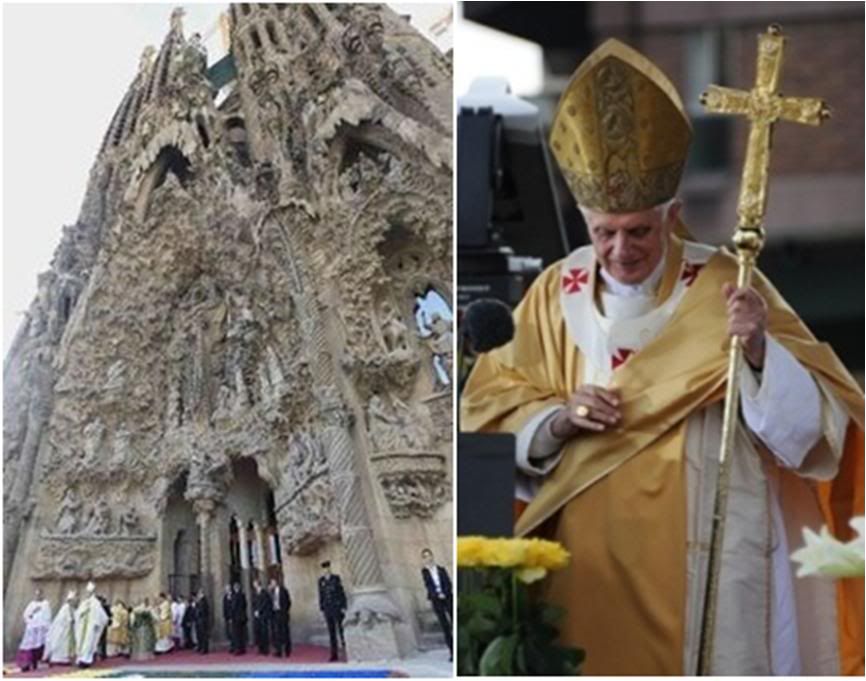
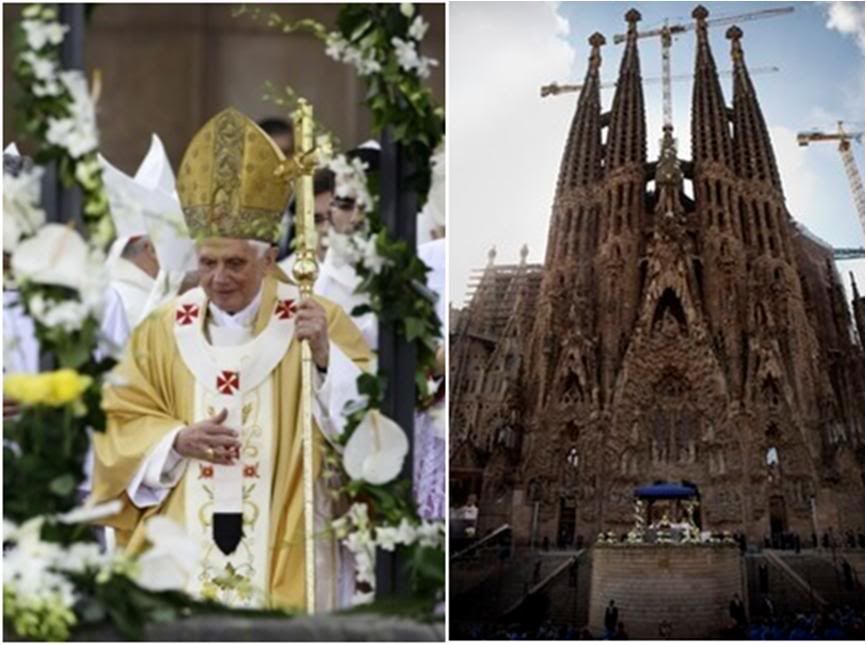
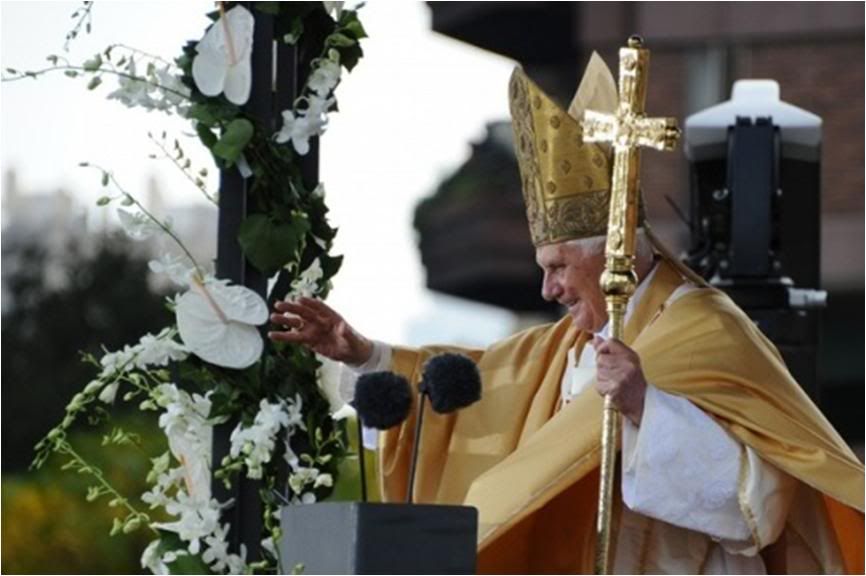
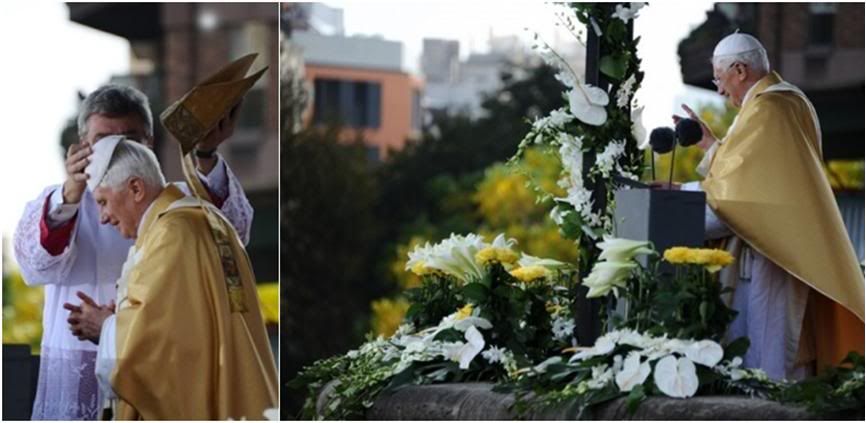 THE POPE'S WORDS
THE POPE'S WORDS
AT THE ANGELUS
My Dear Brothers and Sisters in our Lord Jesus Christ,
Yesterday, in Porto Alegre, Brazil, the celebration of the Beatification of the Servant of God, Maria Barbara of the Most Holy Trinity, foundress of the Congregation of the Sisters of the Immaculate Heart of Mary, was celebrated.
May the deep faith and fervent charity with which she followed Christ awaken in many the desire to devote their lives completely to the greater glory of God and the generous service of their brothers and sisters, especially the poorest and the most needy.
Today I had the great joy of dedicating this church to him who, being the Son of the Most High, emptied himself and became man, and who, under the watchful care of Joseph and Mary, in the silence of the home of Nazareth, taught us without words of the dignity and the primordial value of marriage and the family, the hope of humanity, in which life finds its welcome from conception to natural death.
He has taught us also that the entire Church, by hearing and putting his word into practice, becomes his family. And he has exhorted us to be a seed of fraternity which, sown in every heart, nourishes hope.
Filled with devotion to the Holy Family of Nazareth, a devotion spread among the Catalan people by Saint Joseph Manyanet, the genius of Antoni Gaudí, inspired by the ardour of his Christian faith, succeeded in raising this sanctuary as a hymn of praise to God carved in stone
A praise of God which, as with the birth of Christ, has had as its protagonists the most humble and simple of people. In effect, Gaudí, through his work, sought to bring the Gospel to everyone.
For this reason, he conceived of the three porticos of the exterior of the church as a catechesis on the life of Jesus Christ, as a great Rosary, which is the prayer of ordinary people, a prayer in which are contemplated the joyful, sorrowful and glorious mysteries of our Lord.
In collaboration with the parish priest Gil Parés, he also designed and financed from his own savings the creation of a school for the children of the workers and of the poorest families of the neighbourhood, which was at that time a outlying suburb of Barcelona.
He brought concrete reality to the conviction, saying: “The poor must always find a welcome in the Church, which is an expression of Christian charity.”
This morning I also had the satisfaction of declaring this church a minor basilica. In it, men and women of every continent can contemplate the façade of the Nativity.
In prayer, let us now consider the mystery of the Incarnation and lift up our prayer to the Mother of God with the words of the Angel, as we entrust our lives and the life of the entire Church to her, while imploring the gift of peace for each and every person of good will.
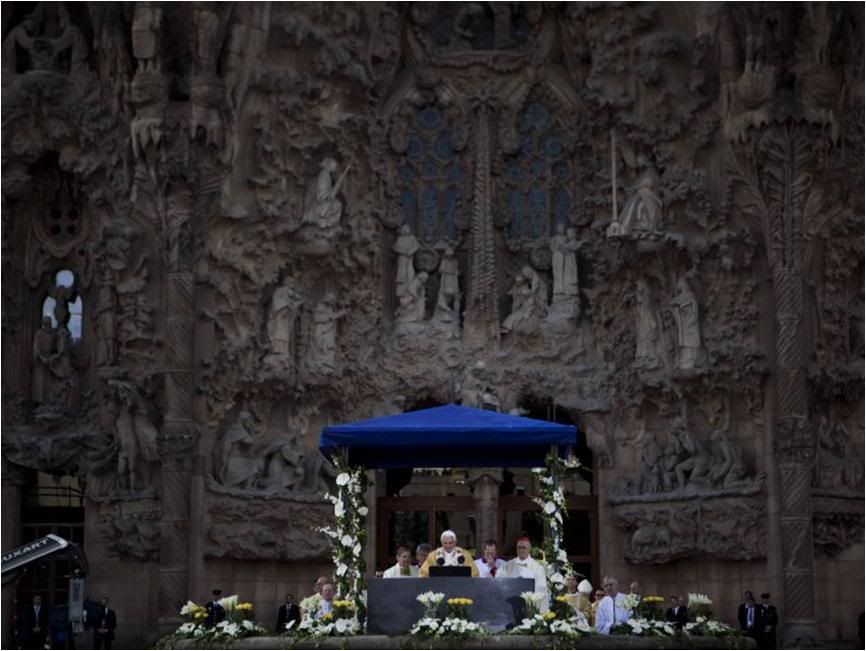
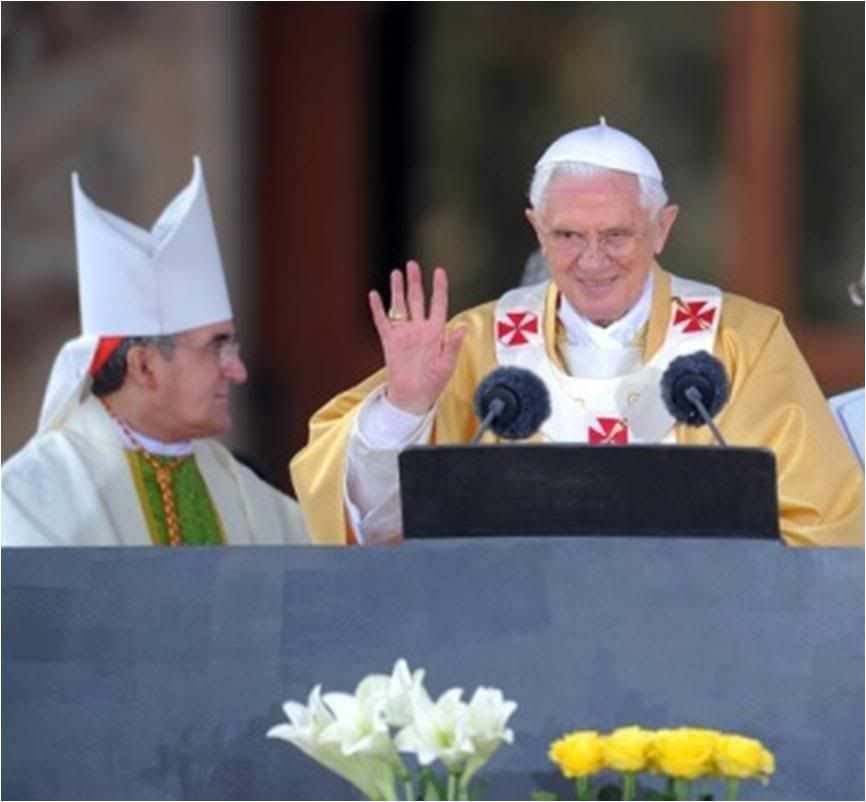
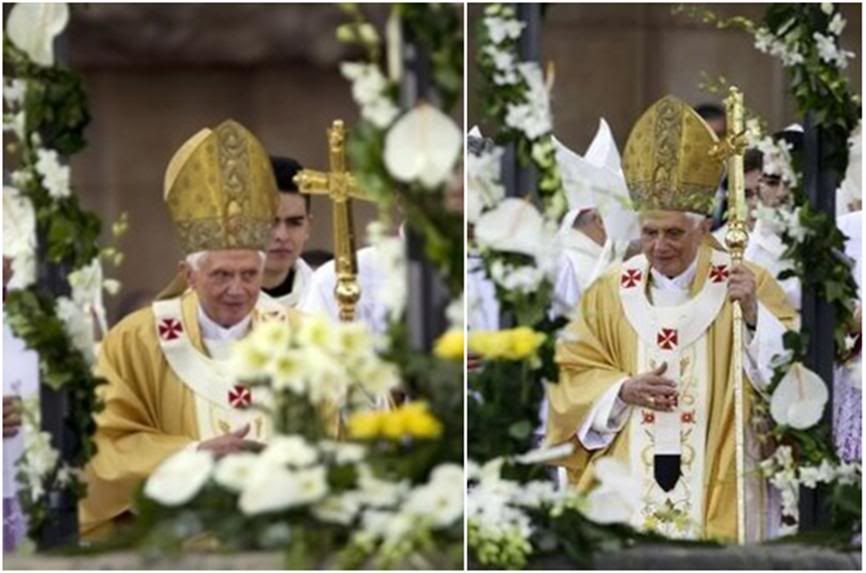
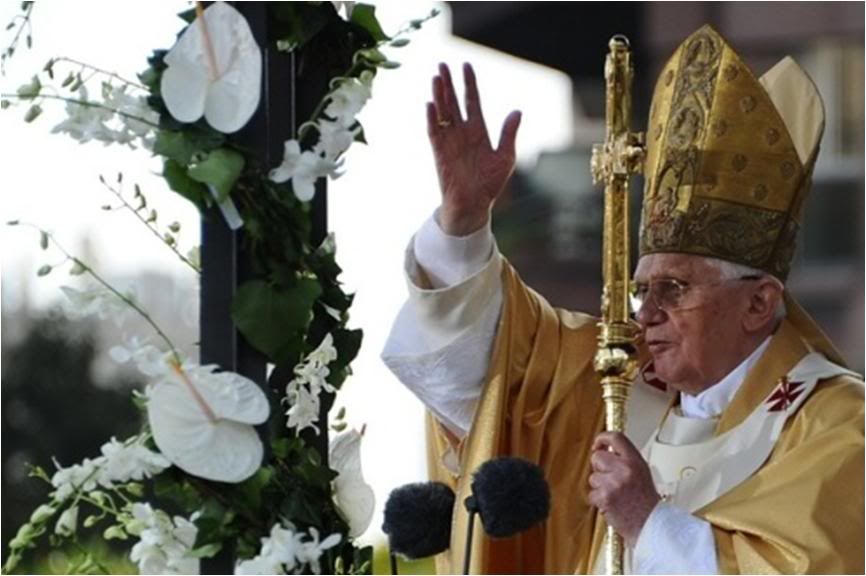 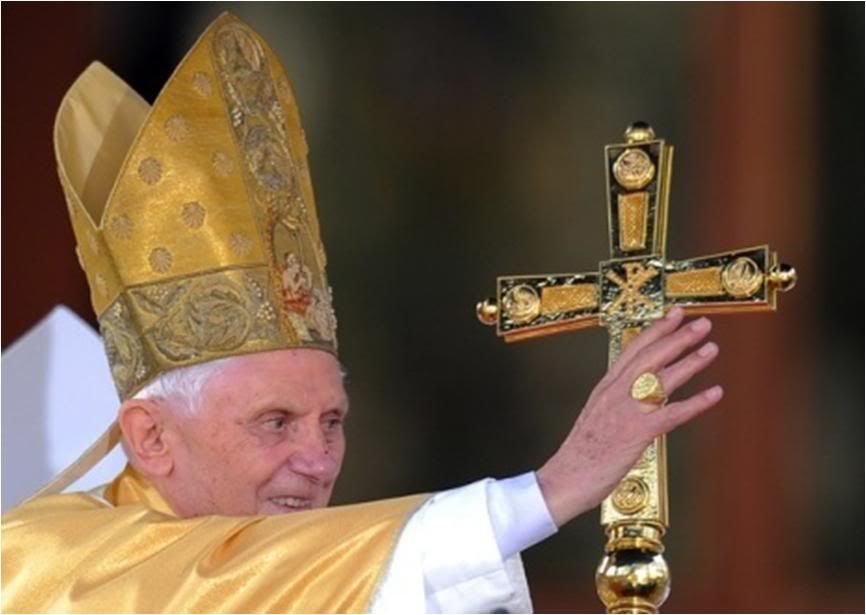
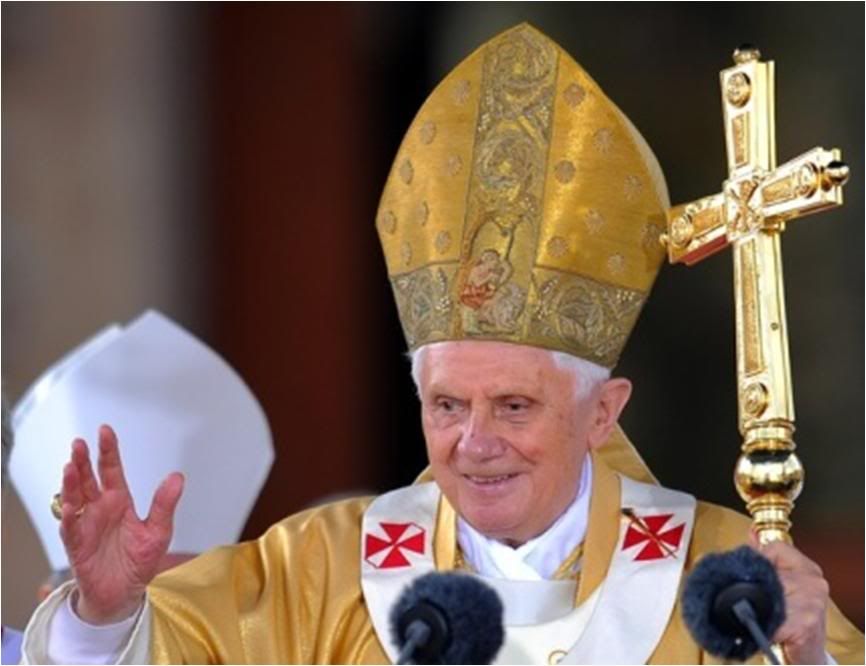
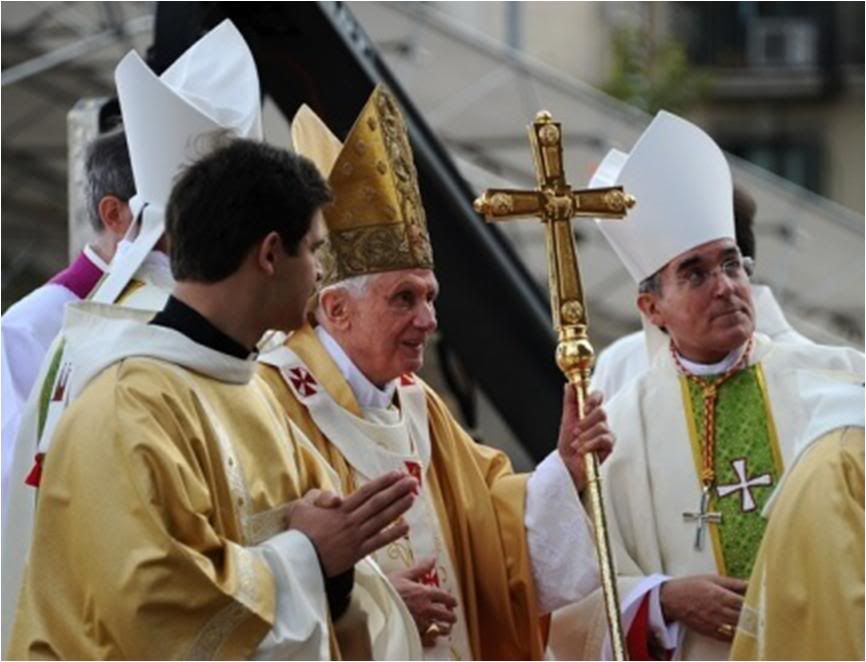 One must praise the Vatican Press office because during this papal trip, for the first time in this Pontificate, it promptly provided translations of the Pope's texts in each of the Vatican's official languages. Let us hope this initiative will come to include all the Pope's other texts.
I don't think anyone has mentioned it - and I've tried to Google the question without success - but when was the last time a Pope consecrated a major church? Back in the Middle Ages, perhaps, or earlier? Benedict XVI now has the distinction of consecrating the single most consequential and original achievement in Christian architecture (and perhaps in Christian art) in the modern era.
One must praise the Vatican Press office because during this papal trip, for the first time in this Pontificate, it promptly provided translations of the Pope's texts in each of the Vatican's official languages. Let us hope this initiative will come to include all the Pope's other texts.
I don't think anyone has mentioned it - and I've tried to Google the question without success - but when was the last time a Pope consecrated a major church? Back in the Middle Ages, perhaps, or earlier? Benedict XVI now has the distinction of consecrating the single most consequential and original achievement in Christian architecture (and perhaps in Christian art) in the modern era.
How fitting that it comes almost on the first anniversary of his meeting with contemporary artists last year at the Sistine Chapel! Too bad he had no opportunity to look at the details of the church as any ordinary tourist can. Cardinal Sistach should send him a video of a virtual tour of the church!
[Modificato da TERESA BENEDETTA 08/11/2010 20:07] |
| |
 07/11/2010 21:48 07/11/2010 21:48 |
|
| | | OFFLINE | | Post: 21.400
Post: 4.036 | Registrato il: 28/08/2005
Registrato il: 20/01/2009 | Administratore | Utente Master | |
|
 VISIT TO THE OBRA BENÉFICO-SOCIAL NEN DÉU
VISIT TO THE OBRA BENÉFICO-SOCIAL NEN DÉU
At 4:30 p.m., the Holy Father bade farewell to the staff of the Arcbishop's Palace in Barcelona and proceeded to the archidocesan institute, Obra Benéfico-Social del Nen Déu (Baby Jesus), founded in 1892 for sick and handicapped children by Mother Carmen del Niño Jesús (family name González Ramos García Prieto) who was beatified in May 2007, and founder of the order Franciscan Sisters of teh Sacred Hearts of Jesus and Mary.
The Pope was welcomed by the Mother Superior Maria Rosario of the Institute who accompanied him to the chapel where the nuns commmnity, the institute staff, and some 200 wards and ther families were assembled.
Welcome remarks were given by Cardinal Sistach, the Mother Superior and a boy and a girl representing their fellow wards at the Institute.
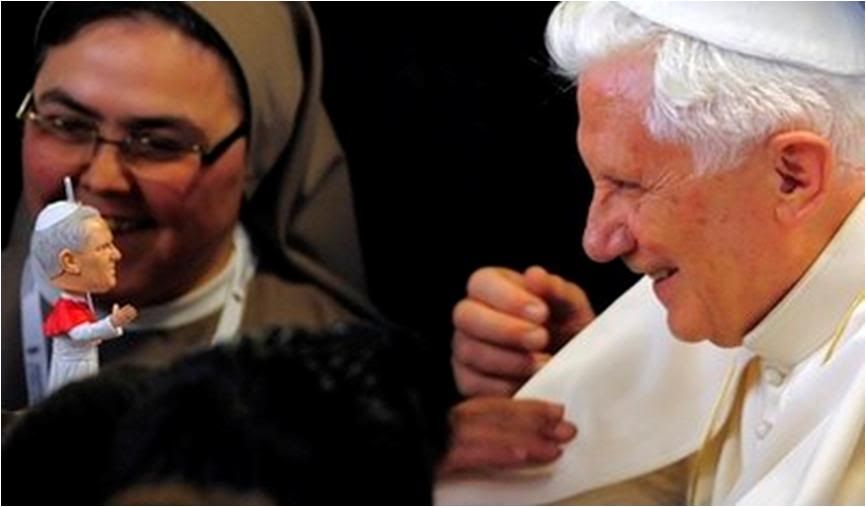
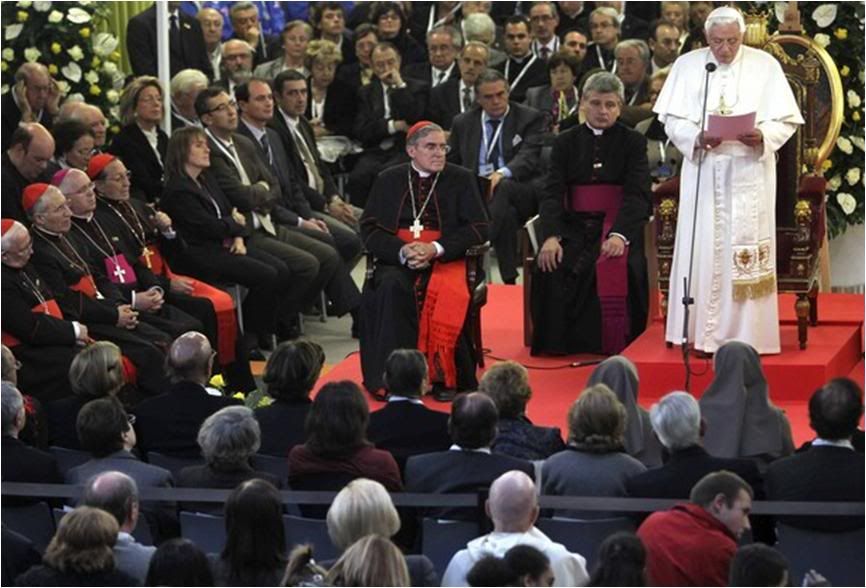
Your Eminence,
Dear Brother Bishops,
Dear Priests, Deacons, Religious Men and Women,
Distinguished Authorities,
Dear Friends,
I am pleased to have this opportunity to meet all those who represent what has been for more than a century the Obra Benéfico-Social del Nen Déu. I thank the Archbishop of Barcelona, Cardinal Lluís Martínez Sistach, Sister Rosario, Superior of this community, young Antonio and María del Mar who spoke, as well as the children who have sung so marvellously. All of you have given me a beautiful welcome.
I also thank those present, in particular the Patrons of the Obra, the Mother General and the Franciscan Religious of the Sacred Heart, the children, the youth and adults of this institution, their parents and relatives, as well as the professionals and volunteers who carry out praiseworthy work in this place.
I would also like to express my appreciation to the authorities, and I invite them to increase their efforts to provide adequate social services and assistance to the most needy.
I also thank those who, with their generous support, build up and sustain private welfare institutions, such as this Special Education School of Nen Déu.
At a time when many households are faced with serious economic difficulties, the followers of Christ must multiply concrete gestures of effective and constant solidarity, showing in this way that charity is the hallmark of our Christian life.
The dedication of the Basilica of the Sagrada Familia this morning has highlighted that churches are the sign of the true sanctuary of God among men.
Here, I would like to emphasize how, through the efforts of this and similar church institutions, including the new Residence which you have wished to name after the Pope, it is clear that, for the Christian, every man and woman is a true sanctuary of God, and should be treated with the highest respect and affection, above all when they are in need.
In this way, the Church desires to put into practice the words of the Lord in the Gospel, “I say to you, as you did it to one of the least of these my brethren, you did it to me” (Mt 25:40).
In this land, these words of Christ have motivated many sons and daughters of the Church to dedicate their lives to teaching, to works of assistance and the care of the sick and the disabled. Inspired by their example, I ask you to continue to provide loving care to the smallest and the most needy, giving them the very best of yourselves.
In recent decades, remarkable advances in medicine have greatly contributed to the care of those in greatest need, advances which have been accompanied by a growing conviction of the importance of dedicated and humane treatment for the positive outcome of the healing process.
Therefore, it is indispensable that new technological developments in the field of medicine never be to the detriment of respect for human life and dignity, so that those who suffer physical illnesses or handicaps can always receive that love and attention required to make them feel valued as persons in their concrete needs.
I now turn to you, dear children and young people, giving thanks to God for your lives, so precious in his eyes, and I assure you that you have a special place in the Pope’s heart. I pray for you every day and I ask you to help me by means of your prayers so that I may faithfully fulfil the mission entrusted to me by Christ.
I always remember in my prayers those who are dedicated to helping the suffering, and those who work tirelessly so that the handicapped can take their rightful place in society and not be marginalized because of their limitations.
In this respect, I wish to recognize, in a special way, the faithful witness of priests and those who visit the sick at home, in hospitals or in other specialized institutions. They incarnate that important ministry of consolation in the face of human frailty, which the Church seeks to carry out in imitation of the Good Samaritan (cf. Lk 10:29-37).
Through the intercession of Our Lady of Mercy and of Blessed Mother Carmen of the Child Jesus, may God bless all those who make up the great family of this splendid Obra, as well as your loved ones and those who collaborate in the work of this institution and those similar to it. As a pledge of this, I cordially impart to all my Apostolic Blessing.
[Modificato da TERESA BENEDETTA 08/11/2010 14:43] |
| |
 07/11/2010 21:48 07/11/2010 21:48 |
|
| | | OFFLINE | | Post: 21.401
Post: 4.037 | Registrato il: 28/08/2005
Registrato il: 20/01/2009 | Administratore | Utente Master | |
|
 Sorry I havent' been able to keep up with the photo overload of the past two days, and I am very much behind on the stories today... Now, the Holy Father has left Barcelona and is probably back in Rome by now, while I have yet to post a story on his second public event... But a quick look at what happened at Barcelona's airport tonight:
THE POPE TO THE PEOPLE OF SPAIN:
Sorry I havent' been able to keep up with the photo overload of the past two days, and I am very much behind on the stories today... Now, the Holy Father has left Barcelona and is probably back in Rome by now, while I have yet to post a story on his second public event... But a quick look at what happened at Barcelona's airport tonight:
THE POPE TO THE PEOPLE OF SPAIN:
'Arrivederci till 2011'
Benedict XVI met with Prime Minister Zapatero briefly at the airport tonight before leaving for Rome. King Juan Carlos and Queen Sofia were also there to bid farewell to the Pope, until he comes back in August next year for World Youth Day.

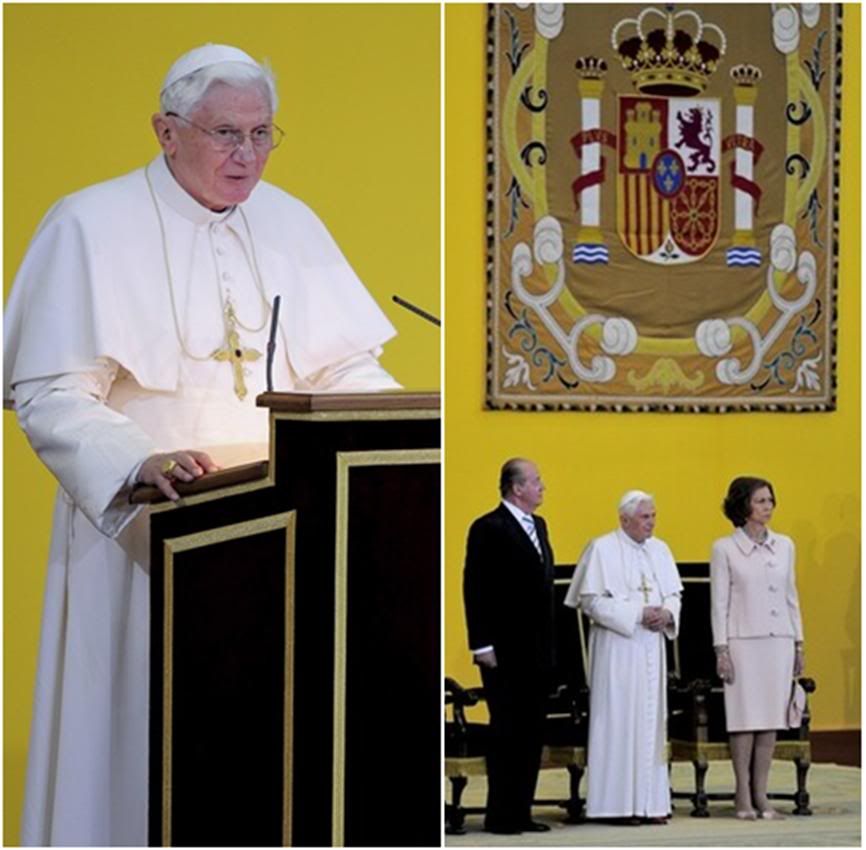
Your Majesties,
Your Eminences the Archbishop of Barcelona and the Cardinal President of the Spanish Bishops’ Conference,
Your Eminences and Your Excellencies,
Dear Prime Minister,
Distinguished National Regional and Local authorities,
Dear Brother and Sisters,
Dear Friends,
Thank you very much. I wish to convey in these brief words my deep sentiments of gratitude at the conclusion of my visit to Santiago de Compostela and Barcelona.
I thank Your Majesties for coming here today. I am grateful to Your Majesty for your gracious words in which you expressed the affection of this noble people to the Successor of Peter.
I also wish to express my heartfelt gratitude to the authorities present, to the Archbishops of Santiago de Compostela and Barcelona, to the Spanish Bishops and to all those who, without counting the cost, have helped to bring this journey to a happy conclusion.
I am grateful for the many constant and touching gestures of attention offered in these days to the Pope, clear signs of the openness and hospitality characteristic of the people of these lands so dear to my heart.
At Compostela, as a pilgrim, I joined the many people from Spain and Europe and elsewhere who come to the tomb of the apostle to fortify their faith and to receive forgiveness and peace.
As Peter’s Successor I also came to strengthen my brothers and sisters in the faith that at the very dawn of Christianity came to these lands and took such deep root that it has constantly shaped the spirit, customs, art and character of its peoples.
The preservation of this rich spiritual patrimony demonstrates the love of your country for its history and culture, yet it is also a privileged way of transmitting to younger generations those fundamental values so necessary for building up a common future of harmony and solidarity.
The paths that cross Europe on the way to Santiago differed greatly, each marked by its own language and its particular characteristics, but the faith was the same. There was a common language, the Gospel of Christ.
In any place pilgrims could feel at home. Beyond national differences, they knew that they were members of one great family to which the other pilgrims and people along the way also belonged.
May this faith find new vigour on this continent and become a source of inspiration. May it give rise to an attitude of solidarity towards all, especially towards those communities and nations in greater need.
[in Catalan:] Here in Barcelona, I have had the immense joy of consecrating the Basilica of the Sagrada Familia, which Gaudí conceived as a monument of praise in stone to God. I also visited an important charitable institution of the Church.
They stand in today’s Barcelona as two symbols of the fruitfulness of that faith which has marked this people deeply and which, through charity and the mystery of God’s beauty, contributes to the creation of a society more worthy of man. Truly, beauty, holiness and the love of God enable people to live with hope in this world.
I return to Rome after visiting only two places in this beautiful country. Nevertheless, in my thoughts and prayers, I have wished to embrace all Spaniards without exception and all those born elsewhere but now living here.
I hold all of you in my heart and I pray for you, especially for those who suffer. I place you under the maternal protection of Mary Most Holy, so greatly venerated and invoked in Galicia, Catalonia and throughout Spain.
I ask her to obtain for you from Almighty God abundant heavenly gifts, that you may live as one family, guided by the light of faith. I bless you in the name of the Lord.
With his help, we will meet again next year in Madrid, to celebrate World Youth Day. Adios!
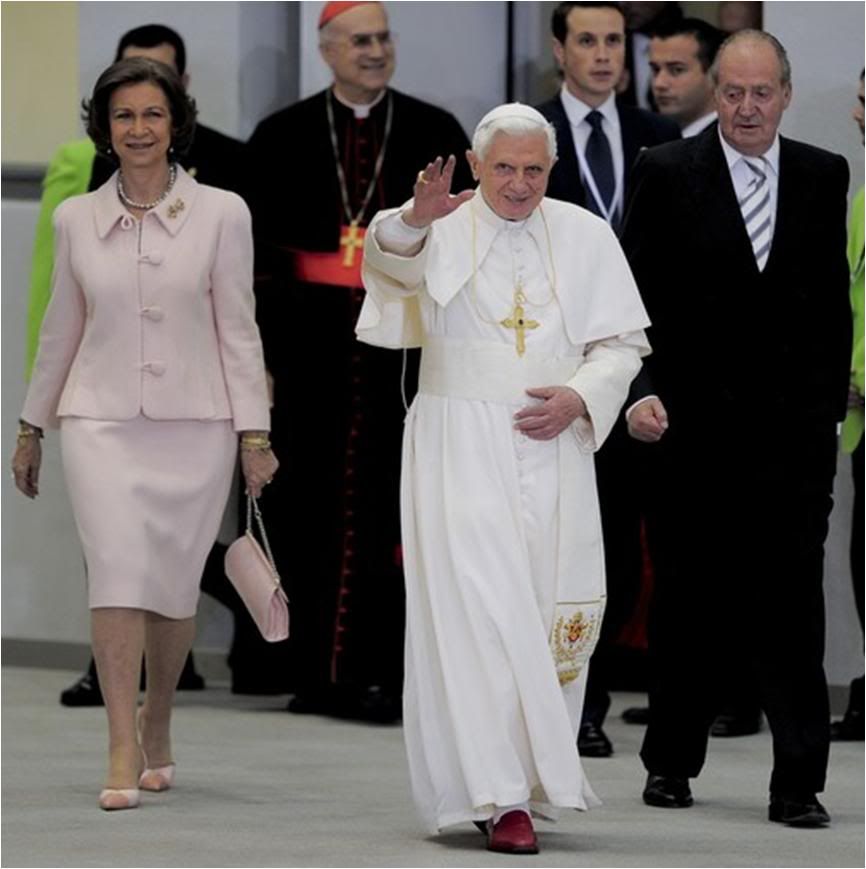
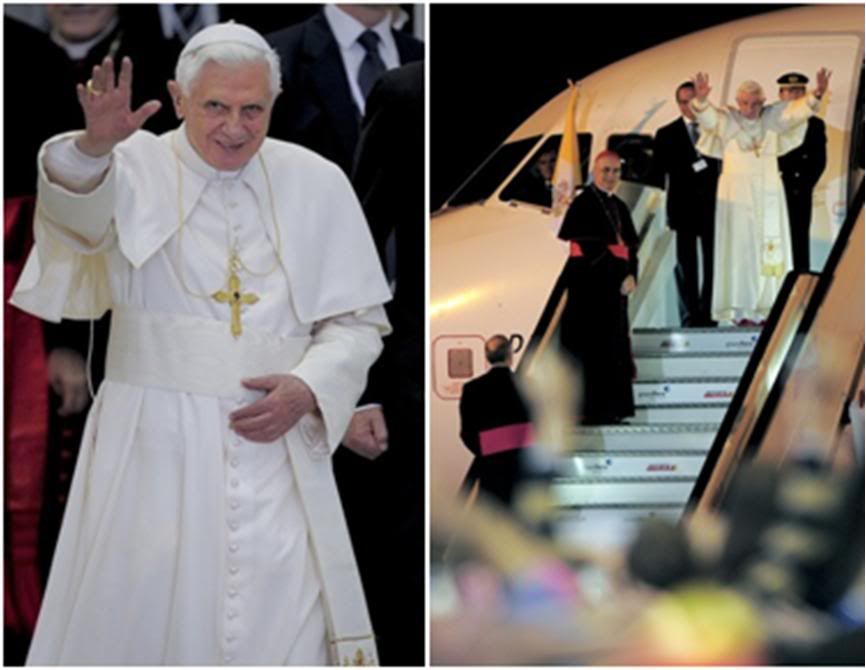 IN ROME....
IN ROME....
Out of the plane from Barcelona.. and into a chopper for the ride back to the Vatican:

[Modificato da TERESA BENEDETTA 12/11/2010 12:13] |
| |
 08/11/2010 16:05 08/11/2010 16:05 |
|
| | | OFFLINE | | Post: 21.402
Post: 4.038 | Registrato il: 28/08/2005
Registrato il: 20/01/2009 | Administratore | Utente Master | |
|
 Monday, November 8
Monday, November 8
 BLESSED JOHN DUNS SCOTUS (b Scotland 1266, d Cologne 1308) BLESSED JOHN DUNS SCOTUS (b Scotland 1266, d Cologne 1308)
Franciscan, Scholastic Theologian
Benedict XVI has two major texts on today's saint - first his letter to commemorate the 7th centenary of his death in 2008
www.vatican.va/holy_father/benedict_xvi/apost_letters/documents/hf_ben-xvi_apl_20081028_duns-scoto...
and his catechesis on July 7, 2010, in the cycle on the great medieval thinkers of the Catholic faith
www.vatican.va/holy_father/benedict_xvi/audiences/2010/documents/hf_ben-xvi_aud_20100707...
One of the most influential thinkers of the Middle Ages, Duns Scotus taught in Oxford, Paris, and Cologne, where he died.
His ideas on the Immaculate Conception were adopted by Pius IX when he proclaimed the dogma more than five centuries later,
in 1854. The 'Doctor Subtilis'. was beatified in 1993 by John Paul II.
No OR today.
No events for the Holy Father today, but the Press Office has issued an announcement that he will be meeting with the College of Cardinals on Friday, November 19, for 'a day of reflection and prayer' the day before his third consistory to create new cardinals.
A DAY OF REFLECTION AND PRAYER
WITH THE COLLEGE OF CARDINALS
Translated from

In a letter dated Oct. 30, the Dean of the College of Cardinals, Cardinal Angelo Sodano, informed all members of the college and thew new cardinals-designate that before the Ordinary Public Consistory on November 20, the Holy Father asks them to participate the day before, Friday, Nov. 19, in 'a day of reflection and prayer', which will be held at the new Hall of Synods at the Vatican.
The program is as follows:
09.30 Celebration of Tierce [third prayer in the Daily Liturgy of the Hours]
The morning discussions will be on two subjects:
- The situation of religious freedom in the world and new challenges, with an introduction by Cardinal Tarcisio Bertone; and
- Liturgy in the life of the Church today, with an introduction by Cardinal Antonio Canizares Llovera, Prefect of the Congregation for Divine Worship.
17:00 Vespers, followed by three reports:
- "Ten years since Dominus Iesus', by Mons. and Cardinal-designate Angelo Amato, Prefect of the Congregation for Saints;
- "The Church response to sexual abuses" and
- "On Anglicanorum coetibus" - both by Cardinal William Levada, Prefect of the Congregation for the Doctrine of the Faith.
The Vatican also announced that the VII Colloquium between the Pontifical Council for Inter-Religious Dialog (CIRD) and the Center for Inter-Religious Dialogue of Iran's Islamic Culture and Relations Organization will take place in Teheran on Nov. 9-11. The Vatican delegation will be led by Cardinal Jean Louis Tauran, CIRD Prefect.
P.S. Despite everything that the past five years should have taught me about the MSM mindset, I am still surprised that all the MSM reporting about the cardinals' pre-consistory meeting with the Pope has been on the lines of 'Vatican calls summit on sex abuse', typical of the headlines that immediately proliferated - a ridiculous claim since it is onlt one of five topics to be reported on during a morning and an afternoon session that can hardly add up to more than 6 hours! I thought of it more like a 'state of the Church' event, to be reflected and prayed upon - not as a discussion, which sould come later in all the possible venues and ways!
[Modificato da TERESA BENEDETTA 12/11/2010 12:10] |
| |
 08/11/2010 16:37 08/11/2010 16:37 |
|
| | | OFFLINE | | Post: 21.403
Post: 4.039 | Registrato il: 28/08/2005
Registrato il: 20/01/2009 | Administratore | Utente Master | |
|

 Isn't it 'amazing grace' from God that even as the MSM persist in sounding the death knell for a 'crisis-rocked' Catholic Church, she continues, under Benedict XVI, to register some historic gains? The defection of major Anglican bishops and entire parishes to the Catholic Church is simply unprecedented... DEO GRATIAS, and God bless!
One year since 'Anglicanorum coetibus':
Isn't it 'amazing grace' from God that even as the MSM persist in sounding the death knell for a 'crisis-rocked' Catholic Church, she continues, under Benedict XVI, to register some historic gains? The defection of major Anglican bishops and entire parishes to the Catholic Church is simply unprecedented... DEO GRATIAS, and God bless!
One year since 'Anglicanorum coetibus':
Five Anglican bishops quit to join Rome
By Tim Ross, Religious Affairs Editor

08 Nov 2010
Five bishops have resigned to join the Roman Catholic Church as an exodus of Anglicans begins.
The five will convert to Roman Catholicism in the first wave of protests over plans to ordain women bishops in the Church of England for the first time.
The Roman Catholic Church backed their move, which was first reported in The Daily Telegraph, and promised a "warm welcome" to all Anglicans who decide to switch allegiance to Rome.
Senior Catholics are finalising plans for the English Ordinariate, a new body created by the Pope to accommodate Anglican converts who cannot accept women bishops.
The Auxiliary Bishop of Westminster, Alan Hopes, the Roman Catholic representative leading the development of the Ordinariate, confirmed the identities of the five converts today.
Bishop Hopes said: “We welcome the decision of Bishops Andrew Burnham, Keith Newton, John Broadhurst, Edwin Barnes and David Silk to enter into full communion with the Catholic Church through the Ordinariate for England and Wales.”
He said Catholic bishops would be finalising plans for the establishment of the Ordinarate next week, and promised a “warm welcome” to “those who seek to be part of it”.
The defections have been triggered by a vote at the General Synod of the Church of England in July to support divisive plans for women to be ordained as bishops in England for the first time.
A compromise plan, backed by the Archbishop of Canterbury, Dr Rowan Williams, was rejected, leaving many opponents of women’s ordination with no option but to consider leaving the Church.
Pope Benedict XVI announced last year that he would create the English Ordinariate for Church of England traditionalists who wish to switch allegiance to Rome while retaining some of their Anglican traditions.
The five bishops are said to be “dismayed” at the liberal reforms to the Church in recent decades and will join the Ordinariate in pursuit of “unity” with Rome when the new body is established next year.
They will cease pastoral work, which includes the oversight of Anglican parishes that are opposed to women priests, immediately, although they will remain officially in post until the end of December.
Sources on both sides expect about 25 groups, each typically containing approximately 20 converts, to follow the path to Rome.
The estimates suggest up to 500 individuals will join the Ordinariate in the first wave, with more expected to follow once it has become established.
Church wardens are arranging meetings to discuss the move in parishes across England. St Peter’s in Folkestone, in the Archbishop of Canterbury’s own diocese, became the first parish to declare publicly that it intended to join the Ordinariate last month.
Holy Trinity church in Reading is expected to make a decision on whether to follow in the next few weeks. Meetings are also planned at St John the Baptist church in Sevenoaks, Kent, and Holy Trinity, Winchmore Hill, in north London.
Fr David Elliott, parish priest at Holy Trinity in Reading, said many traditional Anglo-Catholics felt “squeezed” by reforms which would pave the way for the ordination of women as bishops in the Church of England for the first time.
“For congregations like this it is a big moment in their history,” he said. “These decisions aren’t made lightly. I haven’t resigned but I don’t see that there can be a future for Catholics within the Church of England.
“My own future I think does lie in the Roman Catholic Church but I can’t say when that will be. Obviously I have got to weigh up my responsibilities to the congregation.”
Ross filed the following separate story today...
Church of England is like
'a coffee chain going out of business',
defecting bishop says
By Tim Ross, Religious Affairs Editor

08 Nov 2010
Five bishops have announced that they are converting to Roman Catholicism in protest at liberal Anglican reforms and urged others to follow their path.
One likened the Church to a chain of coffee shops that is losing customers while a second accused it of adopting an increasingly “lax” attitude towards issues of morality, such as homosexuality and abortion.
As first reported in The Daily Telegraph, three serving and two retired traditionalist bishops announced that they are resigning in order to convert to Roman Catholicism.
The defections come as hundreds of worshippers prepare to take up the Pope’s offer to join a new section of the Roman Catholic Church which is being established for Anglicans who cannot accept liberal reforms such as the ordination of women bishops.
The new body, known as the English Ordinariate, is expected to be finalised next week and to begin operation as a full part of the Roman Catholic Church next year.
The Catholic Church in England and Wales welcomed the decision made by the Bishops of Ebbsfleet, the Rt Rev Andrew Burnham; Fulham, the Rt Rev John Broadhurst; Richborough, the Rt Rev Keith Newton; and two retired bishops, the Rt Rev Edwin Barnes, honorary assistant bishop of Winchester, and the Rt Rev David Silk, honorary assistant bishop of Exeter.
In a joint statement the bishops expressed their “dismay” and “distress” at recent liberal reforms to the Church, in particular the ordination of women priests and plans for the consecration of women as bishops.
Speaking to The Telegraph, Bishop Burnham likened the Church of England to a failing chain of coffee shops that loses customers because it does not offer the same menu in every branch.
Worshippers no longer know what they will find when they walk into an Anglican church, with some offering highly traditional services and others employing women as priests, he said.
“The Church of England has decided that it can make its own mind up about what it can do. There are signs it is forgetting and losing a sense of where it came from,” he said.
“If Costa Coffee, every time you went to a branch, did something different and you didn’t know what the product was, they would go out of business.
“We have got to the stage now in the Church of England where there are so many different products that you don’t know what you’re going to get.”
Bishop Newton said his difficulties with the Church of England went further than the issue of the ordination of women.
He said: “There has been a more lax attitude towards moral issues: the whole question of blessing gay marriage - there is a lot of pressure for that to happen in the Church of England – abortion, and life and death issues.”
The Church had given Anglicans the impression that they could decide individually what was right or wrong to believe. “You are never sure what the Church stands for any more.”
The Archbishop of Canterbury, Dr Rowan Williams, expressed his “regret” at their resignations. The Catholic Church in England and Wales promised all Anglicans who chose to join the new Ordinariate a “warm welcome”.
Damian Thompson writes an enlightening blog on this:
A one-way pilgrimage to Rome

08 Nov 2010
The Archbishop of Canterbury is expected to announce this week that two Church of England bishops are becoming Roman Catholics. It will be a historic moment – but it’s fair to say that, given the choice, Dr Rowan Williams would prefer not to be involved in making this piece of history.
In the past, a few bishops have converted to Rome as private individuals and everyone has politely looked the other way. They have swum the Tiber solo, as it were.
This time the Anglican prelates are stepping on to a ferry sent for them by the Pope himself. The Rt Rev Keith Newton, Bishop of Richborough, and the Rt Rev Andrew Burnham, Bishop of Ebbsfleet, will be the first passengers. Two other bishops, the Rt Rev John Broadhurst, Bishop of Fulham, and the Rt Rev Edwin Barnes, retired Bishop of Richborough, are expected to follow shortly.
Moreover, Benedict XVI has made it clear that there will be space on the new vessel for any number of Anglicans who want to convert together – and, crucially, stay together once they have arrived.
Bishops Newton and Burnham are leaving to join the English Ordinariate, a new structure, similar to a diocese, created for former Anglo-Catholics. Separate Ordinariates are being formed by the Vatican for traditionalists in Scotland, America, Australia and other English-speaking countries.
Until recently, the departing Anglo-Catholics believed that the Church of England, despite its Protestant roots, was part of the Catholic Church. Now, as it prepares to ordain women bishops, they have given up on it. (In other countries, especially America, Anglican tolerance of homosexual bishops and gay blessings has been the deciding factor.)
A key detail often overlooked in reports of the defections is that it was disaffected Anglicans who asked the Pope to invent a structure that would allow them to worship together as Catholics, retaining a sense of community while holding on to some of their old prayers and ceremonial. He happily obliged.
As Cardinal Ratzinger, he was on friendly terms with conservative Anglicans and probably wished that his predecessor, John Paul II, had made a similarly bold offer when the General Synod voted to ordain women priests in 1992.
Many Anglo-Catholics, however, are determined to stay in the Church of England – and Dr Williams is encouraging them in their resolve. As a result, the High Church wing of the Church has become hopelessly split.
A new organisation has been set up called The Society of St Wilfrid and St Hilda, designed for Anglo-Catholics who want to fight women bishops from within. Critics have dubbed it “The Society of St Hinge and St Bracket”, after the music hall drag act – a typical example of High Church humour.
In its heyday, Anglo-Catholics were accused by their enemies of a fondness for “gin, lace and backbiting”. That was unkind – but, as Bishops Newton and Burnham prepare to make their highly controversial announcement, there will be no shortage of recriminations.
Catholic and Anglican blogs have already become battlegrounds between pro- and anti-Ordinariate forces in both Churches. “Thank you, Holy Father!” gush supporters. “A stupid scheme that insults Anglicans and is doomed to failure,” snarl opponents.
No one disputes that it is all frightfully complicated. For a start, Ebbsfleet and Richborough are not dioceses. They are suffragan sees created by the General Synod in the 1990s for “flying bishops” who minister exclusively to traditionalists who reject women priests. Now two of the three flying bishops are resigning to take part in another radical experiment, this time under the aegis of the Vatican.
There was no such thing as a “Personal Ordinariate” until this Pope invented it by decree last year. An “ordinary” in the Catholic Church is someone, usually a bishop, exercising authority by virtue of his office.
Although the head of each Ordinariate will have some episcopal powers, he need not actually be a bishop. The Catholic Church does not allow married men to become bishops – but it does, in some circumstances, allow them to become priests. So, if a married Anglican prelate were to convert and be ordained a Catholic priest, he could exercise bishop-like authority over the Ordinariate.
And that is exactly what is about to happen, according to credible reports over the weekend.
When Bishop Keith Newton resigns his Anglican orders, he is expected to become a Catholic priest. He will have to convert first, but it is thought that the “study leave” that he and Bishop Burnham have been taking is a euphemism for receiving instruction in the Roman Catholic faith.
Bishop Newton – a chatty Liverpudlian with a deft pastoral touch – may then be asked to become the Ordinary, with the title of Father, not Bishop, responsible for the care of an estimated 20 local groups (not parishes) who are willing to taking the plunge.
The Ordinariate could be set up as early as Pentecost next year, on the feast day after Easter marking the descent of the Holy Spirit onto the Apostles – a detail that will delight some Catholics and offend some Anglicans.
Will the ex-Anglicans be allowed to bring their buildings with them? It is too early to say. The Church of England can reasonably point out that even pro-Ordinariate parishes contain worshippers who would feel betrayed by such a move. Also, for historical reasons, the question of church ownership is more hideously tangled in England than anywhere else in the world.
One Anglican vicar who plans to join the Ordinariate told me: “The important thing is that the first wave of groups have their own churches – not necessarily their old parish buildings, but somewhere separate from the existing Catholic parish. We need to preserve our own ethos.”
And what is that ethos? This is the most sensitive question of all. The vicar I spoke to celebrates Mass in the traditional manner favoured by the Pope but not by most English bishops.
Liberal Roman Catholics are dismayed by the prospect of an influx of “reactionaries”. It is no secret that some Catholic liberals have been talking quietly to leading Anglicans in the hope of making sure that the Ordinariate experiment lasts no longer than the reign of this Pope.
Likewise, Roman Catholic conservatives cannot wait for the advance party of the Ordinariate to arrive. As one blogger put it: “We could arrange a Cold War-style prisoner exchange. We’ll take Burnham and Newton and you can have Cormac and Kieran.”
Cardinal Cormac Murphy-O’Connor, former Archbishop of Westminster, and Bishop Kieran Conry, Bishop of Arundel and Brighton, are both old-style ecumenists who have been less than enthusiastic in their support of the Ordinariate.
But, to the irritation of the English Bishops’ Conference, the Pope has bypassed the ecumenists, giving responsibility for the scheme to his old colleagues at the Congregation for the Doctrine of the Faith.
In other words, he has granted one of the main requests of the Anglo-Catholics seeking refuge: protection from liberal Catholic bishops who don’t like traditionalism in any form, Catholic or Anglican.
Why has the Pope invested so much of his personal authority in a project that, inevitably, has irritated and embarrassed the Archbishop of Canterbury, a man he respects? The answer is that Benedict XVI believes that the Ordinariate forms part of the reunion of Christianity – indeed, the only reunion between Catholics and Anglicans that is possible at the moment.
Dr Williams, understandably, sees things differently. He is likely to take comfort from the very small numbers of Anglicans – in their hundreds, rather than thousands – who will immediately move into the new body. But the Anglo-Catholic vicar I spoke to said he was happy to form part of a small group.
“In a funny way, it’s important that the first wave is a little one,” he said. “If it was too big, it would frighten the horses in the Church of England and they would be less than generous in the provisions they made for us as we leave.
“I know that there are sceptics on both the Anglican and Roman sides. I understand why. But I want to stress one point above all. We are not leaving for the negative reason that we reject women bishops. We are leaving for the positive reason that the Pope is allowing us to enter fully into communion with the Holy See as a group, holding firm to the Catholic faith – and doing so on a journey together.”
And the official word...
Vatican confirms request of
5 Anglican bishops to join Church
By Sarah Delaney

VATICAN CITY, Nov. 8 (CNS) -- Five Anglican bishops have decided to join the Catholic Church and step down from their current positions with the Church of England, a Vatican spokesman said.
Jesuit Father Federico Lombardi, director of the Vatican press office, confirmed to reporters a statement issued Nov. 8 by the Catholic Bishops' Conference of England and Wales welcoming the five bishops.
Father Lombardi said that a "constitution" that would govern the entry of former bishops of the Anglican Communion was being studied.
One year ago, Pope Benedict XVI established a special structure for Anglicans who want to be in full communion with the Roman Catholic Church while preserving aspects of their Anglican spiritual and liturgical heritage. The move was seen as a bridge to those unhappy with recent Anglican decisions on the ordination of women and the acceptance of homosexuality in some areas.
Father Lombardi said, "Regarding the declaration of five bishops until now belonging to the Anglican Communion who have decided to join the Catholic Church and who therefore are obliged by conscience to resign from their current pastoral duties in the Church of England, we can confirm that the constitution of a first ordinariate is under study, according to the norms established by the Apostolic Constitution Anglicanorum coetibus, and that any further decisions regarding this will be communicated at the proper moment."
Under the arrangement Anglicans can be received into the Catholic Church as a group while retaining their distinctive patrimony and liturgical practices, including married priests.
Father Lombardi was referring to a statement issued Nov. 8 by the Episcopal Commission of the Catholic Bishops' Conference of England and Wales that said, "We welcome the decision of Bishops Andrew Burnham, Keith Newton, John Broadhurst, Edwin Barnes and David Silk to enter into full communion with the Catholic Church through the Ordinariate for England and Wales, which will be established under the provisions of the apostolic constitution 'Anglicanorum coetibus.'"
"At our plenary session next week, the Catholic Bishops' Conference of England and Wales will be exploring the establishment of the ordinariate and the warm welcome we will be extending to those who seek to be part of it. Further information will be made known after the meeting."
[Modificato da TERESA BENEDETTA 08/11/2010 17:10] |
| |
|
|
|
|